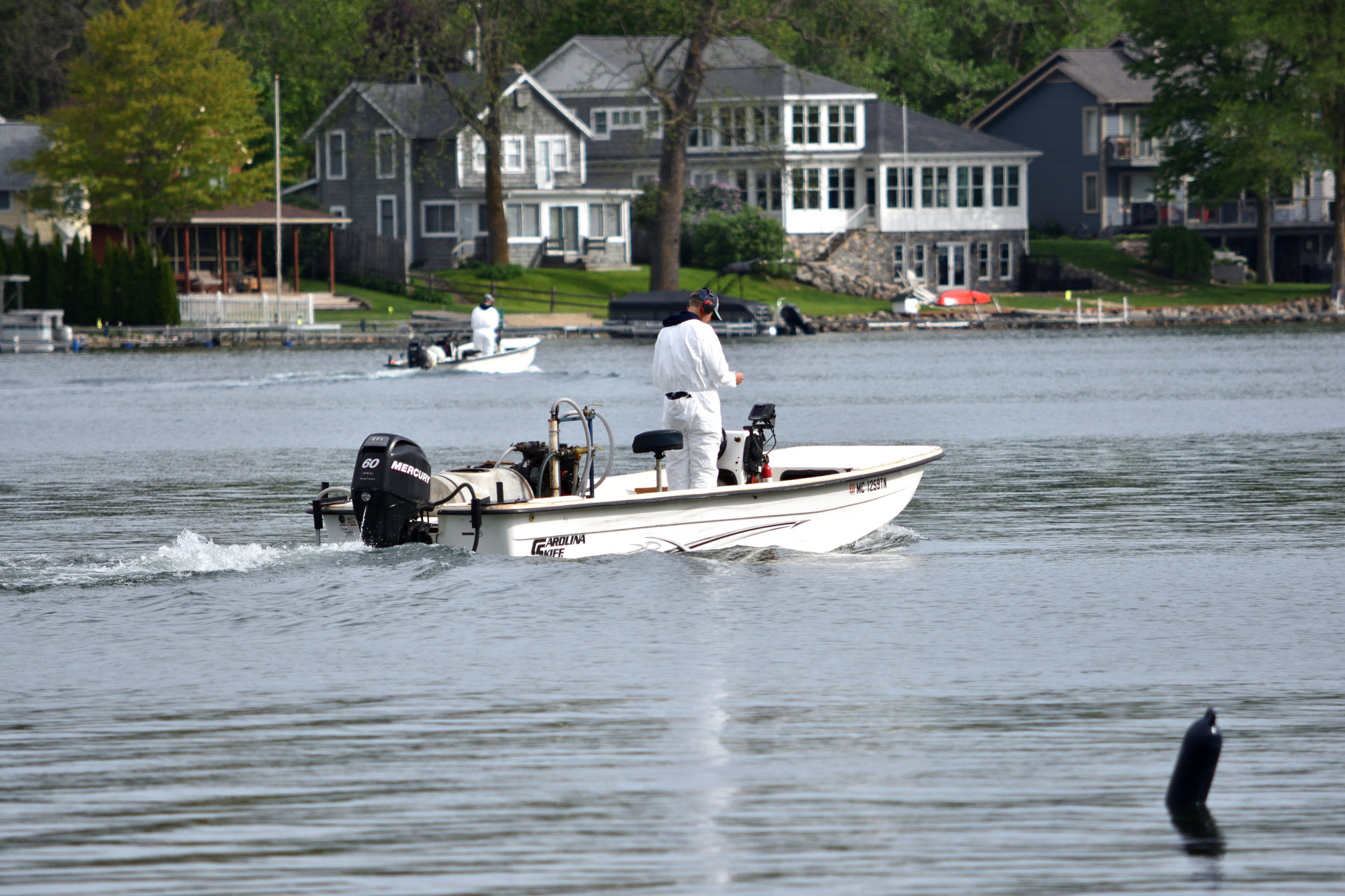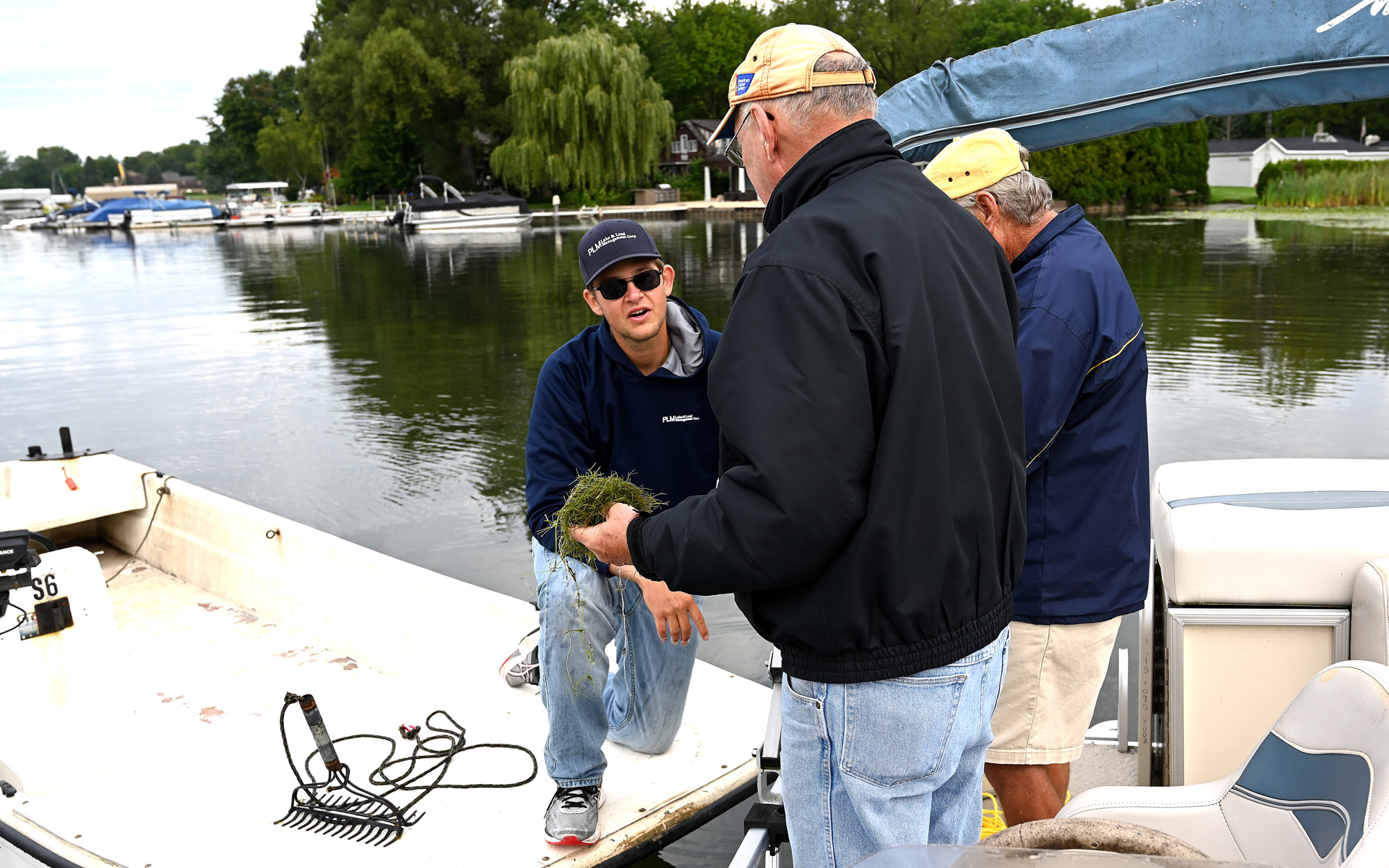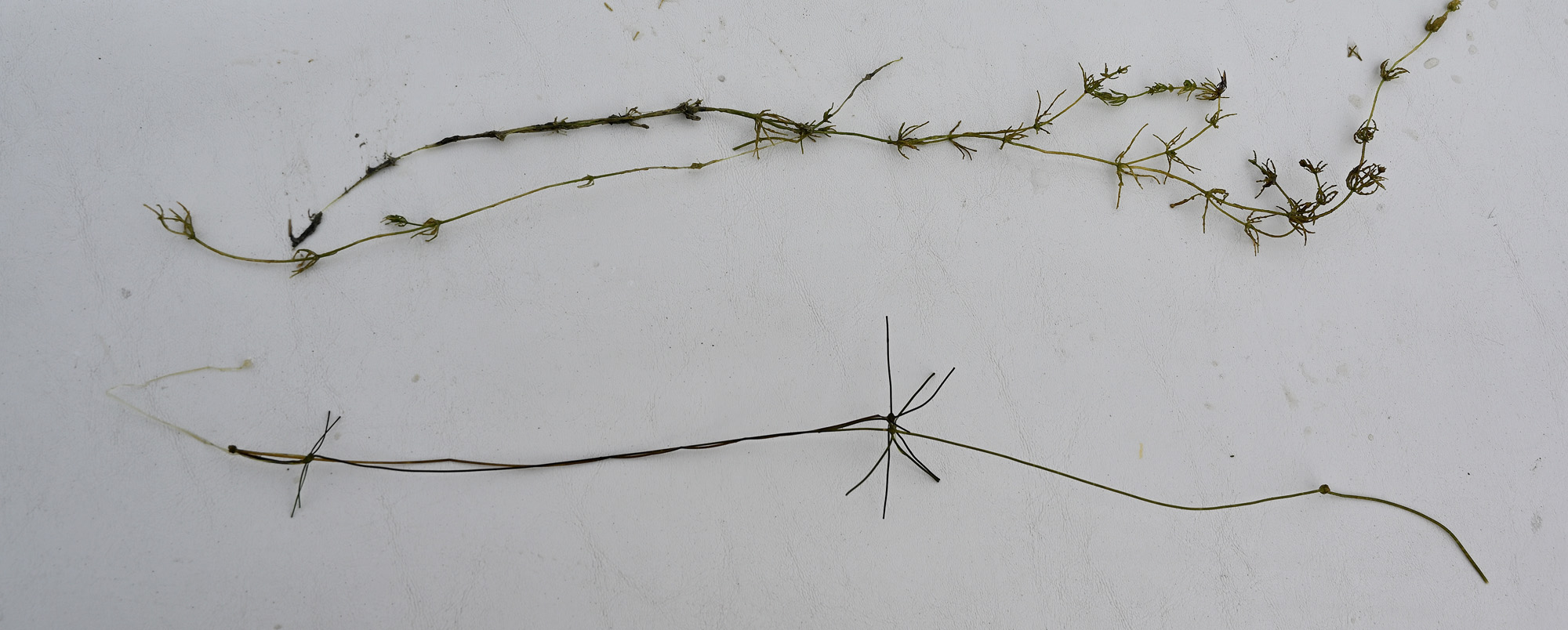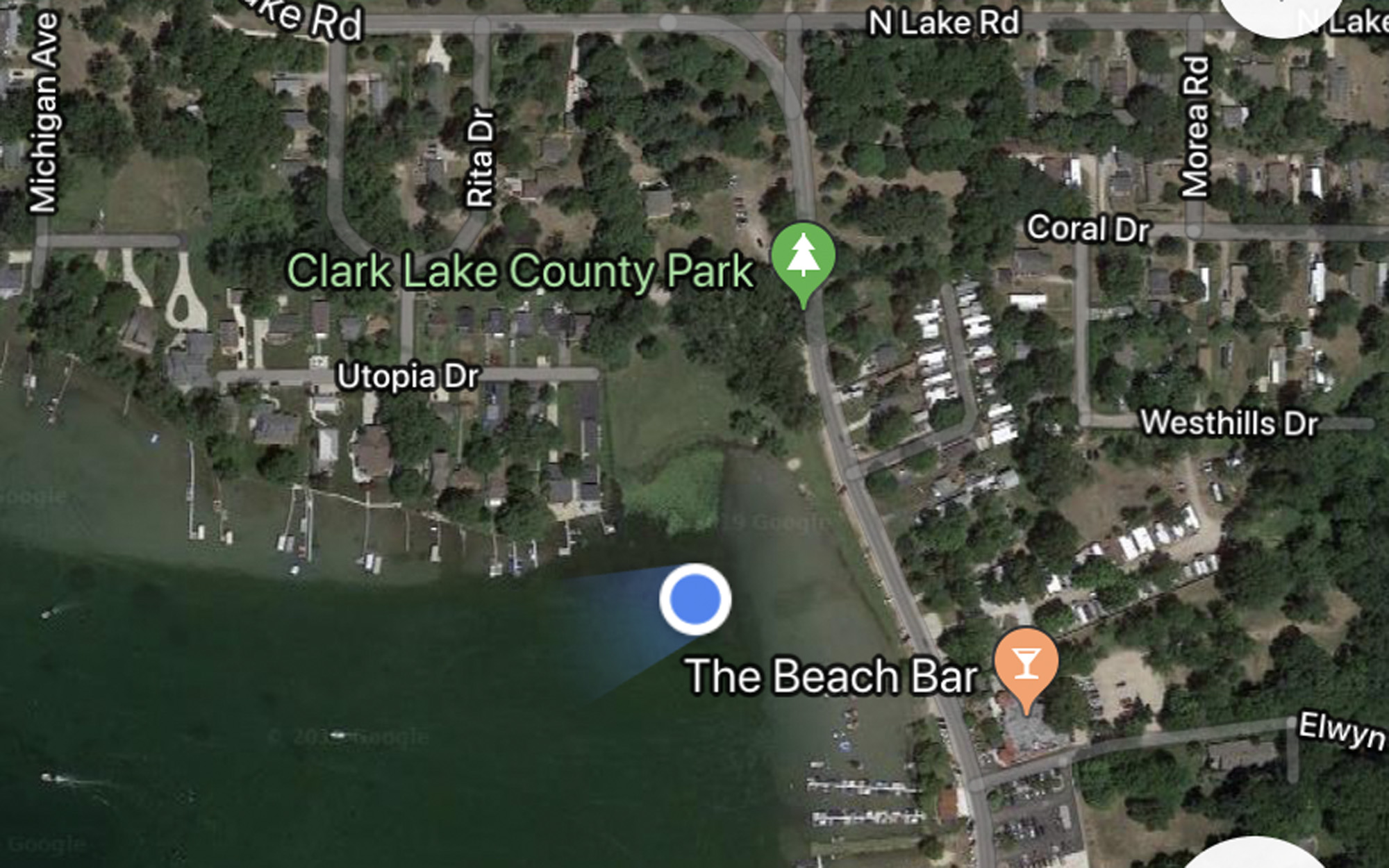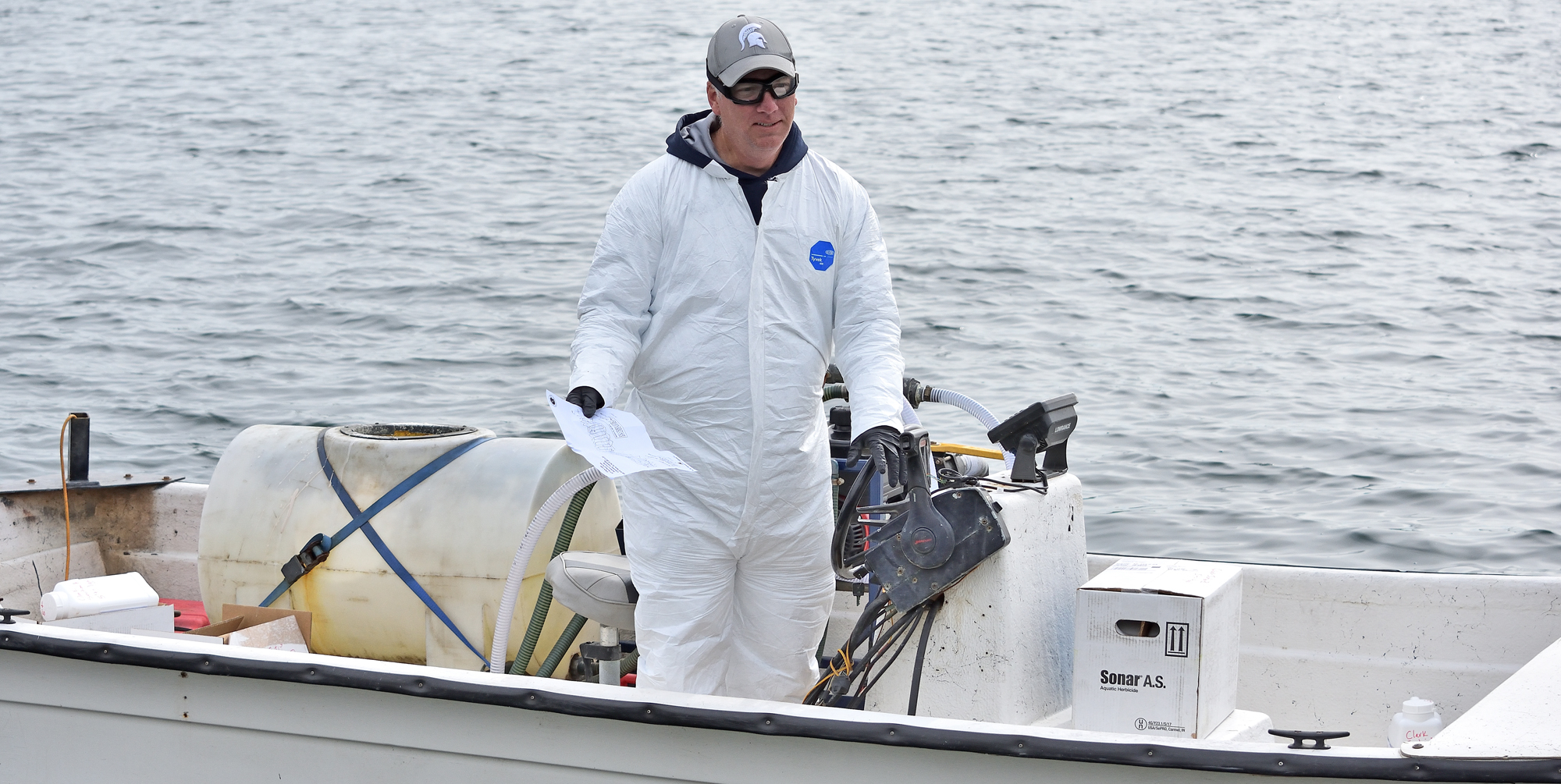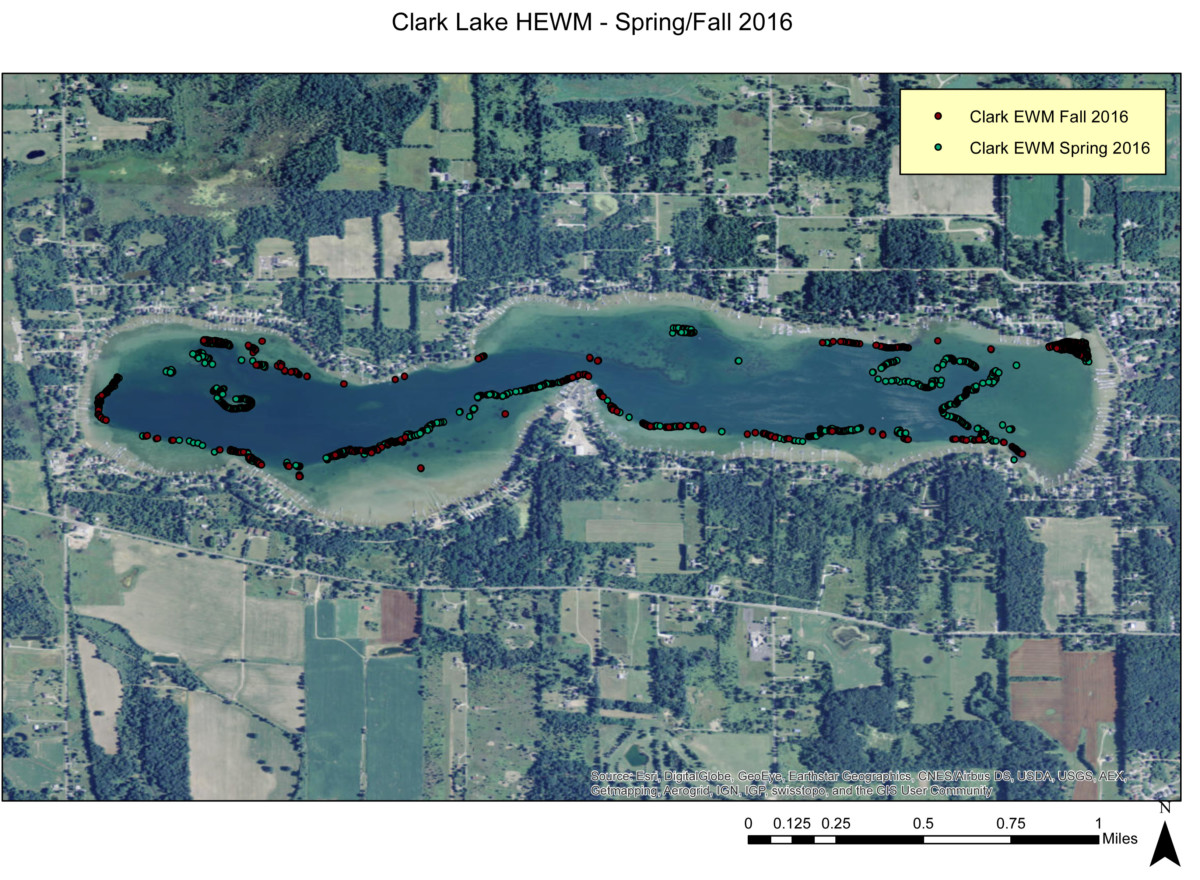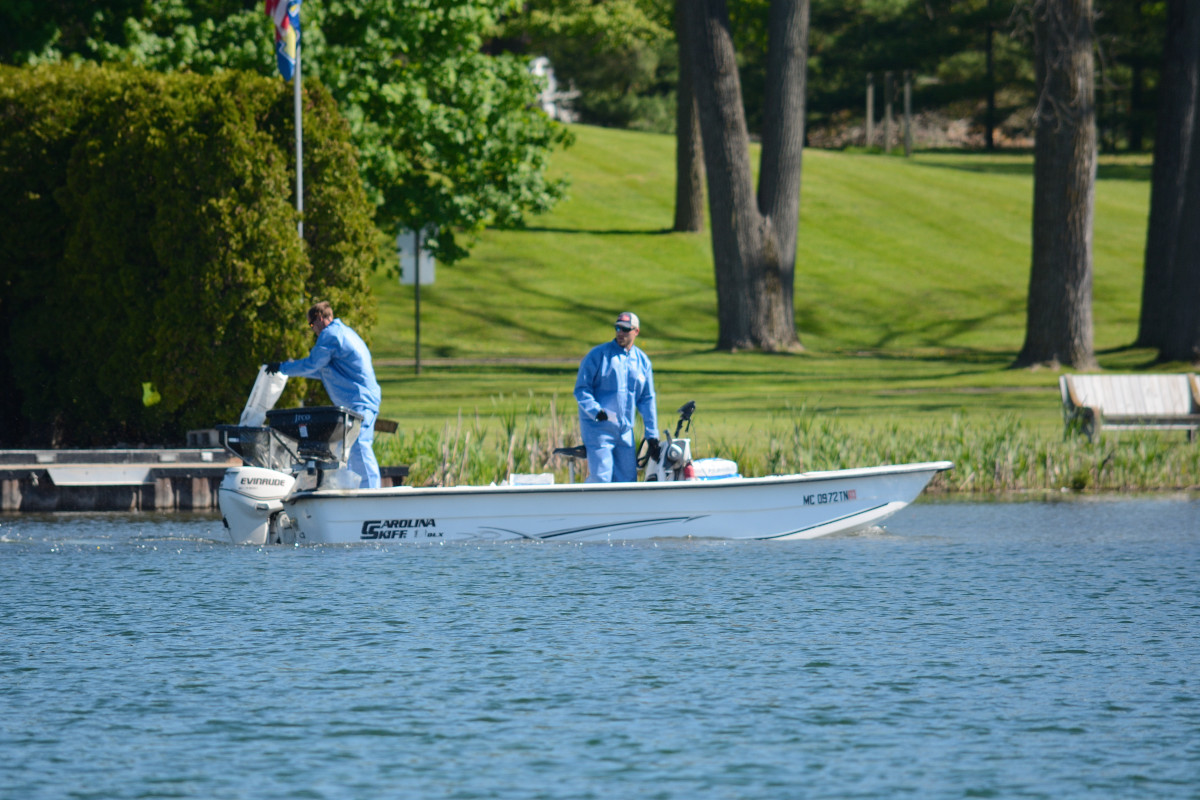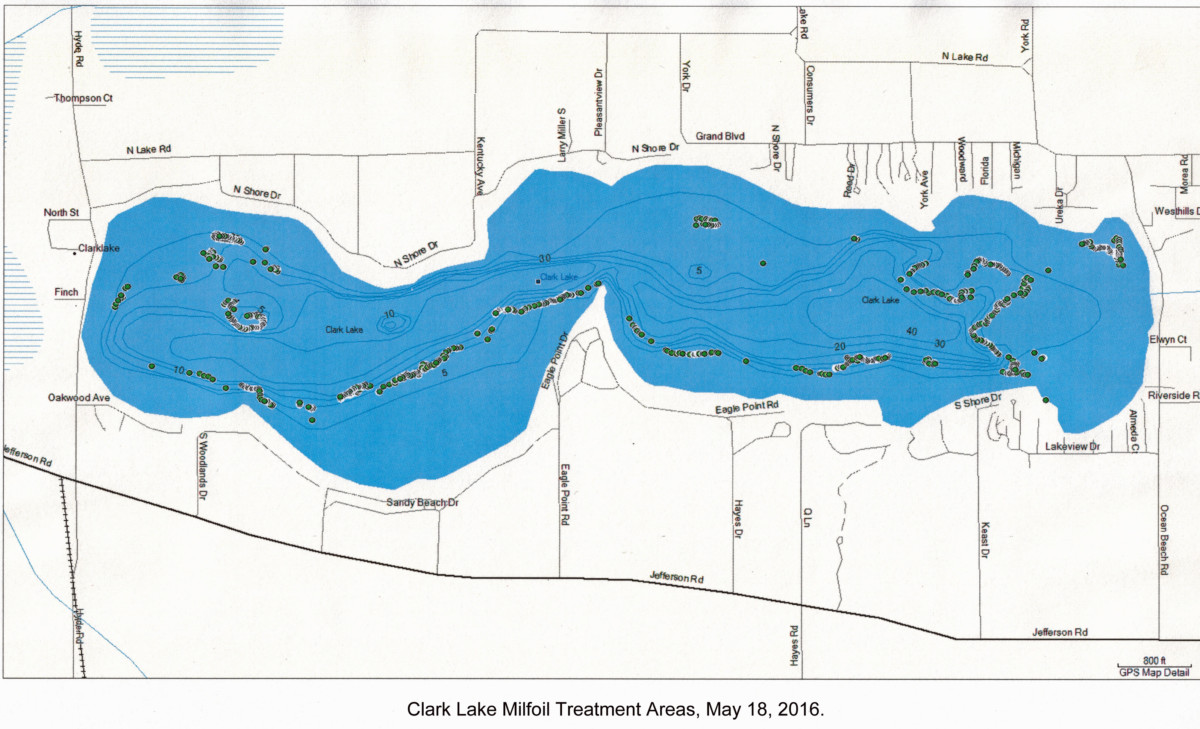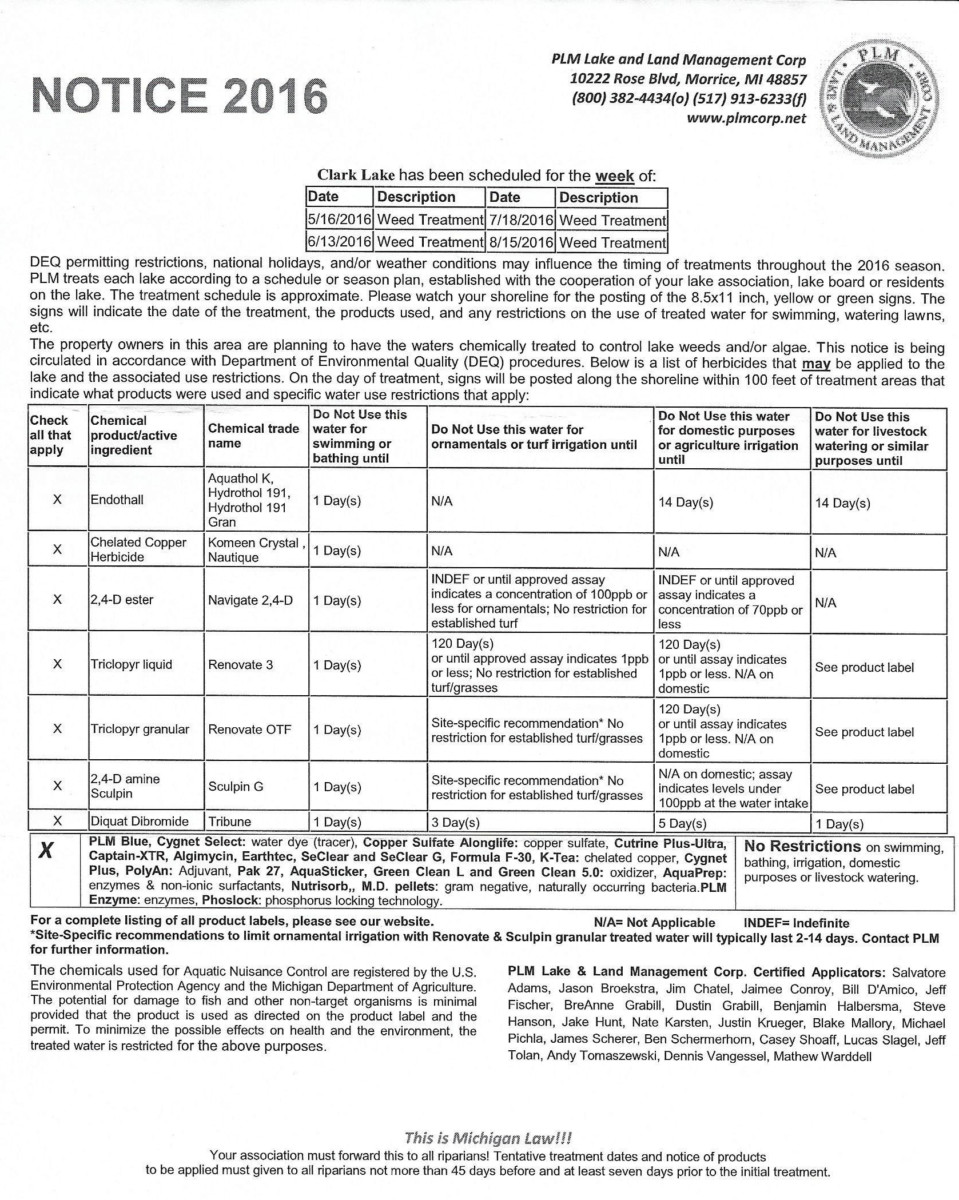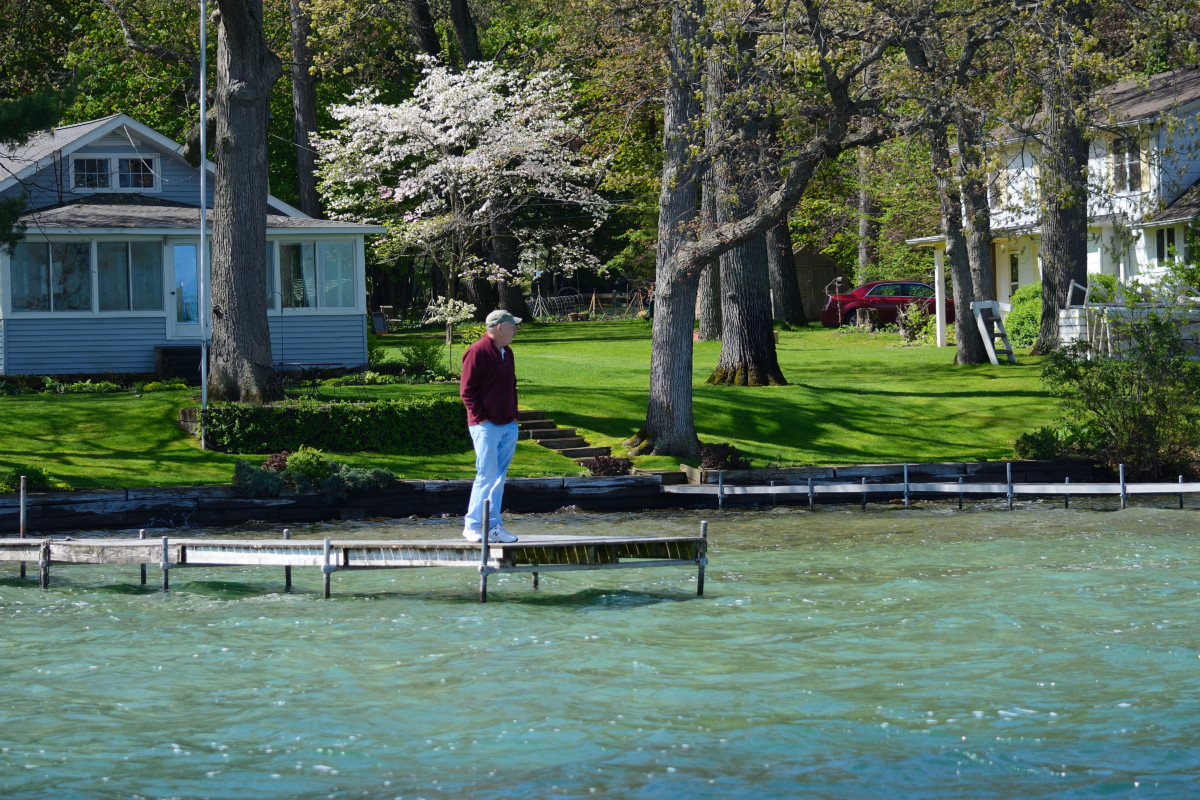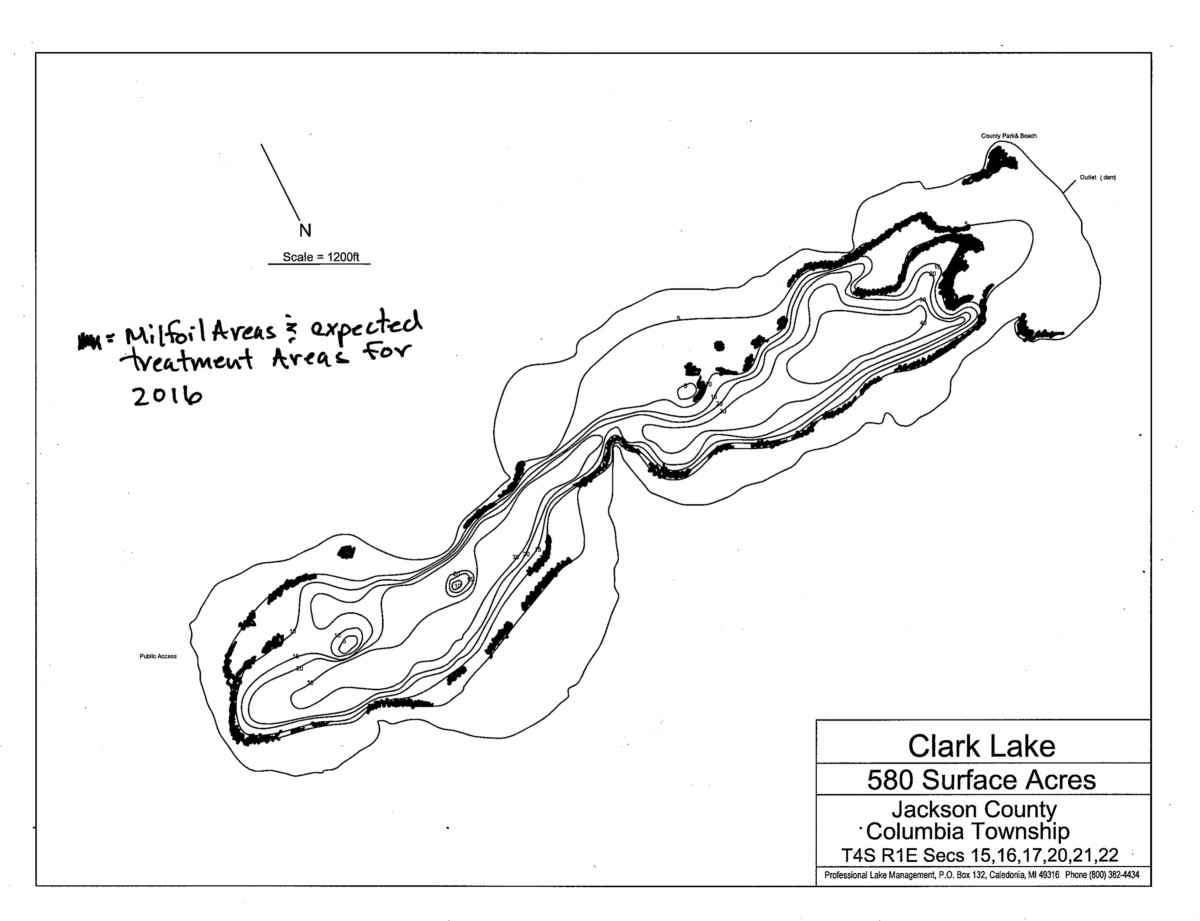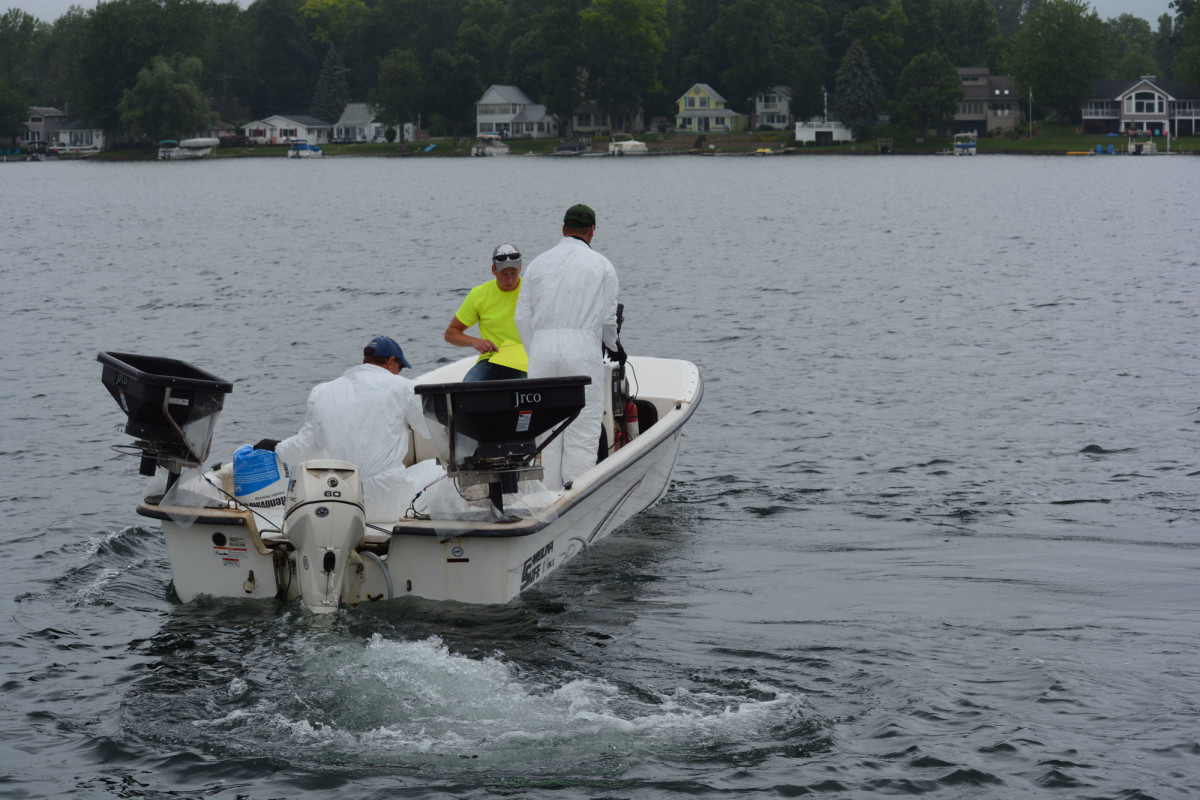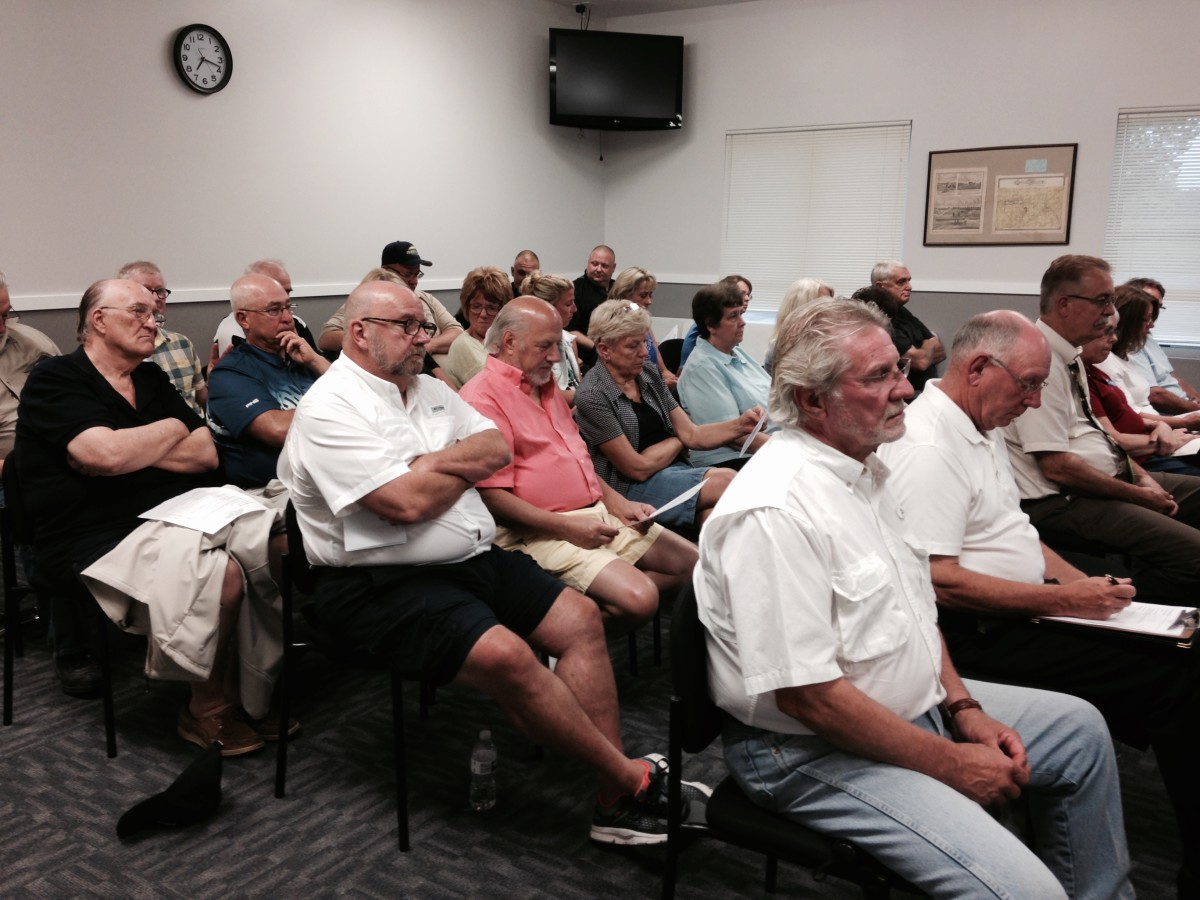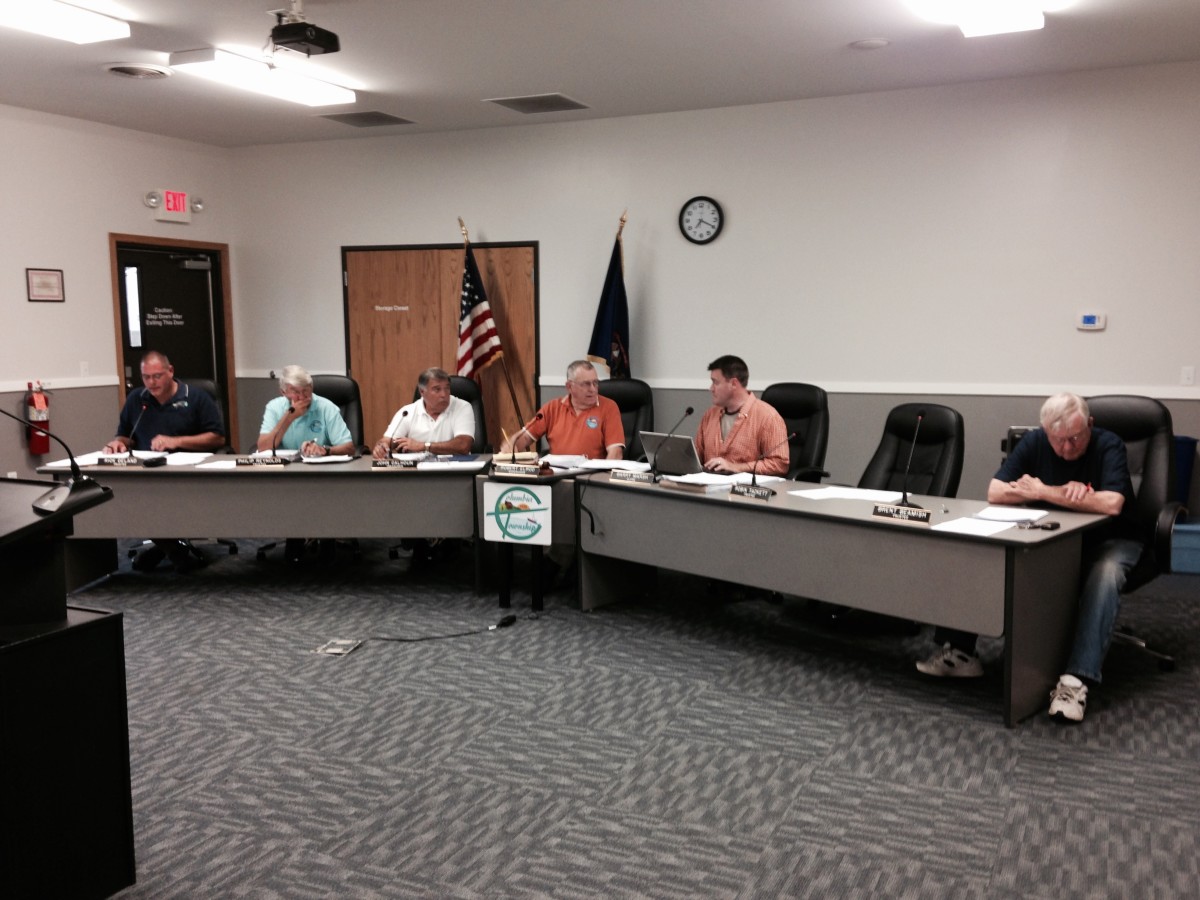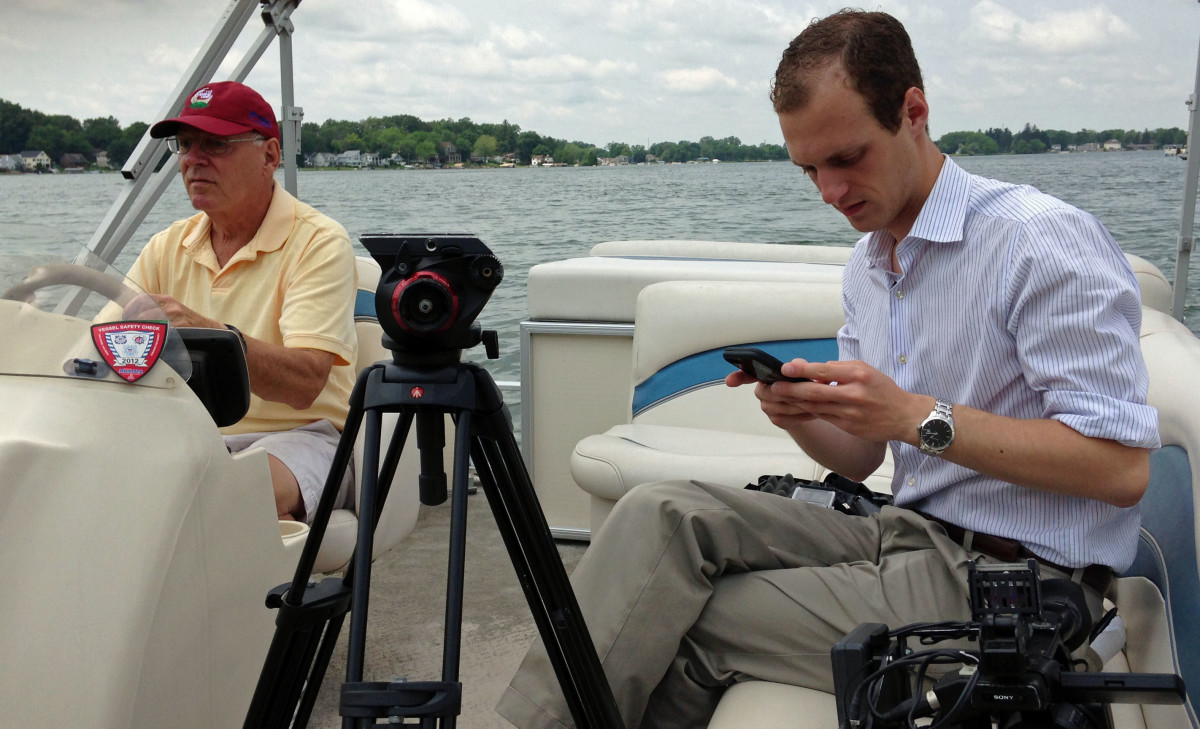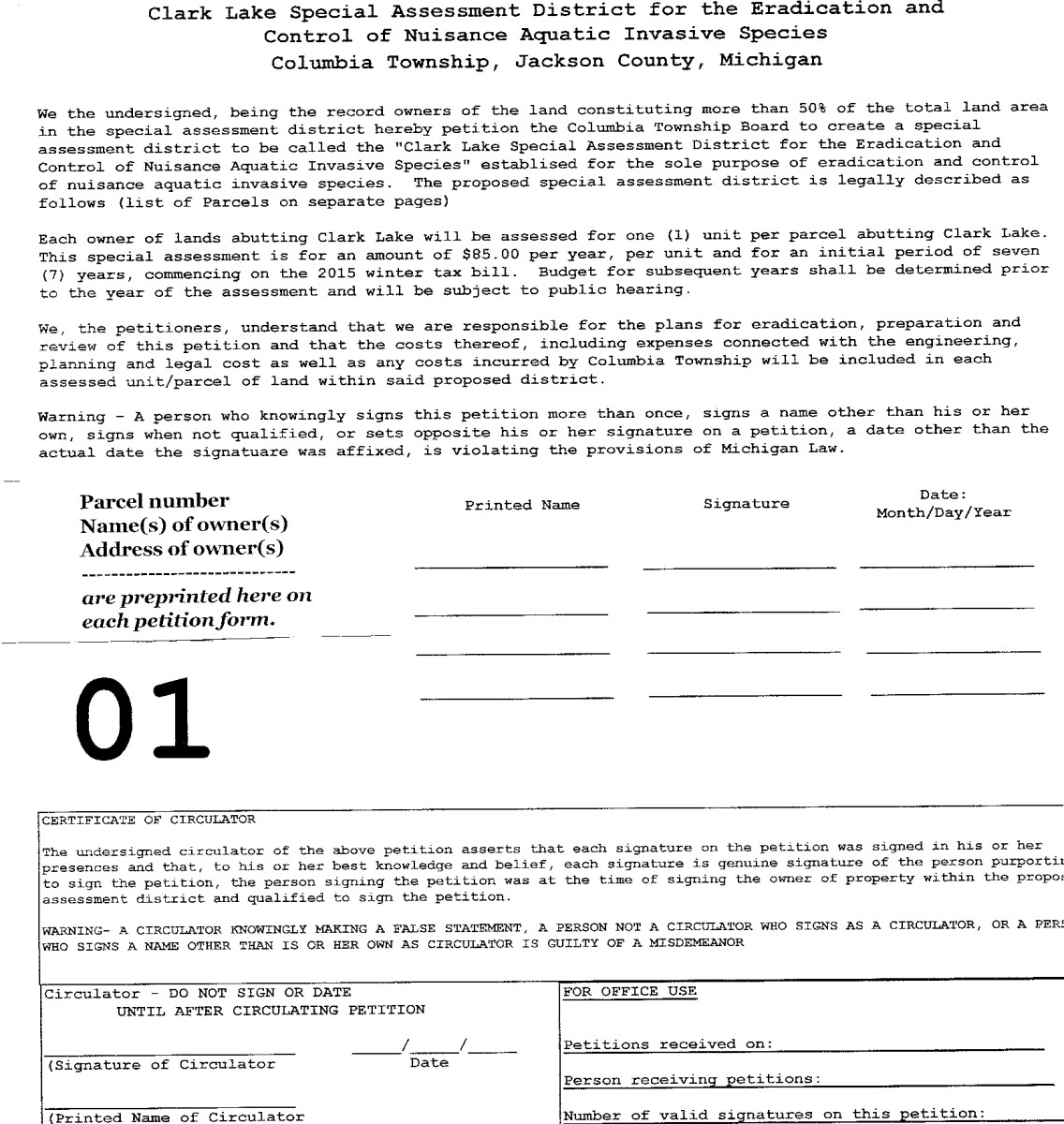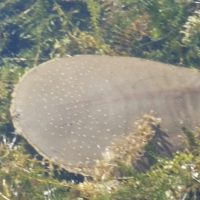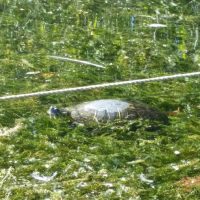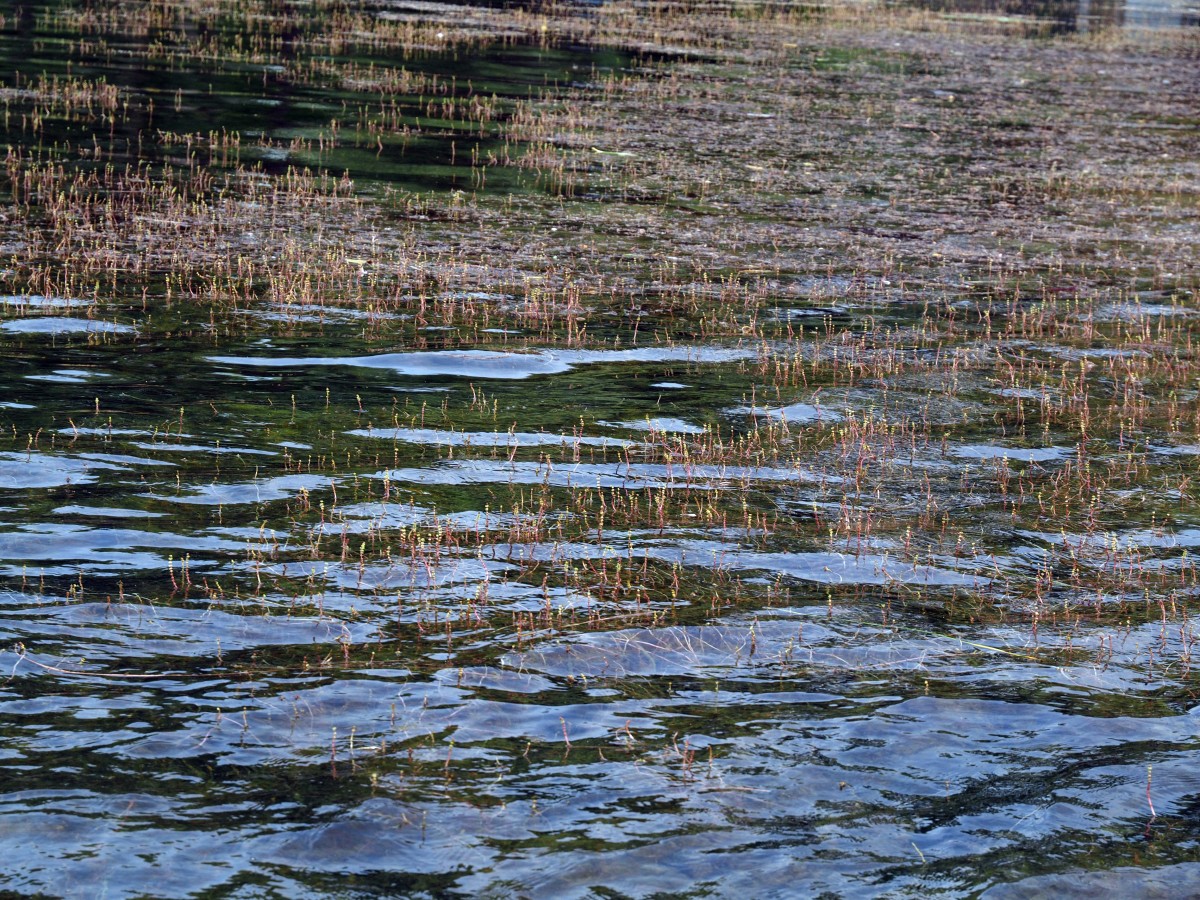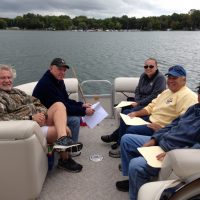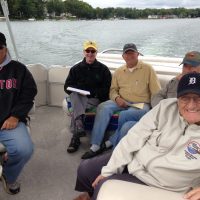Below find posts that appeared under News and Events on Clark Lake Spirit website regarding invasive weeds. Following that are links to other websites for further study.
Invasive Weeds Brochure To print this PDF, select “print both sides”, “short edge”, “auto portrait-landscape.”
Weed Update – June 16, 2022
PLM survey at Clark Lake Tuesday revealed a few areas of hybrid Eurasian water milfoil (HEWM), totaling about two acres. That’s good news as there could have been more. Clark Lake has been engaged in a battle to defend itself from this invasive species. Left alone, these weeds can take over. Lakes that didn’t act paid the price in diminished recreational uses, harm to natural habitat, and reduction in property values.

PLM expects to treat the areas next Wednesday, June 22, weather permitting. Notices will be posted.
After treatment, the defeated weeds collapse and typically sink to the bottom. Invasive or native weeds growing close to the surface can be decapitated by props and wash ashore. The products used for treatment affect only invasive weeds.
Another upbeat conclusion to the survey was the lack of Starry stonewort. None was detected where previously found—Eagle Point and near the County Park. A different treatment product was used last year, suggesting that the change increased effectiveness. Starry stonewort is actually an algae that looks much like a native weed. Like HEWM, it can also multiply quickly. Starry has become a big problem at some lakes.
To keep Clark Lake in excellent condition, vigilance is the answer. That’s the conclusion of the Invasive Species Committee, made up of fellow Clark Lake residents who live on the lake. Considering the dour alternative, this program is a win.
The special assessment district (SAD) allows for treatment wherever invasive weeds are found in Clark Lake, and provides the financial support. The SAD was recently reestablished for another 7 year period. The cost to a lakefront property owner is $59 annually, less than the previous $64 per year cost.
Weed Program Renewed – April 18, 2022
Columbia Township trustees voted unanimously tonight to renew the weed program that has successfully defended Clark Lake from invasive weeds over the last seven years. The program will be extended for another seven years. Before the vote was taken, board members held the final public hearing, one of several times Clark Lakers residents expressed their views to the elected officials. See the final hearing, and the vote, in this video.
During several meetings before the Township board that lead up to this vote, Clark Lakers stood up in support of continuing the program. In alphabetical order, they include Maris Anderson, Rick Belcher, Joe Collins, Steve Harris, Frank Hones, Blair Huff, Ron June, Beth June, Bob Lajdziak, Mike Ligibel, Roger Lyons, Kyle Main, Vic Marshall, Mike McKay, Kevin Thomson, Mick Thorrez, and Shelly Wilbur. Others submitted support in writing. The Township received no written objections. Two organizations, also comprised of Clark Lake residents, voiced their support — the Invasive Species Committee and Clark Lake Spirit Foundation. Kevin Thomson, vice-president of the Foundation and an attorney, was instrumental in the process as he worked on behalf of Clark Lake residents with the Township.
A stipulation In this new special assessment district (SAD) resolution reduces the cost to lakefront property owners to $60 from $64 annually. The resolution calls for “the amount to be assessed to each parcel shall be subject to a periodic redetermination and adjustment” each year. Further, “if there are surplus special assessment collections during the term…the Township Board may determine to use the surplus funds to pay the cost of the improvements in lieu of levying an annual assessment for that year.” Click here to read the entire resolution.
Here’s some background on how this program came to be. In 2014 Clark Lakers noticed a rapidly-growing problem. Weeds were taking over large sections of the lake. One resident described it as “an Amazon jungle lurking an inch below the surface.” If you went through an affected area, a raft ride might be delayed two or three times to clear the prop of weeds. Mounds of weeds were floating from one area of the lake to another. Residents were alarmed.
A couple Clark Lake residents took action by collecting samples, and them sending out to be analyzed. The verdict? Clark Lake was under attack by hybrid Eurasian water milfoil (HEWM). Concerned residents formed the Invasive Species Committee. Their research uncovered a troubled prognosis. A small cutting of this invasive weed multiplies exponentially. They talked to other communities and found this–lakes that didn’t take action paid a price. Weeds diminished boating, fishing, destroyed natural habitat, and property values decreased in some situations.
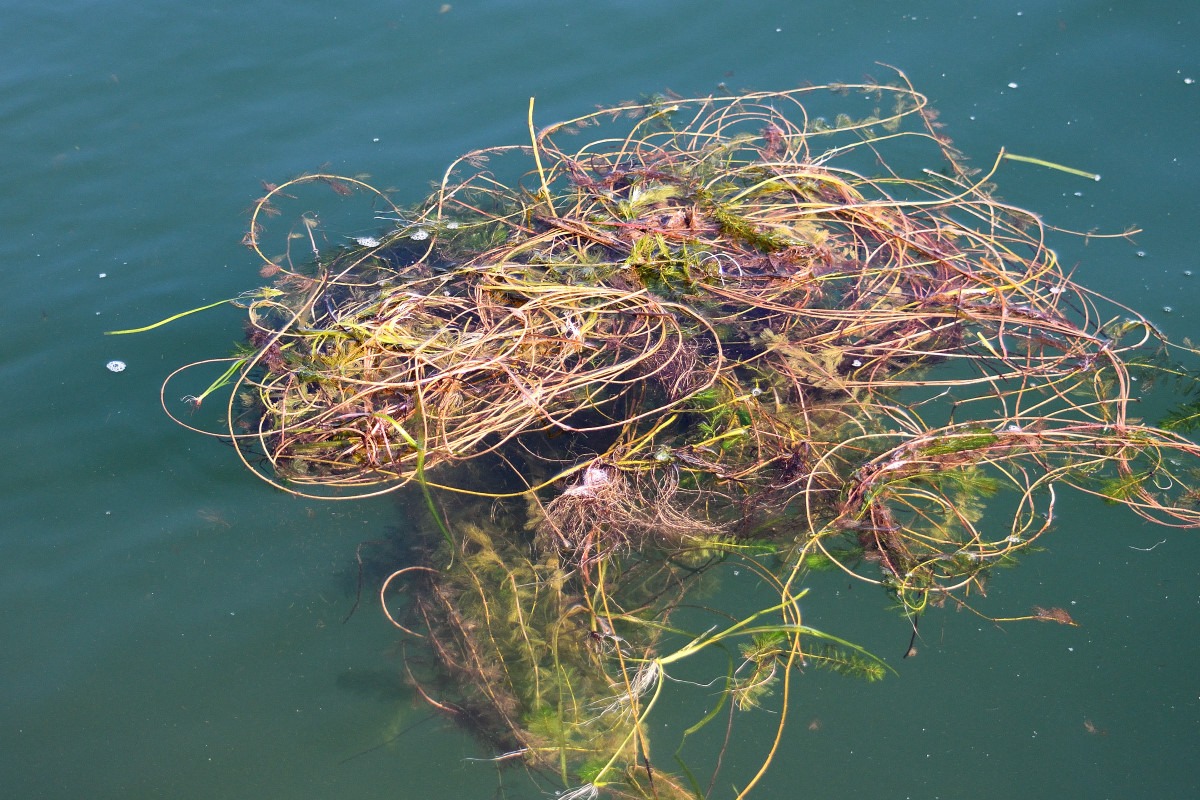
What to do? Forming a special assessment district (SAD) would allow full lake treatment and cover costs. Committee members took on a huge task, and went door to door and reached 70% of lakefront owners. They found strong support—95% signed the petition to form the SAD.
Once the program was established, early efforts achieved moderate success. The results of the 2019 full lake treatment were nothing short of spectacular. Data compiled from surveys illustrates the progress.

The chart shows the total plant cover, or general “weediness” of the lake. As the HEWM (or EWM in the chart) has decreased, this number has gone down. The reason is not necessarily because of fewer plants, but the native plant species do not grow to the density of the HEWM. The weed program only affects invasive species.
Last summer, the invader began to reappear, perhaps not a surprise given the number of boats visiting from infected lakes. The contractor, PLM, treated the specific areas that you see in this map.

Over the last couple years, a new threat appeared—starry stonewort. This algae masquerades as a weed. It can be very aggressive growing to heights of 7 feet and so dense that no person or fish could move through it. Some nearby lakes are grappling with out-of-control attacks. At Clark Lake, it has been treated at Eagle Point and in the area around the County Park.
A reasonable question is “when will it end?” Perhaps, never. Current strains are reintroduced by visiting boats, new strains can combine with existing native or hybrid plants, and a new threat could materialize at any moment.
Another question regards responsibility. Shouldn’t others who use the lake have to take precautions or pay for the treatment? In the best of worlds, the answer to both is yes. Yet, as you visit practical scenarios that would accomplish those objectives, you quickly find difficult complications. Within the perspective of another question comes its own answer. What kind of result do lakefront property owners desire? A lake with weeds under control or a lake facing a nightmarish tangled mess? Clark Lake residents had answers and expressed them. The weed program will live on for another seven years.
Weed Update – Early Summer 2021
PLM reports that it surveyed Clark Lake last week. PLM is the company contracted to detect and treat invasive species at Clark. Both Eurasian water milfoil (HEWM) and starry stonewort were found in this most recent survey. HEWM appeared near the west end boat launch, east of Mud Point, Eagle Point (east side), and the Eagle Point Cove. Both HEWM and starry stonewort were detected in the bay near the County Park.

PLM also spotted a “fair amount of native milfoil along shoreline areas that has topped out and flowered.”
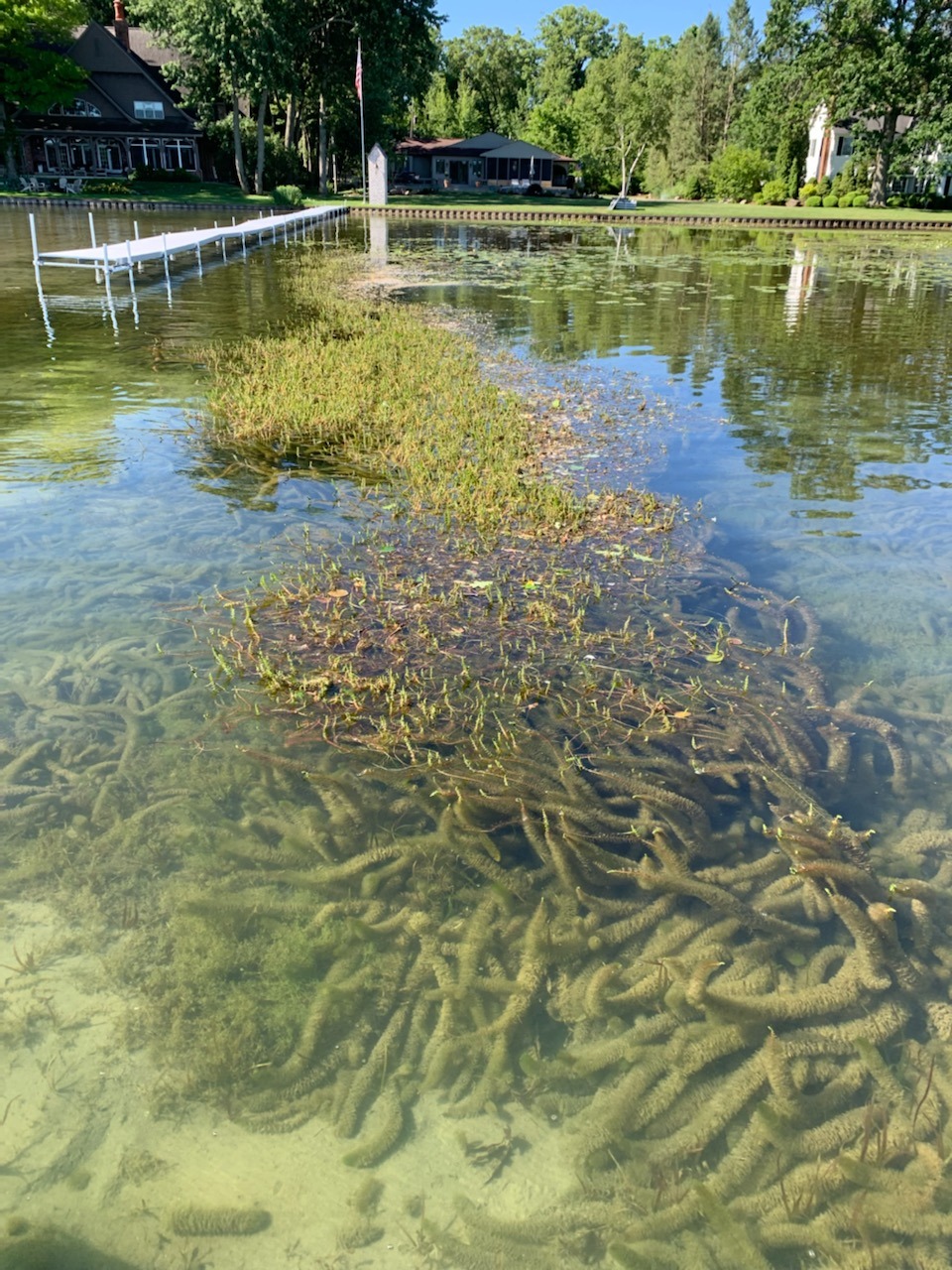
PLM indicates that this variety is “native milfoil and should recede back below the surface after it has flowered.”
PLM expects to treat the invasive varieties the week of July 19th. Notices will be given.
Lakes that didn’t control invaders found boating, fishing and other recreational uses adversely affected— and property values diminished. Clark Lake’s lakefront property owners petitioned Columbia Township to form a special assessment district (SAD) to thwart the problem.
Weed update – May 2021
Weed Checkup – July 18, 2020
PLM’s James Scherer checked up on Clark Lake’s invasive weeds Friday. Lakes that didn’t control invaders found boating, fishing and other recreational uses adversely affected— and property values diminished. Clark Lake’s lakefront property owners petitioned Columbia Township to form a special assessment district (SAD) to thwart the problem.

Last summer’s major attack on hybrid Eurasian water milfoil (HEWM) was successful. But vigilance is key to the future. The survey Friday revealed some stray HEWM, but the many large sections were not evident.
Another invader found in Clark Lake is starry stonewort. This algae has been very destructive in some lakes. Last summer, it was found in the area around the County Park. PLM treated it. This summer it had not returned in the primary area, but some of it survived near a neighboring dock. Starry was also found last summer at the Eagle Point boat launch, and Friday PLM found it was here again this summer. Once the results of the survey are compiled, it’s likely that PLM will be back to take out starry where found.
Scroll down to read more about Clark Lake’s answer to the invasive species threat.
It’s not always easy to identify HEWM, but spotting it is important. Once this invader gets a foothold, it takes major work to reverse the infestation. Below are three weeds found in Clark Lake. James Scherer points to the HEWM. The other two are native, and don’t pose the same threat.

The leaf sections of HEWM are further apart from each other.
Weed Report 2019 – January 4, 2020
This season, PLM treated Clark Lake to rid it of hybrid Eurasian watermilfoil (HEWM), an invasive species. Other lakes found that leaving HEWM infestations unchecked clogged their waters-–reducing boating, destroying wildlife habitat and diminishing property values.
PLM surveyed the lake this fall, and their report is encouraging. The treatment this spring wiped out most of the HEWM with the use of a product called Sonar. The only place HEWM could be found was at the County Park. PLM’s Steve Hanson comments the “milfoil in this area is proving to be extremely resistant to herbicides.” As a result, Steve Hanson recommends using another product next season at the County Park. He thinks ProcellaCOR will be the perfect tool. “Because of the small area and shallow water depth, the cost for ProcellaCOR will be much less than treating offshore areas.” Before making final recommendations, PLM will want to see what comes up in early summer.
Less encouraging was the discovery of Starry stonewort in the lake. It was detected, and treated, at the County Park during the season. A new area, yet to be treated, was at the Eagle Point Marina boat launch. Steve Hanson adds “Unfortunately, Starry is a macro algae and there are no systemic or long-term herbicides to treat it with. Repeated copper treatments are the best way to keep it knocked down and reduce its chance for spreading.” Past comments from PLM suggests that Starry stonewort acts differently depending on the host lake. It has made a mess of some lakes, but not others.
Starry stonewort has a similar appearance to chara a native plant also found at Clark Lake. PLM notes “Chara is a highly desired species because it is typically low growing, keeps the water clear and can slow down the invasion of exotic weed species. Starry stonewort also forms dense mats, but unlike Chara, it can grow from 5 to 7 feet tall. Starry stonewort can be very detrimental to a lake’s ecosystem and has the ability to kill off native plants and have a negative impact on a lake’s fisheries.”
What vegetation was found in Clark Lake in September 2019? This table is an excerpt from the full report, which is available as a PDF download by clicking here.
PLM recommends these steps for the coming season:
• A spring vegetation survey (to evaluate conditions in the lake and direct management efforts)
• Water quality monitoring should continue
• Early summer herbicide treatment (to control any Eurasian watermilfoil and/or Starry stonewort areas that are found)
• Mid summer herbicide treatment, if required
• Mid-summer water quality sampling
• Late summer herbicide treatment, if required
• A fall vegetation survey
• Fall water quality sampling
As part of their work, PLM also conducted a water quality test. Clark Lake’s Dr. Richard Moyer outlined the results on this website, and you can read it by clicking here.
When invasive weeds showed up in Clark Lake, the community took up the fight. Lakefront property owners petitioned Columbia Township to establish a special assessment district (SAD) so that the hybrid Eurasian water milfoil (HEWM) could be eliminated wherever found in the lake. The cost of the program is covered by lakefront owners through property tax. It appears annually as part of the winter tax.
Because of the SAD, Columbia Township is responsible for the program. By clicking here, you can read PLM’s specific proposals. It will be up to the Township board to approve them.
Scary Starry – September 13, 2019
Mounting concern over the discovery of starry stonewort in Clark Lake is motivating further investigation and treatment. PLM, the company employed to rid the lake of invasive species, has treated the area where it was first detected near the County Park. But a search for it on September 5th revealed it still lurks beneath the surface. In this photo, PLM’s James Scherer discusses findings with John Deming and Flip Reynolds.
Starry stonewort is a particularly virulent invasive species. It’s classified not as a weed, but as an algae that typically, but not always, locates in water at least 3 to 5 feet deep where temperatures are cooler. In some lakes, it spreads quickly and takes over. But not always.
Knowing what it looks like is step one in detecting and controlling it. Starry stonewort can easily be misidentified as chara, which is a native weed and doesn’t pose the same threat. Starry often has whorls of 4 to 6 branchlets, and leaves with blunt tips. Star-shaped bulbils are produced at the nodes and can reach up to 33 inches. Starry is crunchy and has nodes on its stem. Chara, a native lookalike, is scaly, brittle, and has an odor to it. In this photo, chara is at the top, and starry stonewort, at the bottom.
PLM first detected starry near the County Park where you see the blue dot.
Later in the morning James Scherer found more of it at Eagle Point the boat well adjacent to the boat launch.
In this photo is a sample of what he found at the Point.
Treatment for starry stonewort ranges from $60 to $400 per acre. It’s not surprising that the $400 Komeen treatment is more effective. It’s likely starry stonewort will continue to be a problem, and this website will continue to follow efforts to control it. For more on starry stonewort, including a video, click here.
The primary purpose of PLM’s September 5th visit was to survey the lake. Earlier this season, PLM treated the lake for hybrid Eurasian water milfoil (HEWM). A preliminary examination suggests the treatment was successful for this invasive weed. Once the report is completed, this website will post the findings.
The story of what happened to lakes that did not take action against HEWM is not good. The weed decreased recreational usage, caused ecological harm, and adversely affected property values. Lakefront property owners overwhelming supported the formation of a SAD to deal with the problem.
Weed Treatment – May 21, 2019
A PLM crew is on the lake this morning (Tuesday) installing the long-awaited treatment product. Two boats are dividing the lake’s acreage and using GPS to ensure that they have covered the area adaquately. PLM’s Steve Hanson comments “the amount of Sonar used is small compared to other products,” 6 parts per billion. “We will return later to test various parts of the lake to make sure that it finds its way to everywhere it needs to go.”
As the treatment was taking place, another PLM crew member posted signs along the shoreline.
This notice spotlights today’s activity. To get some context on the notice, please scroll below it.
Steve Hanson puts the restrictions into context, as they could be misleading. “There are actually no irrigation restrictions (except for grass seedlings) at concentrations of 10 ppb (parts per billion) or less. We are targeting 6 ppb. The grass seedling restriction goes away at 5 ppb. People will see the 30-day restriction and be concerned understandably.” He adds, “at the target concentrations there are no irrigation restrictions for established lawns or ornamentals.” Regarding the effect on fish, Steve Hanson notes “There are no restrictions regarding fishing or fish consumption associated with the use of Fluridone. Fluridone, or any herbicide permitted in Michigan, does not bio-accumulate in the fatty tissue or muscles of fish or other aquatic organisms.”
Today’s treatment was delayed until today because of this spring’s cool weather. PLM’s Steve Hanson says favorable conditions are in place today. “The lake now has a strong thermocline.” A thermocline develops when the top 10 to 20 feet of water is warmer than that which is below it. That keeps the treatment product in a spot where it can do the most good in ridding the lake of hybrid Eurasian water milfoil.
Two products listed on the original notice mailed to property owners and posted on this website are Fluridone and Triclopyr. Fluridone is expected to take out the HEWM, and the Triclopyr is on the notice in case some HEWM persists at the end of the summer. The manufacturer of the products, SePRO, will cover the cost of the Triclopyr to treat any spots if required. Copper is also on the notice of no-restriction products, and will be used if any Starry Stonewort is found. Some lakes have been overrun by Starry Stonewort. If it shows up, the best solution is to treat it quickly.
When invasive weeds showed up in Clark Lake, the community took up the fight. Lakefront property owners petitioned Columbia Township to established a special assessment district (SAD) so that the hybrid Eurasian water milfoil (HEWM) could be eliminated wherever found in the lake. Other lakes found that leaving HEWM infestations unchecked clogged their waters-–reducing boating, destroying wildlife habitat and diminishing property values.
Weed Treatment Tuesday – May 20, 2019
PLM plans to go forward with weed treatment at Clark Lake tomorrow, Tuesday, May 21. They will post a notice on lawns along the entire shoreline. This will be the same posting as mailed to lakefront property owners—and also seen below in previous and this news article. A “bump-up” treatment may occur in about three weeks.
PLM’s Steve Hanson says favorable conditions are in place. “The lake now has a strong thermocline.” A thermocline develops when the top 10 to 20 feet of water is warmer than that which is below it. That keeps the treatment product in a spot where it can do the most good in ridding the lake of hybrid Eurasian water milfoil.
Two products listed on the notice are Fluridone and Triclopyr. Fluridone is expected to take out the HEWM, and the Triclopyr is on the notice in case some HEWM persists at the end of the summer. The manufacturer of the products, SePRO, will cover the cost of the Triclopyr to treat any spots if required. Copper is also on the notice of no-restriction products, and will be used if any Starry Stonewort is found. Some lakes have been over run by Starry Stonewort. If it shows up, the best solution is to treat it quickly.
Steve Hanson puts the restrictions into context as they could be misleading. “There are actually no irrigation restrictions (except for grass seedlings) at concentrations of 10 ppb (parts per billion) or less. We are targeting 6 ppb. The grass seedling restriction goes away at 5 ppb. People will see the 30-day restriction and be concerned understandably.” He adds, “at the target concentrations there are no irrigation restrictions for established lawns or ornamentals.” Regarding the effect on fish, Steve Hanson notes “There are no restrictions regarding fishing or fish consumption associated with the use of Fluridone. Fluridone, or any herbicide permitted in Michigan, does not bio-accumulate in the fatty tissue or muscles of fish or other aquatic organisms.”
When invasive weeds showed up in Clark Lake, the community took up the fight. Lakefront property owners petitioned Columbia Township to established a special assessment district (SAD) so that the hybrid Eurasian water milfoil (HEWM) could be eliminated wherever found in the lake. Other lakes found that leaving HEWM infestations unchecked clogged their waters-–reducing boating, destroying wildlife habitat and diminishing property values.
Previous treatments at Clark Lake were accomplished through the use of Tricolpyr. Results were somewhat effective, but fell short of expectations in the judgment of Professional Lake Management (PLM), the company hired to treat the lake and measure results. Through their experience with other lakes, PLM believes Fluridone (brand name, Sonar) will be more effective and plan to use it this season.
Weed Treatment Update – May 17, 2019
PLM plans to check Clark Lake for thermocline tomorrow (Saturday) and Monday. Getting good results for the treatment depends on a pronounced thermocline—the difference in temperature of the top layer of water (10 to 20 feet) to deeper water. If conditions are favorable, the treatment could take place on Tuesday. So far, the colder weather has prevented the best conditions.
More on the thermocline. The temperature difference between the warmer surface water, and the colder deeper water, limits the exchange of material between the two layers. Steve Hanson notes “by waiting for the thermocline to develop before treatment, we can keep the majority of the product in the upper layer of water” where it will attack the hybrid Eurasian water milfoil (HEWM). That difference in temperature creates the most favorable conditions for effective treatment. The thermocline for both ends of the lake was last tested Friday, May 10.
 A notice has gone out to property owners listing the treatment products. It will be followed by a posting on lake shore properties prior to the treatment. Two products listed are Fluridone and Triclopyr. Fluridone is expected to take out the HEWM, and the Triclopyr is on the notice in case some HEWM persists at the end of the summer. The manufacturer of the products, SePRO, will cover the cost of the Triclopyr to treat any spots if required. Copper is also on the notice of no-restriction products, and will be used if any Starry Stonewort is found. Some lakes have been over run by Starry Stonewort. If it shows up, the best solution is to treat it quickly.
A notice has gone out to property owners listing the treatment products. It will be followed by a posting on lake shore properties prior to the treatment. Two products listed are Fluridone and Triclopyr. Fluridone is expected to take out the HEWM, and the Triclopyr is on the notice in case some HEWM persists at the end of the summer. The manufacturer of the products, SePRO, will cover the cost of the Triclopyr to treat any spots if required. Copper is also on the notice of no-restriction products, and will be used if any Starry Stonewort is found. Some lakes have been over run by Starry Stonewort. If it shows up, the best solution is to treat it quickly.
Steve Hanson puts the restrictions into context as they could be misleading. “There are actually no irrigation restrictions (except for grass seedlings) at concentrations of 10 ppb (parts per billion) or less. We are targeting 6 ppb. The grass seedling restriction goes away at 5 ppb. People will see the 30-day restriction and be concerned understandably.” He adds, “at the target concentrations there are no irrigation restrictions for established lawns or ornamentals.” Regarding the effect on fish, Steve Hanson notes “There are no restrictions regarding fishing or fish consumption associated with the use of Fluridone. Fluridone, or any herbicide permitted in Michigan, does not bio-accumulate in the fatty tissue or muscles of fish or other aquatic organisms.”
When invasive weeds showed up in Clark Lake, the community took up the fight. Lakefront property owners petitioned Columbia Township to established a special assessment district (SAD) so that the hybrid Eurasian water milfoil (HEWM) could be eliminated wherever found in the lake. Other lakes found that leaving HEWM infestations unchecked clogged their waters-–reducing boating, destroying wildlife habitat and diminishing property values.
Previous treatments at Clark Lake were accomplished through the use of Tricolpyr. Results were somewhat effective, but fell short of expectations in the judgment of Professional Lake Management (PLM), the company hired to treat the lake and measure results. Through their experience with other lakes, PLM believes Fluridone (brand name, Sonar) will be more effective and plan to use it this season.
Weed Treatment Delayed – May 11, 2019
Treatment of Clark Lake’s invasive weeds has been delayed again. Cooler weather is the culprit.
According to PLM’s Steve Hanson, a substantial thermocline has yet to develop. A favorable thermocline is where the top layer of water, 10 to 20 feet deep, warms more than deeper water. The temperature difference between the warmer surface water, and the colder deeper water, limits the exchange of material between the two layers. Steve Hanson notes “by waiting for the thermocline to develop before treatment, we can keep the majority of the product in the upper layer of water” where it will attack the hybrid Eurasian water milfoil (HEWM). That difference in temperature creates the most favorable conditions for effective treatment. The thermocline for both ends of the lake was last tested yesterday (Friday, May 10).
A notice has gone out to property owners listing the treatment products. It will be followed by a posting on lake shore properties prior to the treatment. Two products listed are Fluridone and Triclopyr. Fluridone is expected to take out the HEWM, and the Triclopyr is on the notice in case some HEWM persists at the end of the summer. The manufacturer of the products, SePRO, will cover the cost of the Triclopyr to treat any spots if required. Copper is also on the notice of no-restriction products, and will be used if any Starry Stonewort is found. Some lakes have been over run by Starry Stonewort. If it shows up, the best solution is to treat it quickly.
Steve Hanson puts the restrictions into context as they could be misleading. “There are actually no irrigation restrictions (except for grass seedlings) at concentrations of 10 ppb (parts per billion) or less. We are targeting 6 ppb. The grass seedling restriction goes away at 5 ppb. People will see the 30-day restriction and be concerned understandably.” He adds, “at the target concentrations there are no irrigation restrictions for established lawns or ornamentals.” Regarding the effect on fish, Steve Hanson notes “There are no restrictions regarding fishing or fish consumption associated with the use of Fluridone. Fluridone, or any herbicide permitted in Michigan, does not bio-accumulate in the fatty tissue or muscles of fish or other aquatic organisms.”
When invasive weeds showed up in Clark Lake, the community took up the fight. Lakefront property owners petitioned Columbia Township to established a special assessment district (SAD) so that the hybrid Eurasian water milfoil (HEWM) could be eliminated wherever found in the lake. Other lakes found that leaving HEWM infestations unchecked clogged their waters-–reducing boating, destroying wildlife habitat and diminishing property values.
Previous treatments at Clark Lake were accomplished through the use of Tricolpyr. Results were somewhat effective, but fell short of expectations in the judgment of Professional Lake Management (PLM), the company hired to treat the lake and measure results. Through their experience with other lakes, PLM believes Fluridone (brand name, Sonar) will be more effective and plan to use it this season.
The notice below was mailed to lakefront property owners:
Weed Treatment Likely in May – May 1, 2019
Treatment for invasive weeds will likely take place in May. According to PLM’s Steve Hanson, he anticipates treatment the week of May 13th.
The treatment will occur when PLM detects optimal conditions, which are weather dependent. They will look for a pronounced thermocline. This is where a layer of warmer water develops in the top 10 to 20 feet. The temperature difference between the warmer surface water, and the colder deeper water, limits the exchange of material between the two layers. PLM’s Steve Hanson notes “by waiting for the thermocline to develop before treatment, we can keep the majority of the product in the upper layer of water” where it will attack the HEWM. He adds PLM has checked for thermocline, but the weather has been windy and cool. The next check will take place toward the end of next week.
A notice has gone out to property owners listing the treatment products. It will be followed by a posting on lake shore properties prior to the treatment. Two products listed are Fluridone and Triclopyr. Fluridone is expected to take out the HEWM, and the Triclopyr is on the notice in case some HEWM persists at the end of the summer. The manufacturer of the products, SePRO, will cover the cost of the Triclopyr to treat any spots if required. Copper is also on the notice of no-restriction products, and will be used if any Starry Stonewort is found. Some lakes have been over run by Starry Stonewort. If it shows up, the best solution is to treat it quickly.
About the restrictions, Steve Hanson offers these thoughts, as they could be misleading. “There are actually no irrigation restrictions (except for grass seedlings) at concentrations of 10 ppb or less. We are targeting 6 ppb. The grass seedling restriction goes away at 5 ppb. People will see the 30-day restriction and be concerned understandably.” He adds, “at the target concentrations there are no irrigation restrictions for established lawns or ornamentals.” Regarding the effect on fish, Steve Hanson notes “There are no restrictions regarding fishing or fish consumption associated with the use of Fluridone. Fluridone, or any herbicide permitted in Michigan, does not bio-accumulate in the fatty tissue or muscles of fish or other aquatic organisms.”
When invasive weeds showed up in Clark Lake, the community took up the fight. Lakefront property owners petitioned Columbia Township to established a special assessment district (SAD) so that the hybrid Eurasian water milfoil (HEWM) could be eliminated wherever found in the lake. Other lakes found that leaving HEWM infestations unchecked clogged their waters-–reducing boating, destroying wildlife habitat and diminishing property values.
Previous treatments at Clark Lake were accomplished through the use of Tricolpyr. Results were somewhat effective, but fell short of expectations in the judgment of Professional Lake Management (PLM), the company hired to treat the lake and measure results. Through their experience with other lakes, PLM believes Fluridone (brand name, Sonar) will be more effective and plan to use it this season.
The notice below was mailed to lakefront property owners:
Invasive Weed Battle Resumes – April 8, 2019
When invasive weeds showed up in Clark Lake, the community took up the fight. Lakefront property owners petitioned Columbia Township to established a special assessment district (SAD) so that the hybrid Eurasian water milfoil (HEWM) could be eliminated wherever found in the lake. Other lakes found that leaving HEWM infestations unchecked clogged their waters-–reducing boating, destroying wildlife habitat and diminishing property values.
Previous treatments at Clark Lake were accomplished through the use of Tricolpyr. Results were somewhat effective, but fell short of expectations in the judgment of Professional Lake Management (PLM), the company hired to treat the lake and measure results. Through their experience with other lakes, PLM believes Fluridone (brand name, Sonar) will be more effective and plan to use it this season.
The treatment will occur when PLM detects optimal conditions, which are dependent on weather. They will check for a pronounced thermocline. This is where a layer of warmer water develops in the top 10 to 20 feet. The temperature difference between the warmer surface water, and the colder deeper water, limits the exchange of material between the two layers. PLM’s Steve Hanson notes “by waiting for the thermocline to develop before treatment, we can keep the majority of the product in the upper layer of water” where it will attack the HEWM.
A notice will go out to property owners listing the treatment products. It will be followed by a posting on lake shore properties prior to the treatment. Two products listed are Fluridone and Triclopyr. Fluridone is expected to take out the HEWM, and the Triclopyr is on the notice in case some HEWM persists at the end of the summer. The manufacturer of the products, SePRO, will cover the cost of the Triclopyr to treat any spots if required. Copper is also on the notice of no-restriction products, and will be used if any Starry Stonewort is found. Some lakes have been over run by Starry Stonewort. If it shows up, the best solution is to treat it quickly.
About the restrictions, Steve Hanson offers these thoughts, as they could be misleading. “There are actually no irrigation restrictions (except for grass seedlings) at concentrations of 10 ppb or less. We are targeting 6 ppb. The grass seedling restriction goes away at 5 ppb. People will see the 30-day restriction and be concerned understandably.” He adds, “at the target concentrations there are no irrigation restrictions for established lawns or ornamentals.”
Township Confirms New Weed Treatment – December 17, 2018
The Township Board of Trustees tonight said “yes” to a new weed treatment to thwart invasive hybrid Eurasian water milfoil now present in Clark Lake. When hybrid Eurasian water milfoil (HEWM) became a threat, lake front owners petitioned Columbia Township to create a special assessment district to deal with it. Why? Other lakes found that leaving HEWM infestations unchecked clogged their waters-–reducing recreational opportunities, destroying wildlife habitat and diminishing property values.
Clark Lake’s initial treatment under the SAD was with a granular product called Renovate OTF. It was applied over about 30 acres in spots where HEWM was found and had significant results. But it didn’t have the complete effect of tamping down invasive weed growth. Because of that, PLM, the company doing the treatment, put treatment on hold while they sought a better solution. PLM believes that Fluridone (Sonar) is the best next step.
In this video, because the program was on hold, Township Treasurer John Calhoun explains that funds from Clark Lake’s SAD are sufficient to pay for the new treatment. John Calhoun then makes a motion, to go forward with the program, supported by Rick Deland. At the conclusion of this video is bonus footage. Flip Reynold brought trustees up to date about a proposed Michigan law that would direct the DNR to grant money to lakes to stop the spread of invasive weeds. Click here for more details on this ongoing story.
In this video from, you’ll see Steve Hanson explain why he believes Sonar is the way to go.
State May Support Weed War – December 13, 2018
A bill passed by the Michigan Senate proposes the Michigan DEQ help eradicate invasive weeds in public lakes. If also passed by the Michigan house, and signed into law by the governor, this could bolster Clark Lake’s war on hybrid Eurasian water milfoil (HEWM). When HEWM became a threat here, lake front owners petitioned Columbia Township to create a special assessment district to deal with it. Why? Other lakes found that leaving HEWM infestations unchecked clogged their waters–reducing recreational opportunities, destroying wildlife habitat and diminishing property values.
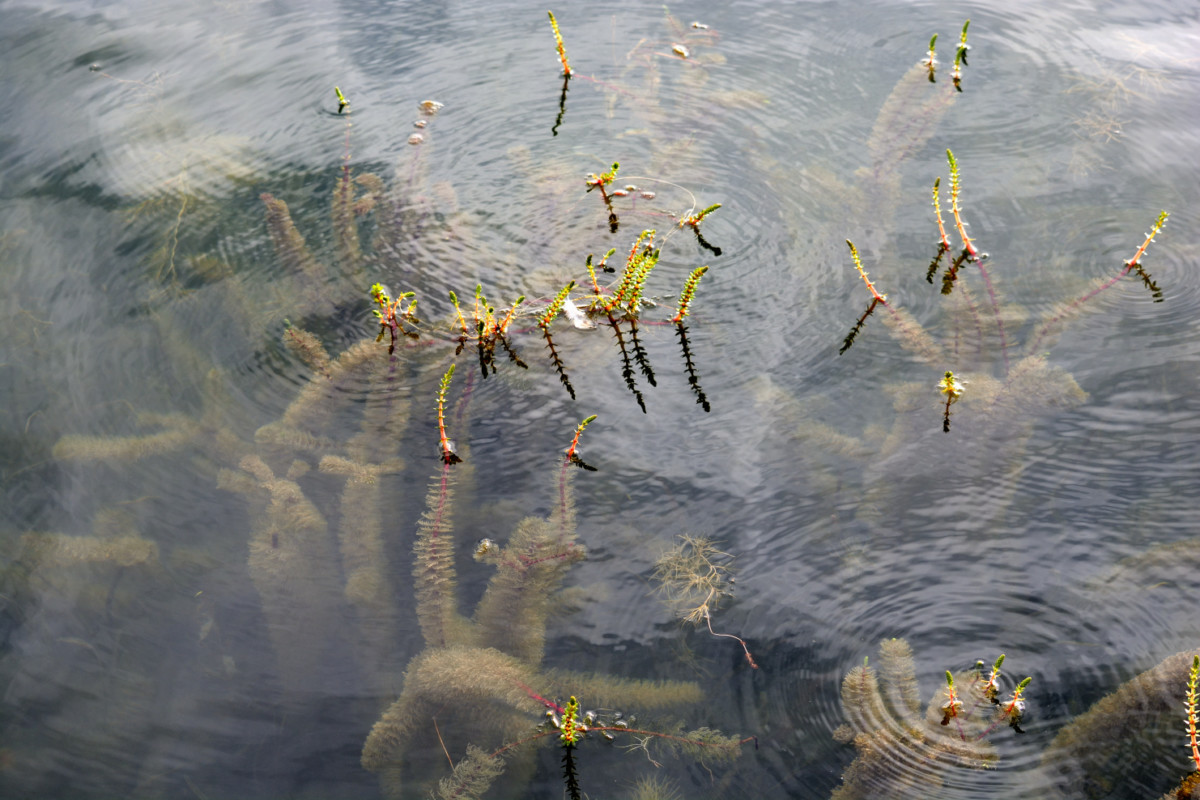 The cost of treatment is currently borne by lakefront property owners and is annually is part of the winter property tax. This new bill would require the DEQ to provide grants to eligible applicants to control the invasive species. Clark Lake’s special assessment district (SAD) would likely qualify, meaning less burden on Clark Lake’s lakefront owners.
The cost of treatment is currently borne by lakefront property owners and is annually is part of the winter property tax. This new bill would require the DEQ to provide grants to eligible applicants to control the invasive species. Clark Lake’s special assessment district (SAD) would likely qualify, meaning less burden on Clark Lake’s lakefront owners.
John Calhoun, a Clark Lake resident who is also Township Treasurer, has urged passage of the Senate bill. Speaking as a resident, he wrote Representative Brett Roberts “Due to the fast spreading Eurasian Milfoil, local lake property owners have had the burden of ridding the lakes of the invasive species through special assessments and various treatment and harvesting methods. I think it’s time the state takes some of the burden off of the local municipalities and shares in the protection of inland waters.”
John Deming, chairman of Clark Lake’s Invasive Species Committee adds “the state needs to step up to the threat because they are the regulatory authority for water and environmental quality.” He urges residents to contact those at the capitol who will be making the decision, including Representative Roberts. Clark Lake resident Flip Reynolds suggests contacting Representative Dan Lauwers at (517) 373-1790, requesting “that Bill 1136 be put on the agenda for the 3rd reading and a voted upon ASAP this term.”
Learn more about the war against invasive weeds at Clark Lake by clicking here.
Click here to read a copy of the Senate bill.
Weeds and Weed – November 19, 2018
The Columbia Township board dealt with both kinds tonight–invasive weeds in Clark Lake, and the kind, now legal, that some will light up.
The board unanimously voted to opt out of allowing the sale and distribution of marijuana anywhere in Columbia Township. Don’t expect to see a headshop in Brooklyn or somewhere around the lake. Possession will be permitted, but selling will not.
The prescription for treating invasive weeds in Clark Lake has taken a new turn. When hybrid Eurasian water milfoil (HEWM) became a threat, lake front owners petitioned Columbia Township to create a special assessment district to deal with it. Why? Other lakes found that leaving HEWM infestations unchecked clogged their waters–reducing recreational opportunities, destroying wildlife habitat and diminishing property values. Clark Lake’s initial treatment under the SAD was with a granular product called Renovate OTF. It was applied over about 30 acres in spots where HEWM was found. It had a significant effect. But it didn’t have the desired lasting power. Because of that, PLM, the company doing the treatment, put treatment on hold while they sought a better solution. With Renovate aside, they next turned to a new product–Procellacor. Because of Clark Lake’s depth and other considerations, this didn’t add up to a good fit either. PLM believes that Fluridone (Sonar) is the best next step. PLM’s Steve Hanson explains why in this video.
[youtube]https://youtu.be/R4u4tINEVjw[/youtube]
Treatment would likely take place in late April or early May. Steve Hanson notes PLM will “post a 30-day irrigation restriction by law, but at applied concentrations there will be no irrigation restrictions for lawns or ornamentals. The only irrigation restriction that may apply for a limited time is for seedling grasses. There will be a one-day swimming restriction on the day of application, and no fishing or other water use restrictions.”
The cost of treatment is in the $70,000 range. Because there has been only one full lake treatment since the beginning of the SAD, enough money has been collected to cover the expense.
Michigan lakes have been hit by another invader–starry stonewort. This algae has created havoc in some lakes, but so far has not been spotted in Clark Lake. Trustee Flip Reynolds quizzed Steve Hanson about this threat.
Still photos by Paul Skawinski and Scott Brown. Click here for more on starry stonewort.
Invasive Weeds – May 2018
by John Deming
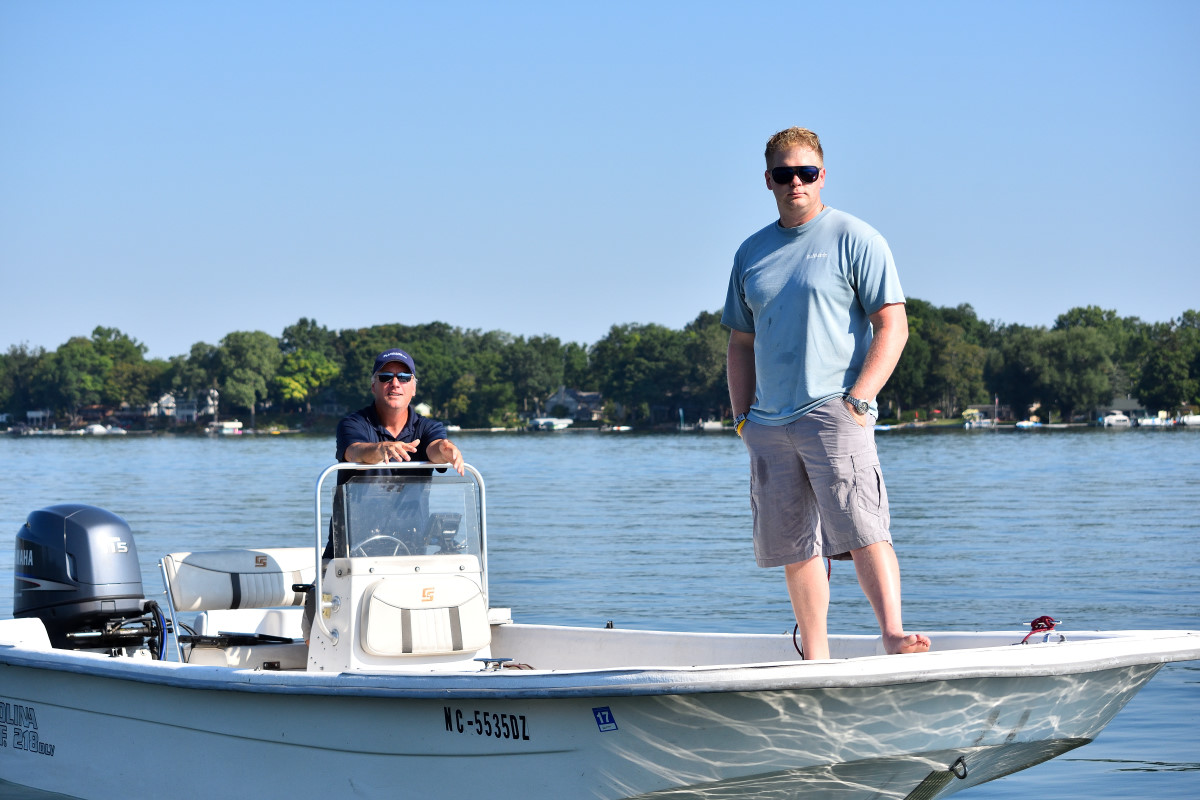 Spring has finally arrived and with its arrival comes the regeneration of our weed problem. The treatment plan that is currently under consideration is for the use of a new herbicide, Procellacor. Procellacor has been approved by the federal government and is currently under review by Michigan’s DNR/DEQ. It is anticipated that sometime this year, probably late summer, the approval for its use will be received. When approved and depending on the timing of the approval, the new herbicide may be used to treat our weed problem yet this year. This website will actively follow the approval process and provide you with the latest information.
Spring has finally arrived and with its arrival comes the regeneration of our weed problem. The treatment plan that is currently under consideration is for the use of a new herbicide, Procellacor. Procellacor has been approved by the federal government and is currently under review by Michigan’s DNR/DEQ. It is anticipated that sometime this year, probably late summer, the approval for its use will be received. When approved and depending on the timing of the approval, the new herbicide may be used to treat our weed problem yet this year. This website will actively follow the approval process and provide you with the latest information.
The invasive species problem continues to evolve not only with newly developed treatment options, but with the type of invasive species that we are facing. Our weed problem has changed and with that change a new approach is required.
What we have not discussed is how to prevent invasive species from entering our lake. Without a concerted effort to prevent invasive species from entering our lake, we will continue to react after the unwanted invasive specie is discovered. As far as I know, the property owners will be the only party that will be impacted financially by being asked to solve the problem by paying for a treatment or allowing the invasive specie to destroy property values. The source of most, if not all invasive species, is by the transportation of an invasive specie by a watercraft from an infected body of water to our lake. The transportation can take place in the bilge water or a small particle of a weed attached to the bunk of a trailer. A majority of the watercraft at our lake never leave the lake to visit an infected body of water. Therefore, they are not the source of our problem. We need to discuss the problem of how to prevent the infected watercraft from entering our lake. The discussion needs to include all five launch site operators and potentially the DNR/DEQ. We can either begin the discussion and be proactive or wait for the next invasive specie to gain a foothold. The next invasive specie may be more costly than our current one. You can contact me, John Deming, either by phone 517-529-9117 or by email at jcdcl@comcast.net.
Invasive Weeds at Clark Lake – August 1, 2017
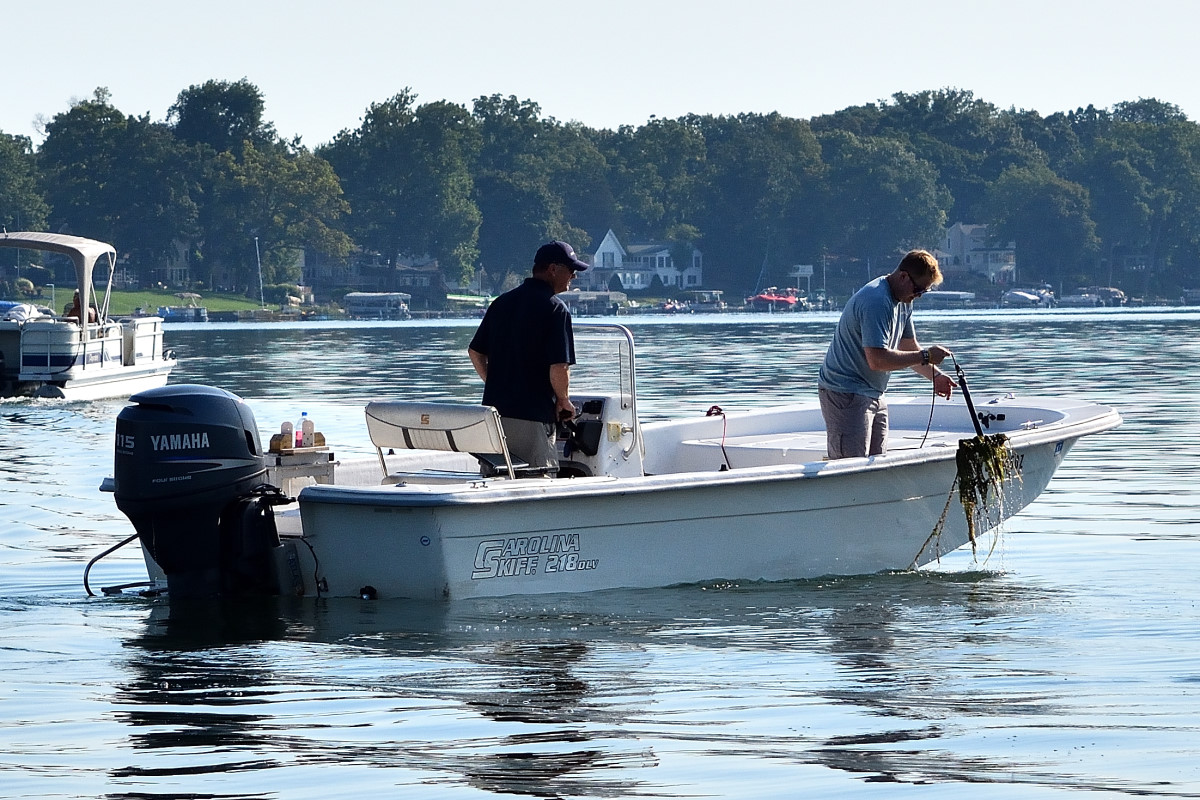
Representatives from Professional Lake Management (PLM) and SePro surveyed the lake this morning. PLM’s Steven Hanson and SePro’s J.T. Gravelie examined weed samples to determine the best course of treatment to thwart hybrid Eurasian water milfoil or HEWM.
 This invasive species multiplies quickly and is notorious for taking over lakes. It curtails recreational uses such as boating and fishing, destroys wildlife habitat and impairs navigation. Lakes that stood idly by watched property values plunge.
This invasive species multiplies quickly and is notorious for taking over lakes. It curtails recreational uses such as boating and fishing, destroys wildlife habitat and impairs navigation. Lakes that stood idly by watched property values plunge.
Ninety-five percent of lake front property owners contacted by the Invasive Species Committee signed a petition asking for action. As a result, Columbia Township formed a special assessment district (SAD) that allows treatment anywhere HEWM exists in the lake and supports the cost through property taxes.
Key takeaways
- PLM and product manufacturer SePro believe a new product called Procellacor shows great promise, and the study today was designed to investigate its potential here. In 2016, the lake was treated with Renovate (active ingredient triclopyr). Initial results were good, but near the end of the season, HEWM regrowth was detected. For an explanation on the challenge, please scroll down the last paragraph.
- Procellacor acts both as a systemic and on contact. After a few weeks, the invasive plants collapse. Renovate worked differently. It caused the plants to experience sudden, explosive growth, and then the weed would collapse on itself.
- Procellacor is getting favorable test results elsewhere. Samples taken today, and more samples to be taken late in August or September, will be tested in the lab to determine efficacy.
- EPA approval of Procellacor is expected soon. That will be followed by Michigan DEQ approval process. How quickly could Clark Lake be treated? J.T. Gravelie says the optimistic answer is “mid-summer 2018.” More realistically, he said “it will probably be 2019”.
- PLM has not treated the lake this summer. When asked about the current state of the lake, Steve Hanson said it “looks better than expected.” He opined “there is less HEWM in the lake than before treatment began, and that, of course, is favorable.” But further Renovate treatment was deemed wasteful if a product like Procellacor is on the horizon.
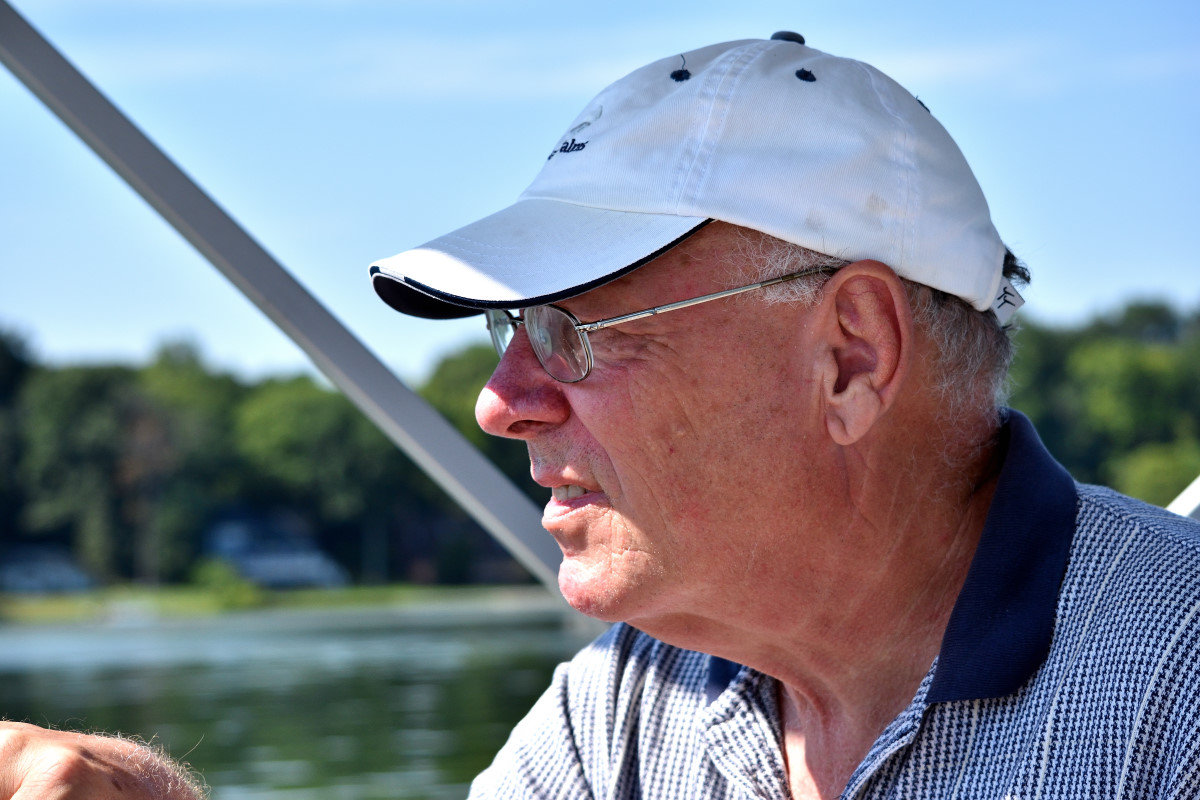
John Deming and Rick Belcher, on a nearby raft, watched progress and discussed the issues with Steve Hanson and J. T. Gravelie.
John Deming, chairman of the Clark Lake Invasive Species Committee, says “I like that PLM and SePro are approaching this problem in a scientific manner.” He also noted that “PLM could treat every year, take the money and run. Instead they are doing their due diligence, customizing the approach for Clark Lake, and not wasting our money.” John Deming added “some areas of the lake where we saw HEWM two years ago are now devoid of it. So some progress had been made.”
Comments from Township trustees present–Bob Elrod, John Calhoun and Flip Reynolds–indicated that tax moneys collected this year could be rolled into future years. Fewer treatments with a more effective product could reduce the overall costs of this program.
What’s the challenge in thwarting an invasive plant like HEWM? PLM also treats other lakes in our region, and they have found each lake to be individual. Take, for example, this chain reaction when Eurasian milfoil enters a lake. The invader mates with the native plant. The resulting hybrid mates with other hybrids and native plants. Or varieties of hybrids travel from lake to lake by boat or other means. Darwinian evolution implies improved sustainability and thus, a greater opportunity to procreate, and become immune to threats like treatment programs. Take that cycle through several iterations, and you can see the challenge in knocking off an invasive species.
To read more about this program, please click here.

Trustee Flip Reynolds, Supervisor Bob Elrod, and Treasurer John Calhoun also watched the survey from close by, and questioned Steven Hanson and J. T. Gravelie on their findings and recommendations.
War on Weeds Update – July 18, 2017
PLM, the company treating Clark Lake’s invasive weed invasion, will be here at the lake on August 3rd. Steve Hanson of PLM, and a representative of SePRO, will survey the lake and collect additional information about our situation. SePRO provides products to tame or eliminate invasive species. According to Steve Hanson, SePRO has “been very good at providing a guarantee of control if they are involved in the project development.”
PLM also treats other lakes in our region, and they have found each lake to be individual. Take, for example, this chain reaction when Eurasian milfoil enters a lake. The invader mates with the native plant. The resulting hybrid mates with other hybrids and native plants. Or varieties of hybrids travel from lake to lake by boat or other means. Darwinian evolution implies improved sustainability and thus, a greater opportunity to procreate, and become immune to threats like treatment programs. Take that cycle through several iterations, and you can see the challenge in knocking off an invasive species.
During the 2016 season, PLM treated about 30 acres of HEWM with a product called Renovate (active ingredient, triclopyr). According to PLM’s Steve Hanson “initial results were good, but follow up surveys indicated regrowth of HEWM by summer’s end.” Steve noted “these results were concerning to me, as I expected our treatments to have at least season-long effects, if not multiple years.”
Based the upcoming August 3rd survey, SePRO may recommend a different product like Sonar, or a new product. “This new product,” says Steve Hanson, “is currently being tested in Michigan.” It’s not known if it will be approved, nor is pricing available.
Clark Lake declared war on the advance of the invasive weed–hybrid Eurasian water milfoil (HEWM). Why? Where left unchecked, HEWM can diminish recreational use of a lake, destroy wildlife habitat, and negatively affect property values. A majority of Clark Lake lakefront property owners petitioned Columbia Township to establish a special assessment district (SAD) to deal with the problem. The SAD allows treatment of HEWM wherever it exists in the lake and covers the cost of the project through the property taxes of lakefront landowners.
Township Board Gets a Weed Update – May 15, 2017
Clark Lake has declared war on the advance of hybrid Eurasian water milfoil (HEWM). Why? Where left unchecked, HEWM can diminish recreational use of a lake, destroy wildlife habitat, and negatively affect property values. A majority of Clark Lake lakefront property owners petitioned Columbia Township to establish a special assessment district (SAD) to deal with the problem. The SAD allows treatment of HEWM wherever it exists in the lake and covers the cost of the project through the property taxes of lakefront landowners.
PLM Lake & Land Management (PLM) has been contracted to treat Clark Lake. At tonight’s meeting of the Columbia Township board, Trustee Flip Reynolds and Treasurer John Calhoun, both Clark Lake residents, discussed the state of the battle. In their presentation to the board, John Calhoun and Flip Reynolds described the challenge–Clark Lake’s version of HEWM has not been permanently eradicated by the current product (Renovate). That has lead PLM to look into other solutions from Sepro, a company that develops treatment products, including a new one called Procellacor. In this video, John Calhoun starts by reading an email from PLM’s Steve Hanson. Flip Reynolds then follows up.
To understand the challenge, a chain reaction can happen when Eurasian milfoil enters a lake. The invader mates with the native plant. The resulting hybrid mates with other hybrids and native plants. Or varieties of hybrids travel from lake to lake by boat or other means. Darwinian evolution results in improved sustainability and thus, a greater opportunity to procreate, and become immune to threats like treatment programs. Take that cycle through several iterations, and you can see the challenge in knocking off an invasive species.
 During the 2016 season, PLM treated about 30 acres of HEWM with Renovate (active ingredient, triclopyr). According to PLM’s Steve Hanson, “initial results were good, but follow up surveys indicated regrowth of HEWM by summers end.” Steve noted “these results were concerning to me, as I expected our treatments to have at least season-long effects, if not multiple years.”
During the 2016 season, PLM treated about 30 acres of HEWM with Renovate (active ingredient, triclopyr). According to PLM’s Steve Hanson, “initial results were good, but follow up surveys indicated regrowth of HEWM by summers end.” Steve noted “these results were concerning to me, as I expected our treatments to have at least season-long effects, if not multiple years.”
At the Township meeting (and in the video), John Calhoun referred to a study performed by Sepro. To focus treatment on Clark Lake’s version of HEWM, samples were sent to lab for testing. The Clark Lake plants were exposed to three herbicides—triclopyr, 2,4-D, and Fluridone. The lab reported the Clark Lake samples were not susceptible to 2,4-D. Some samples were somewhat vulnerable to triclopyr, while others were not affected. The labs results showed all Clark Lake HEWM samples were susceptible to Fluridone, a more expensive product.
Steven Hanson concludes “it is not prudent to continue the triclopyr treatment.” As noted in the video, PLM suggests a new entry into the field, Procellacor, has promise. Logistical issues prevent its use in 2017, among them the state hasn’t approved it yet. With only four acres of treatment anticipated in 2017, the “savings” could be applied to a more effective program in 2018.
As more information becomes available, expect updates on this website.
Invasive Weed Update – April 19, 2017
Clark Lake has declared war on the advance of hybrid Eurasian water milfoil (HEWM). Why? Where left unchecked, HEWM can diminish recreational use of a lake, destroy wildlife habitat, and negatively affect property values. A majority of Clark Lake lakefront property owners petitioned Columbia Township to establish a special assessment district (SAD) to deal with the problem. The SAD allows treatment of HEWM wherever it exists in the lake and covers the cost of the project through the property taxes of lakefront landowners.
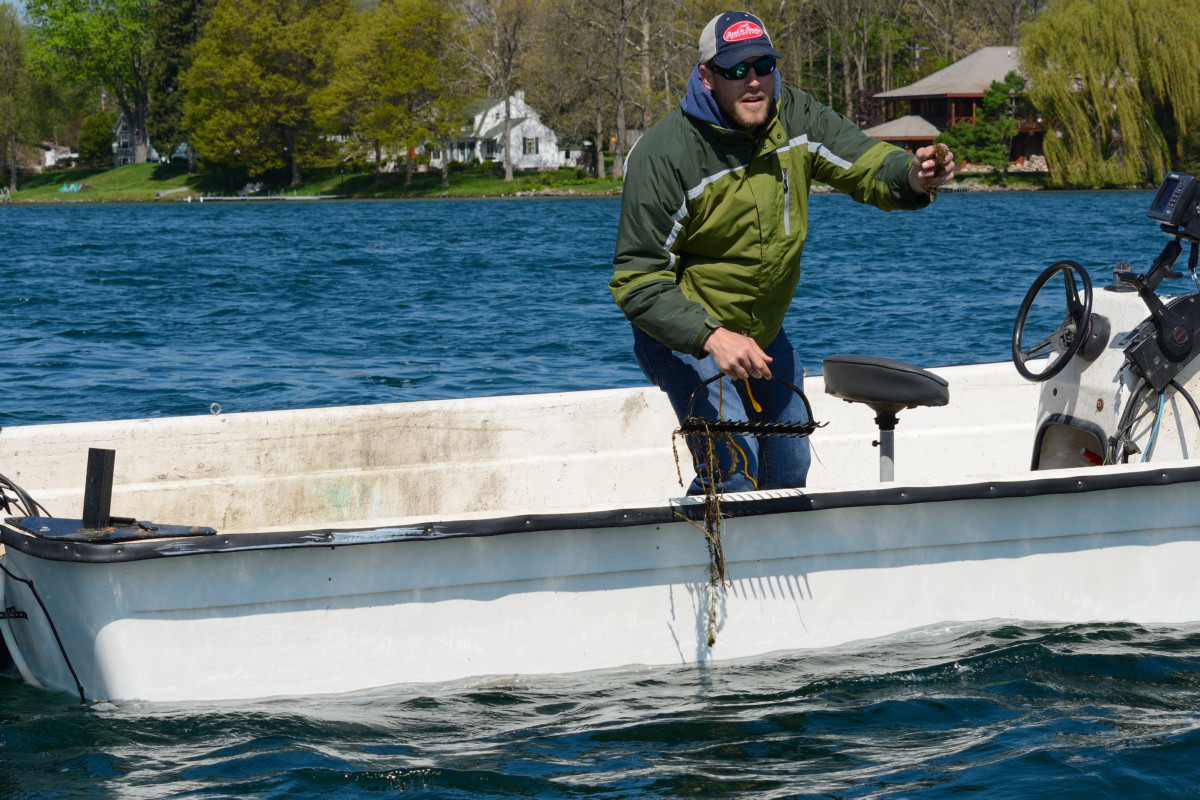 PLM Lake & Land Management (PLM) has been contracted to treat Clark Lake. It also treats other lakes in our region, and they have found each lake to be individual. Take, for example, this chain reaction when Eurasian milfoil enters a lake. The invader mates with the native plant. The resulting hybrid mates with other hybrids and native plants. Or varieties of hybrids travel from lake to lake by boat or other means. Darwinian evolution results in improved sustainability and thus, a greater opportunity to procreate, and become immune to threats like treatment programs. Take that cycle through several iterations, and you can see the challenge in knocking off an invasive species.
PLM Lake & Land Management (PLM) has been contracted to treat Clark Lake. It also treats other lakes in our region, and they have found each lake to be individual. Take, for example, this chain reaction when Eurasian milfoil enters a lake. The invader mates with the native plant. The resulting hybrid mates with other hybrids and native plants. Or varieties of hybrids travel from lake to lake by boat or other means. Darwinian evolution results in improved sustainability and thus, a greater opportunity to procreate, and become immune to threats like treatment programs. Take that cycle through several iterations, and you can see the challenge in knocking off an invasive species.
During the 2016 season, PLM treated about 30 acres of HEWM with a product called Renovate (active ingredient, triclopyr). According to PLM’s Steve Hanson “initial results were good, but follow up surveys indicated regrowth of HEWM by summers end.” Steve noted “these results were concerning to me, as I expected our treatments to have at least season-long effects, if not multiple years.”
To focus treatment on Clark Lake’s version of HEWM, samples were sent to lab for testing. The Clark Lake plants were exposed to three herbicides—triclopyr, 2,4-D, and Fluridone. The lab reported the Clark Lake samples were not susceptible to 2,4-D. Some samples were somewhat vulnerable to triclopyr, while others were not affected. The labs results showed all Clark Lake HEWM samples were susceptible to Fluridone.
 Steven Hanson concludes “it is not prudent to continue the triclopyr treatment.” He states “the logical next step is to look at using Fluridone in Clark Lake.” But logistical issues prevent that from happening in 2017. The process requires assembling data and submission of the lake management plan to the DEQ. The other hurdle is higher cost. However, if most treatment was suspended in 2017, the “savings” might be applied to the more expensive, but more effective, program in 2018. Feedback from Columbia Township suggests that this could be done.
Steven Hanson concludes “it is not prudent to continue the triclopyr treatment.” He states “the logical next step is to look at using Fluridone in Clark Lake.” But logistical issues prevent that from happening in 2017. The process requires assembling data and submission of the lake management plan to the DEQ. The other hurdle is higher cost. However, if most treatment was suspended in 2017, the “savings” might be applied to the more expensive, but more effective, program in 2018. Feedback from Columbia Township suggests that this could be done.
What about Fluridone as a treatment product? At typical application rates (6 parts per billion), there are no swimming, fishing and only minor irrigation restrictions.
This testing program is under careful review by PLM and by the maker of the treatment product. The goal is to focus on the unique characteristics of Clark Lake.
As more information becomes available, expect to see more updates on this website.
Invasive Species Battle Report – Sunday, November 20, 2016
Clark Lake’s attack on hybrid Eurasian water milfoil (HEWM) continues. In lakes where the spread of this invasive species was not checked, it curtailed recreational use, destroyed natural habitat, and hurt property values. To defend the lake against this threat, a group of local residents formed the Clark Lake Invasive Species Committee. Ninety-five percent of the lake front property owners contacted by the Committee signed a petition to establish a special assessment district (SAD) to treat the lake. The Committee recommended to Columbia Township that Professional Lake Management (PLM) be employed for this project. Committee Chairman John Deming remarks “they are very familiar with the challenges in our region and have a terrific track record.” The Township pays for the program via an annual assessment on lake front property owners which amounted to $64 per parcel in the first year. Early this summer, for the first time, this treatment program treated HEWM wherever found in the lake.
This fall PLM conducted a follow up survey to determine the success of the program. The amount of HEWM observed in Clark Lake was about 20% less than last year. John Deming comments “HEWM spreads wildly. Without the treatment program, we would not be seeing a decrease in HEWM. Instead, there would be a whole lot more.” That’s a sign of progress, but PLM’s Steve Hanson comments “although initial results were good, grow back during the late summer months and fall occurred.”
Historically, Eurasian milfoil is quickly knocked out by treatment and may not reappear for a long time. So why was the reduction limited to 20%? Hybrids, the combination of the Eurasian milfoil and native plants, are not as susceptible to treatment. Hanson continues “Hybrid milfoil is notorious for its ability to recover from treatment and grow at rates much faster than Eurasian water milfoil.”
What’s the solution?
Steve Hanson’s evaluation called for using different treatment products, but not leave the decision to guesswork. PLM took HEWM samples from the lake recently and sent them to a lab for testing–“the HEWM is cultured and exposed to three common active ingredients at a range of concentrations.” Based on the findings, PLM will develop precision plans for Clark Lake for summer 2017. Any products they use must be certified by permit through the DEQ and EPA.
The lab tests cost $2500. John Deming thinks “this could save us money.” He says “by experimenting in the lab, we can be assured we’ll get the most effective treatment available. We won’t be losing the race against time, nor will we be blanketing the lake with less effective treatment product, and wasting our tax dollars.”
Here are survey results for fall 2016. The key metric is on line #1 Eurasian water milfoil, far right column. A smaller number is better. The comparative chart for 2015 is found below the 2016 chart.
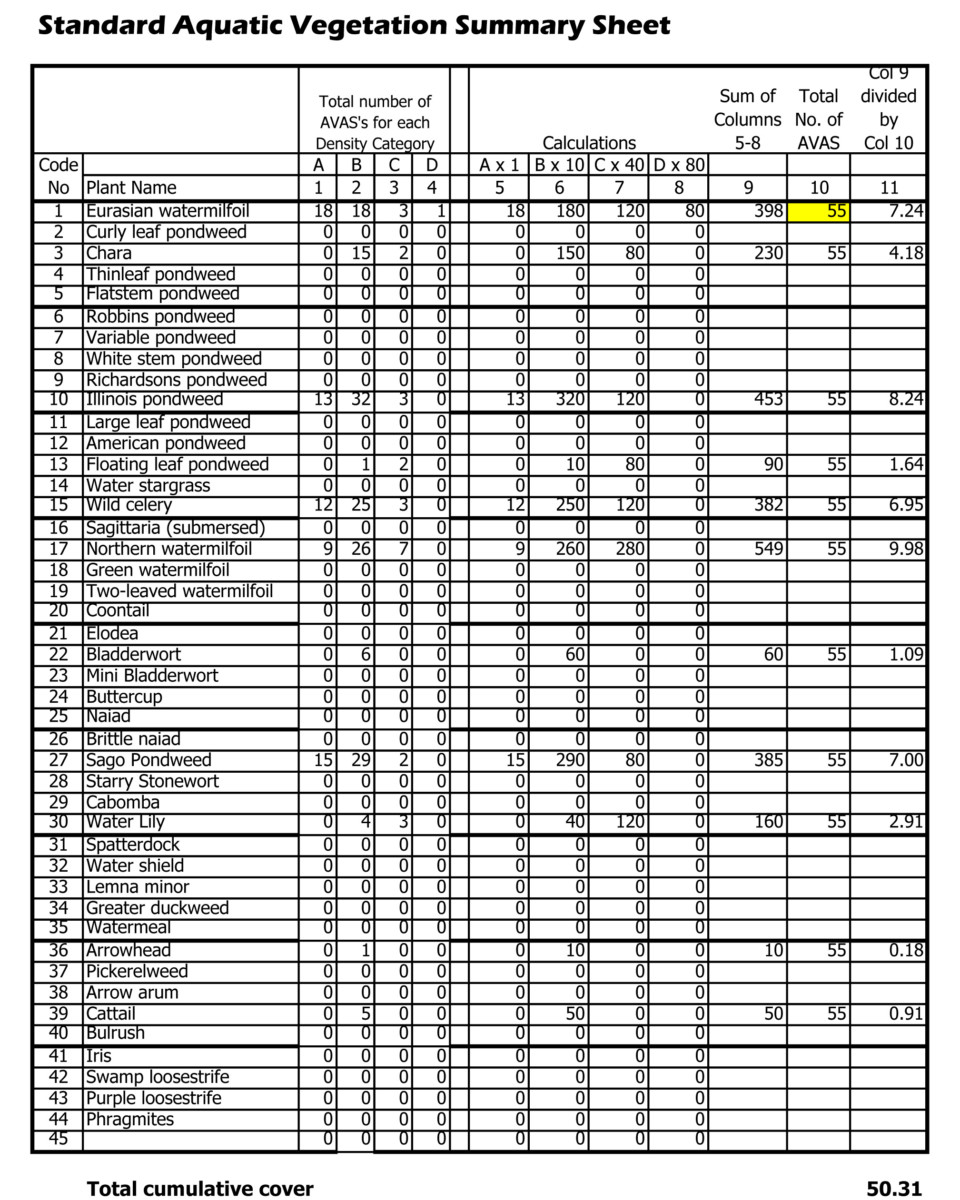 Here is the same chart from 2015:
Here is the same chart from 2015:
Invasive Weed Treatment Today (Wednesday, May 18, 2016)
The crew from Professional Lake Management (PLM) began their invasive weed treatment program for Clark Lake today (Wednesday 5/18/2016). The treatment is the first under the Special Assessment District (SAD) established by unanimous vote of the Columbia Township Trustees last August.
The quick spreading invasive weed is hybrid Eurasian water milfoil (HEWM) which can create huge problems. Lakes that did not take action found that this invasive species greatly curtailed recreational use of their lakes, destroyed wildlife habitat and hurt property values.
Today the PLM crew launched their craft at the west end, and traveled immediately to the east end of the lake which was their starting point for the activity. The photo shows their boat in the area of the County Park. This area has been inundated with the weed to the point that in the summer a boat could not move through it without severely fouling the prop and blocking cooling systems.
The most recent survey taken on Friday, May 13, showed about 30 acres of HEWM in the lake. The growth areas were marked by GPS and those readings are used in targeting the HEWM–and only the invasive plant.
Jeff Fischer, who piloted the PLM boat today, says “results should be seen in a week or two.” How does the product work? Jeff comments “this is a systemic treatment…the product causes the plant to grow wildly, extending spindly stalks, and then it collapses on itself.” The product used is Renovate OTF which is in granule form. As the granules are administered, they fall directly to the plants.
 As the crew in the boat prepared to treat all locations where HEWM was found in Friday’s survey (see map), PLM posted notices on every lakefront property regarding the treatment. According to PLM, this notice applies only if you are within 100 feet of a treatment area even though a notice was posted on your front lawn. Notices were posted universally since there are many spot treatment areas. PLM also indicates that the last two columns of the notice on your lawn applies only to agricultural uses, not to home owners on the lake. Treatment areas are specified on the map above.
As the crew in the boat prepared to treat all locations where HEWM was found in Friday’s survey (see map), PLM posted notices on every lakefront property regarding the treatment. According to PLM, this notice applies only if you are within 100 feet of a treatment area even though a notice was posted on your front lawn. Notices were posted universally since there are many spot treatment areas. PLM also indicates that the last two columns of the notice on your lawn applies only to agricultural uses, not to home owners on the lake. Treatment areas are specified on the map above.
To read more about this treatment program, and how it came to be, please scroll down below the notices.
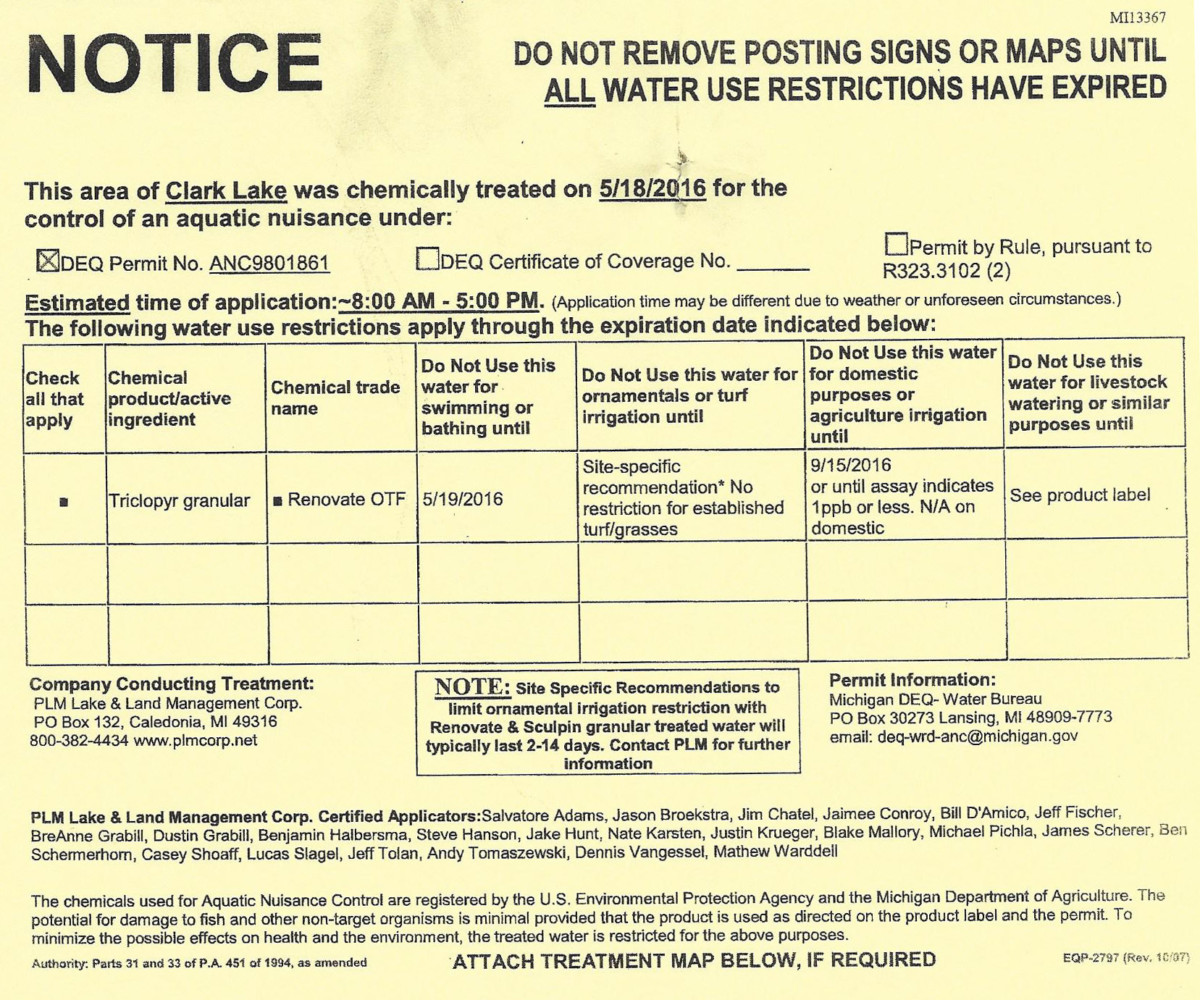 Below is the notice sent by mail to lakefront property owners.
Below is the notice sent by mail to lakefront property owners.
Because a Special Assessment District (SAD) has been established, treatment of this weed will take place wherever it is found in the lake, typically in waters up to 20 feet deep. For treatment to be effective, it must occur when the weeds are actively growing.
There may be a need for follow up spot treatments for stubborn patches or newly found growth, later in the season. Those tentative dates are for the weeks of June 13, July 18, and August 18.
The mailed notice specifies a number of different treatment product options. According to PLM’s Steve Hanson, “Renovate OTF has been most effective in treating HEWM in lakes like Clark Lake.” He also points out that the restrictions found in the notice apply only to areas within 100 feet of treatment zones. Much of the HEWM in Clark Lake is found along drop-offs or out in the middle of the lake, not within 100 feet of the shoreline.
Establishing the SAD was the culmination of a year-long drive by Clark Lake residents to stiffen the fight against this invasive weed. When DNA testing confirmed its presence in the lake and a survey in fall 2014 revealed about 20 acres in the lake, these residents formed the Clark Lake Invasive Species committee. They quickly came face-to-face with an ugly truth of the threat HEWM poses. The SAD allows treatment wherever the weed is found in the lake. The SAD also supports the cost of the treatment through a $64.42 per year assessment to owners of each lakefront property.
Through private donations to the Clark Lake Spirit Foundation, four areas of the lake were treated early last summer. PLM performed the treatment with a permit from the DEQ and with the consent of property owners. Because of the limitation of property owner rights, the areas treated stopped at 250 feet from shore. HEWM grows in waters of up to 20 feet deep, and there is a lots of it beyond 250 feet. The SAD addresses this limitation.
The Clark Lake Invasive Species Committee consists of Clark Lake volunteers who researched the problem thoroughly and concluded the only way to deal with HEWM was by the application of approved herbicides. They then took the message door to door, held a public information hearing in December 2014, and last spring started a petition drive to create the SAD. All along the way, progress was reported in detail on this website. At the first public hearing in August 2015, committee chairman John Deming told the trustees and the audience about community response. “In taking the SAD concept to residents, the committee found overwhelming support–95% of lakefront property owners contacted by the committee signed the SAD petition.” The committee delivered to the township petitions signed by 74% of the lakefront owners. Columbia Township trustees passed the SAD resolution unanimously.
Invasive Weed Treatment Scheduled for Wednesday May 18, 2016
As reported on Friday (5/13/16), Professional Lake Management (PLM) will take the battle to the invasive weed, hybrid Eurasian water milfoil (HEWM) on Wednesday (5/18/16). Lakes that did not take this step found that this rapidly spreading invader created huge problems.
Below is a map that is the result of Friday’s survey of Clark Lake. It shows the areas where HEWM was detected and where the treatment will take place. PLM has already sent notices to the mailboxes of lakefront property owners. On the day of treatment, they will also post signs if your property is nearby.
To locate the invasive species, PLM’s Jeff Fischer on Friday pulled up samples of weeds to determine if they were native plants or the invasive species. GPS was used to locate precisely the locations of the HEWM. Only the invasive weeds will be treated.
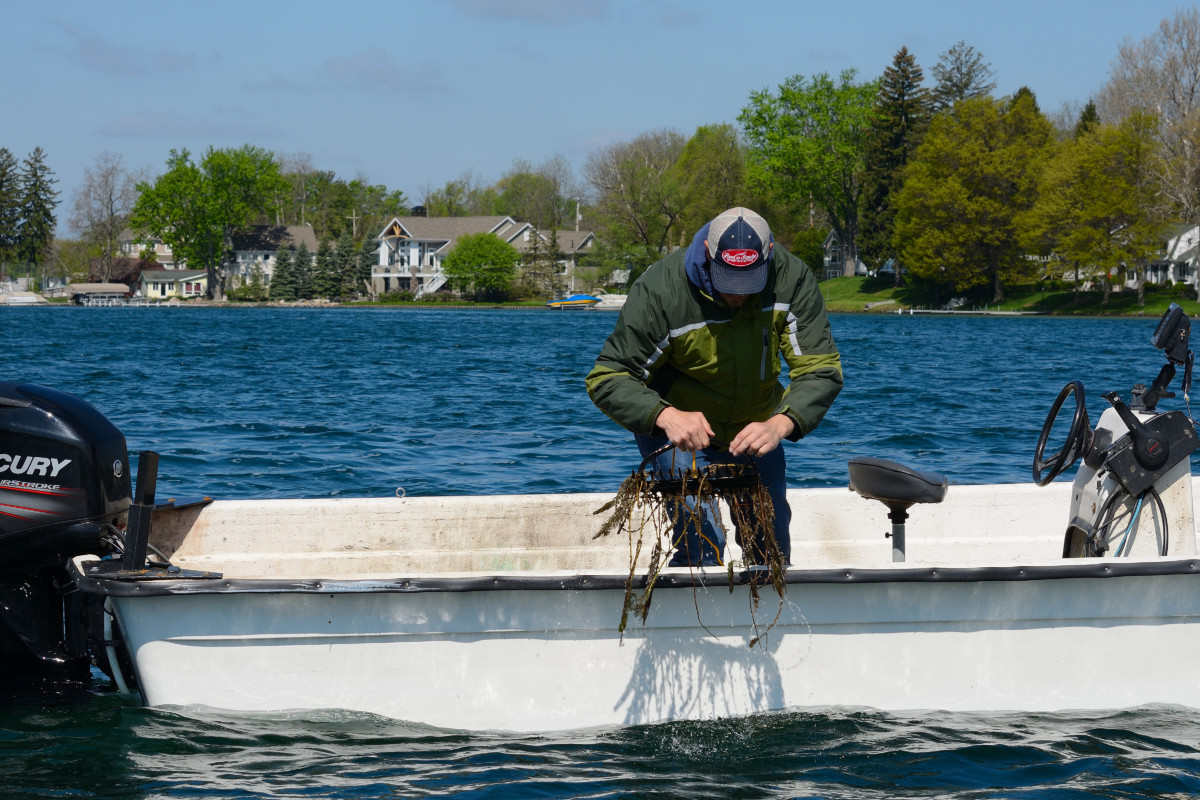
Jeff Fischer has a degree in fisheries and marine biology from MSU. This photo was taken on Friday, May 13, during the survey of the lake.
As noted above, HEWM spreads rapidly. Lakes that did not fight it found that its presence severely curtailed recreational activity, destroyed wildlife habitat and hurt property values.
Because a Special Assessment District (SAD) has been established, treatment of this weed will take place wherever it is found in the lake, typically in waters up to 20 feet deep. For treatment to be effective, it must occur when the weeds are actively growing.
There may be a need for follow up spot treatments for stubborn patches or newly found growth, later in the season. Those tentative dates are for the weeks of June 13, July 18, and August 18.
The notice specifies a number of different treatment product options. According to PLM’s Steve Hanson, “Renovate has been most effective in treating HEWM in lakes like Clark Lake, and we expect that we will use it here.” He also comments that the restrictions found in the notice apply only to areas within 100 feet of treatment zones. Much of the HEWM in Clark Lake is found along drop-offs or out in the middle of the lake, not within 100 feet of the shoreline.
Establishing the SAD was the culmination of a year-long drive by Clark Lake residents to stiffen the fight against this invasive weed. When DNA testing confirmed its presence in the lake and a survey in fall 2014 revealed about 20 acres in the lake, these residents formed the Clark Lake Invasive Species committee. They quickly came face-to-face with an ugly truth of the threat EWM poses. The SAD will allow treatment wherever the weed is found in the lake. The SAD also supports the cost of the treatment through a $64.42 per year assessment to owners of each lakefront property.
Through private donations to the Clark Lake Spirit Foundation, four areas of the lake were treated early last summer. PLM performed the treatment with a permit from the DEQ and with the consent of property owners. Because of the limitation of property owner rights, the areas treated stopped at 250 feet from shore. HEWM grows in waters of up to 20 feet deep, and there is a lots of it beyond 250 feet. The SAD addresses this limitation.
The Clark Lake Invasive Species Committee consists of Clark Lake volunteers who researched the problem thoroughly and concluded the only way to deal with HEWM was by the application of approved herbicides. They then took the message door to door, held a public information hearing in December 2014, and last spring started a petition drive to create the SAD. All along the way, progress was reported in detail on this website. At the first public hearing in August 2015, committee chairman John Deming told the trustees and the audience about community response. “In taking the SAD concept to residents, the committee found overwhelming support–95% of lakefront property owners contacted by the committee signed the SAD petition.” The committee delivered to the township petitions signed by 74% of the lakefront owners. Columbia Township trustees passed the SAD resolution unanimously.
Invasive Weed Survey Today – May 13, 2016
Professional Lake Management (PLM) is surveying the lake today (Friday 5/13) to locate the invasive weed, hybrid Eurasian water milfoil (HEWM). Jeff Fischer from PLM is pulling samples of weeds to determine if they are native plants or the invasive species. GPS is used to locate precisely the locations of the HEWM. Only the invasive weeds will be treated.
HEWM spreads rapidly and creates huge problems. Lakes that did not take action found that its presence severely curtailed recreational activity, destroyed wildlife habitat and hurt property values.
Treatment is scheduled for the week of May 16 and is planned to occur on Wednesday, weather permitting. PLM has already sent notice to the mailboxes of lakefront property owners. On the day of treatment, they will also post signs.
Because a Special Assessment District (SAD) has been established, treatment of this weed will take place wherever it is found in the lake, typically in waters up to 20 feet deep. For treatment to be effective, it must occur when the weeds are actively growing.
 There may be a need for follow up spot treatments for stubborn patches or newly found growth, later in the season. Those tentative dates are for the weeks of June 13, July 18, and August 18.
There may be a need for follow up spot treatments for stubborn patches or newly found growth, later in the season. Those tentative dates are for the weeks of June 13, July 18, and August 18.
The notice specifies a number of different treatment product options. According to PLM’s Steve Hanson, “Renovate has been most effective in treating HEWM in lakes like Clark Lake, and we expect that we will use it here.” He also comments that the restrictions found in the notice apply only to areas within 100 feet of treatment zones. Much of the HEWM in Clark Lake is found along drop-offs or out in the middle of the lake, not within 100 feet of the shoreline. This map illustrates the expected HEWM for this season. A more specific map will be posted as soon as the results of today’s survey are known.
Establishing the SAD was the culmination of a year-long drive by Clark Lake residents to stiffen the fight against this invasive weed. When DNA testing confirmed its presence in the lake and a survey in fall 2014 revealed about 20 acres in the lake, these residents formed the Clark Lake Invasive Species committee. They quickly came face-to-face with an ugly truth of the threat EWM poses. The SAD will allow treatment wherever the weed is found in the lake. The SAD also supports the cost of the treatment through a $64.42 per year assessment to owners of each lakefront property.
Through private donations to the Clark Lake Spirit Foundation, four areas of the lake were treated early last summer. PLM performed the treatment with a permit from the DEQ and with the consent of property owners. Because of the limitation of property owner rights, the areas treated stopped at 250 feet from shore. HEWM grows in waters of up to 20 feet deep, and there is a lots of it beyond 250 feet. The SAD addresses this limitation.
The Clark Lake Invasive Species Committee consists of Clark Lake volunteers who researched the problem thoroughly and concluded the only way to deal with HEWM was by the application of approved herbicides. They then took the message door to door, held a public information hearing in December 2014, and last spring started a petition drive to create the SAD. All along the way, progress was reported in detail on this website. At the first public hearing in August 2015, committee chairman John Deming told the trustees and the audience about community response. “In taking the SAD concept to residents, the committee found overwhelming support–95% of lakefront property owners contacted by the committee signed the SAD petition.” The committee delivered to the township petitions signed by 74% of the lakefront owners. Columbia Township trustees passed the SAD resolution unanimously.
Invasive Weed Vote Unanimous – September 21, 2015

HEWM cuttings. Props chop off the tops. The pieces then migrate and start new colonies. This mass was found during a busy weekend this summer.
The Columbia Township Board voted 6-0 tonight (Monday 9/21) to finalize the formation of a special assessment district (SAD) at Clark Lake.
This is the culmination of a year long drive by Clark Lake residents to stiffen the fight against an invasive weed that has made its way into the lake–hybrid Eurasian water milfoil (HEWM). When DNA testing confirmed its presence in the lake and a survey last fall revealed about 20 acres in the lake, these residents formed the Clark Lake Invasive Species committee. They quickly came face-to-face with an ugly truth–lakes that did not check the spread of HEWM found that it curtailed recreational activities, destroyed wildlife habitat, and hurt property values. The SAD will allow treatment wherever the weed is found in the lake. The SAD also supports the cost of the treatment through a $64.42 per year assessment for each lakefront property owner.
The roll call vote (see video below) took place after the second of two public hearings (to read about the first one, click here). The purpose of the second hearing was to hear if someone was put into the SAD by mistake (to read the notice, click here). No one spoke.
[youtube]https://youtu.be/mguMoLrHHOw[/youtube]
Through private donations to the Clark Lake Spirit Foundation, four areas of the lake were treated early this summer. A licensed operator performed the treatment with a permit from the DEQ and with the consent of property owners. Because of the limitation of property owner rights, the areas treated stopped at 250 feet from shore. HEWM grows in waters of up to 20 feet deep, and there is a lots of it beyond 250 feet. The SAD addresses this limitation.
The Clark Lake Invasive Species Committee consists of Clark Lake volunteers who researched the problem thoroughly and concluded the only way to deal with HEWM was by the application of approved herbicides. They then took the message door to door, held a public information hearing in December, and this spring started a petition drive to create the SAD. At the first public hearing in August, committee chairman John Deming told the trustees and the audience about community response. “In taking the SAD concept to residents, the committee found overwhelming support–95% of lakefront property owners contacted by the committee signed the SAD petition.” The committee delivered to the township petitions signed by 74% of the lakefront owners.
This fall another survey of the lake will be conducted that will form the framework for treatment next spring. Because the SAD doesn’t take effect until 2016, the cost of the survey this fall will be borne by donations already received by the Clark Lake Spirit Foundation.
Township Votes “Yes” for Weed Control – August 11, 2015
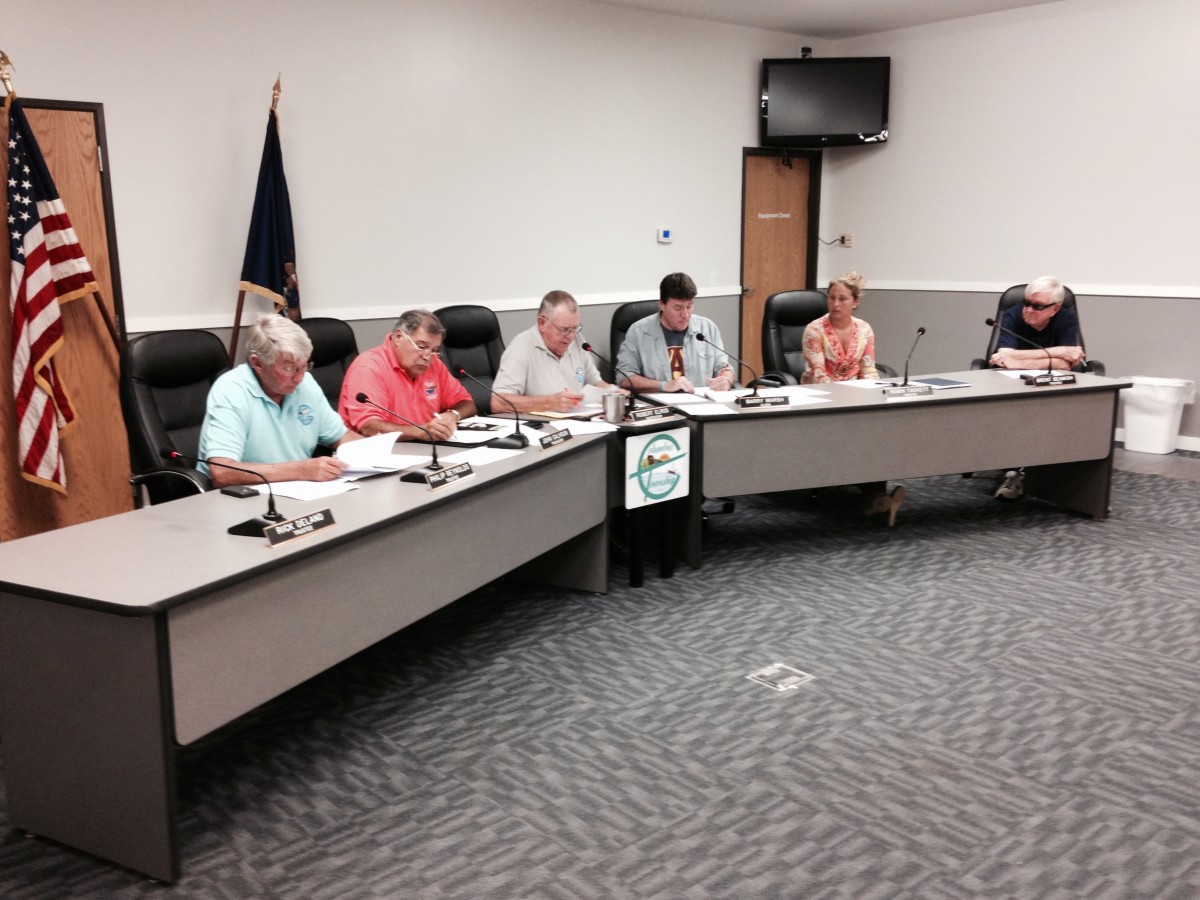
Township elected officials: Flip Reynolds, Treasurer John Calhoun, Supervisor Bob Elrod, Clerk Barry Marsh, Robin Tackett, Brent Beamish
Tonight (Tuesday 8/11), the Columbia Township trustees voted 6-0 to create a special assessment district (SAD) to deal with an invader threatening Clark Lake–hybrid Eurasian water milfoil or HEWM. DNA testing has confirmed its presence in the lake and a survey last fall revealed about 20 acres in the lake. Lakes that did not check its spread found that it curtailed recreational activities, destroyed wildlife habitat, and hurt property values. The SAD will allow treatment wherever the weed is found in the lake. The SAD also supports the cost of the treatment through a $75 per year assessment for each lakefront property owner.
Through private donations to the Clark Lake Spirit Foundation, four areas of the lake were treated early this summer. A licensed operator performed the treatment with a permit from the DEQ and by permission of property owners. Because of the limitation of property owner rights, the areas treated stopped at 250 feet from shore. HEWM grows in waters of up to 20 feet deep, and there is a lots of it beyond 250 feet. The SAD addresses this limitation.
Tonight’s meeting was a culmination of a year long project by the Clark Lake Invasive Species Committee which has been supported by the Clark Lake Spirit Foundation. The committee consists of Clark Lake volunteers who researched the problem thoroughly and concluded the only way to deal with HEWM was by the application of approved herbicides. They then took the message door to door, held a public information hearing in December, and this spring started a petition drive to create the SAD. Committee Chairman John Deming told the trustees and the audience “in taking the SAD concept to residents, the committee found overwhelming support–95% of lakefront property owners contacted by the committee signed the SAD petition.” The committee delivered to the township petitions signed by 74% of the lakefront owners.
During public comment some in the audience questioned why businesses and marinas were not charged more than residents. Part of the success of the project was its simplicity. John Deming commented “Moving forward with this program now will keep the cost low. Experience shows the sooner treatment begins, the less of it is needed.” Another committee member noted that adding complexity would cause delays allowing the HEWM to get an upper hand.
Others suggested that back lot owners or those using the boat launches for the day should also pay. Township supervisor Bob Elrod pointed out that the lakefront property owners “had the most to lose.” There was recognition that property values could be adversely affected by not checking HEWM’s advance.
Concerns were voiced about the safety of the herbicides and their affect on health. Ron June, a committee member, quoted from a pamphlet published by the committee regarding this topic. The section reads “The two herbicides that are typically used target the invasive weeds, but not native plants. Their use is approved by the DNR/DEQ and EPA. Neither the American Cancer Society nor U.S. Toxicology Program has listed the herbicides as a carcinogen. There are no known detrimental effects to humans, pets and wildlife.”
Steve Hansen, a fishery biologist, is a representative of Professional Lake Management, was available to answer questions. His company performed the treatment earlier this summer and is scheduled to treat the lake in 2016. He was asked about how long herbicides remain in the water after treatment. He said there is a “one day swimming restriction within 100 feet of treatment,” and the detectable levels, measured in parts per billion, drop near the treatment sites within several days.
Carolyn Zader, a Clark Lake resident, drew applause when she noted that “doing nothing was not an option.” She said to let this infestation happen and turn our “pristine lake into a mud pit would be criminal.”
From this point forward, the township takes responsibility for the operation of the SAD. One more public hearing is scheduled for September 21st. At this meeting a landowner can object to being included in the district if he feels he was mistakenly made part of it.
The meeting, publicized by two full page ads in the Exponent and a notice to property owners by U.S. Mail, played to nearly a full house. There was lively, but civilized, discussion. And one key takeaway was apparent–they were all motivated by their concern for the future of Clark Lake.
Invasive Weed Update – July 20, 2015
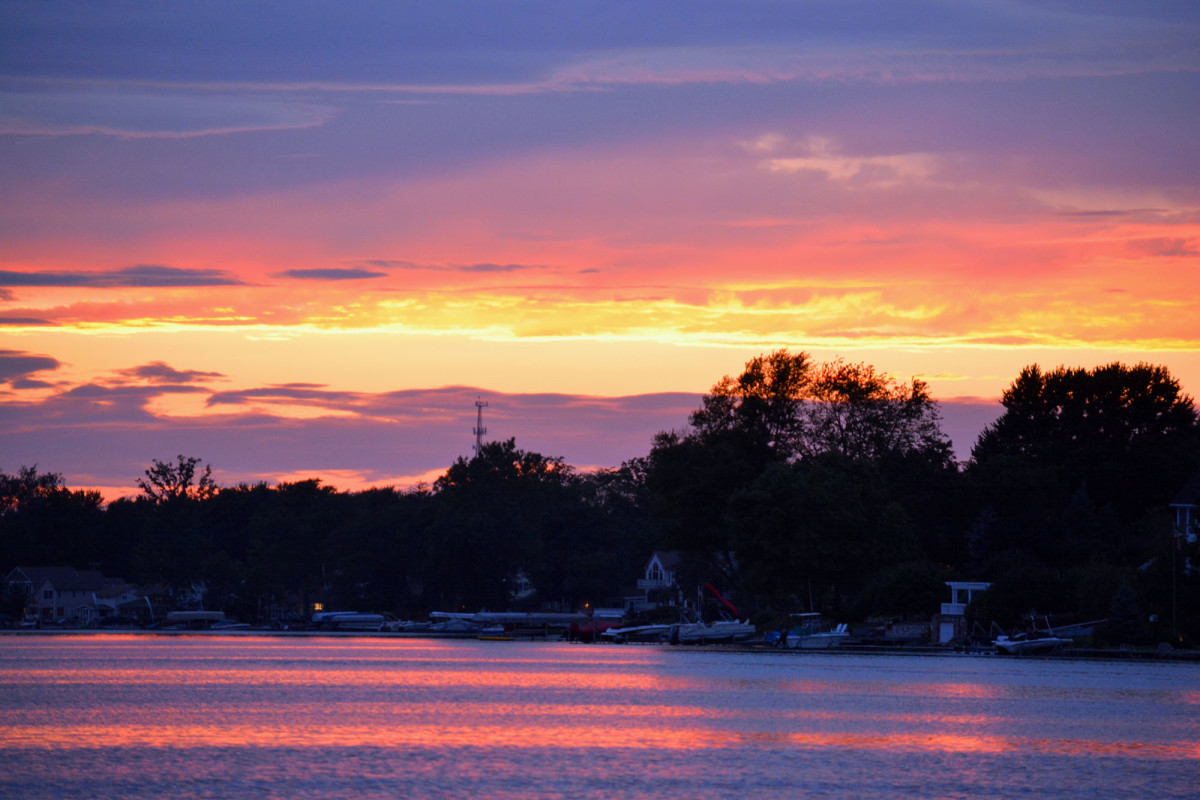 Two notable events took place Monday evening–another awesome sunset and a vote by the Columbia Township Board of Trustees about something at Clark Lake that is not so beautiful. All six members of the board present voted to take the next step in establishing a special assessment district (SAD) to deal with invasive weeds in Clark Lake. Tonight’s vote schedules a public hearing on August 11 and provides for notifying property owners of the meeting via ads in the Exponent and directly by U.S. Mail.
Two notable events took place Monday evening–another awesome sunset and a vote by the Columbia Township Board of Trustees about something at Clark Lake that is not so beautiful. All six members of the board present voted to take the next step in establishing a special assessment district (SAD) to deal with invasive weeds in Clark Lake. Tonight’s vote schedules a public hearing on August 11 and provides for notifying property owners of the meeting via ads in the Exponent and directly by U.S. Mail.
The not-beautiful news is that Clark Lake is battling hybrid Eurasian water milfoil (HEWM). DNA testing confirmed its presence in the lake and a survey revealed an infestation of about 20 acres. Other lakes that didn’t act found that it curtailed recreational use of their lake, destroyed wildlife habitat and negatively affected property values.
Just over 4 acres of Clark Lake’s infestation were treated on June 18th by a licensed professional applicator. An initial survey of results suggests that the treatment worked well.
DEQ permits and permission of property owners in the area of treatment were required. The HEWM is far more widespread in Clark Lake than the 4 acres just treated. Because of limits on the ability of property owners to give permission beyond 250 feet of their shoreline, the Clark Lake Invasive Species Committee conducted a petition drive to establish an special assessment district (SAD). The SAD will allow for treatment anywhere in the lake where the HEWM is found and also support the effort through an assessment.
Ron June address the Columbia Township board on behalf of the Clark Lake Invasive Species Committee. Here is the text of the message:
“Clark Lake is threatened by an aquatic invasive species known as hybrid Eurasian water milfoil, abbreviated as HEWM. DNA testing has confirmed its presence in the lake. A survey last fall, supported by the Clark Lake Spirit Foundation, revealed that there was 20 acres in the lake. This weed propagates rapidly. A small piece of plant that drifts to a new location can start an entirely new colony. On the Clark Lake Spirit website, there are before and after aerial photos showing how quickly it took root near the County Park. Other photos illustrate its density. HEWM grows in waters up to 20 feet deep, right up to the shoreline. Other lakes in the region that did not check its advance found that it curtailed recreational use of their waters, destroyed wildlife habitat, and was detrimental to property values. Before a treatment program at Grass Lake began, a witness reported seeing a muskrat walking on top of the weeds where before there was open water.
“The Committee researched the problem extensively and believes that the only way to halt this invasion is through application of approved herbicides by professionals. Because of the limitation of riparian rights and the cost of ongoing treatment, the Committee is convinced that it is necessary to establish a special assessment district or SAD under Michigan Public Act 188 of 1954, as amended.
“In taking the SAD concept to residents, the committee found overwhelming support. 95% of lakefront property owners contacted by the Committee signed the SAD petition, the format of which was approved by Columbia Township. The Committee has presented to the Township petitions attesting the agreement of nearly 74% of lakefront property owners, based on their lakefront footage.
“Gathering these petitions represents hundreds of man-hours from a team of volunteers who are part of the Clark Lake community. Along with the many who signed the petition, the volunteers are evidence of widespread support to establish the SAD.
“Time is of the essence. By next summer, it’s estimated that the Clark Lake HEWM population will have covered 25 acres. That’s in spite of a privately funded program that eradicated a little over 4 acres this spring. The Committee believes that the SAD must be in operation so the assessments can be part of the Winter 2015 tax bills, and that treatment of the HEWM can commence in Spring 2016 to any area of the lake where the weed is detected.
“The Committee has presented to the Township its formal plan and budget projections for the 7 year life of the SAD. That plan included a pamphlet that the Committee has handed out to residents that answers commonly asked questions. The results of many hours of research can be found at clarklakespirit dot com under invasive weeds.
“On behalf of an overwhelming majority of owners of Clark Lake frontage, we ask for your continued support in setting up the two public hearings and making arrangements for the required notices in the Exponent and via First Class U.S. Mail.
Ron June thanked the board.
HEWM is different from the native milfoil plant found in Clark Lake. HEWM is the fast spreading hybrid and can be identified by its reddish stem. After busy weekends, you can find patches of it floating in the lake. These floaters were likely created by props chopping off the tops of the plants. The bad news is that each one of those clippings is capable of starting many more of its genre. The good news is that the treatment program works. And then there are the sunsets–one of the things that make being at Clark Lake so worthwhile.

Columbia Township trustees meeting on July 20, 2015. Left to right: Rick Deland, Flip Reynolds, John Calhoun (treasurer), Bob Elrod (supervisor), C.J. Hulburt (deputy clerk), Robin Tackett, Brent Beamish
Initial Weed Treatment Appears Successful – July 14, 2015

Treated HEWM loses its root system and turns brown. This County Park photo shows dying plants. Lily pads were not affected.
As reported on this website, Clark Lake is battling an invasive weed–hybrid Eurasian water milfoil (HEWM). DNA testing confirmed its presence in the lake and a survey revealed an infestation of about 20 acres. Other lakes that didn’t act found that it curtailed recreational use of their lake, destroyed wildlife habitat and negatively affected property values.
Just over 4 acres of Clark Lake’s infestation were treated on June 18th by a licensed professional applicator. An initial survey of results suggests that the treatment worked well. Steve Hanson, a fisheries biologist from Professional Lake Management, pointed to his observation of the HEWM colony at the County Park. He said the majority of the HEWM “has been reduced significantly.” Hanson expects to perform another review next week.
DEQ permits and permission of property owners in the area of treatment are required. The HEWM is far more widespread in Clark Lake than the 4 acres just treated. Because of limits on the ability of property owners to give permission beyond 250 feet of their shoreline, the Clark Lake Invasive Species Committee conducted a petition drive to establish an special assessment district (SAD). The SAD will allow for treatment anywhere in the lake where the HEWM is found and also support the effort through an assessment. “The treatment program this summer was funded by private donations to the Clark Lake Spirit Foundation” says committee chairman John Deming. He also says “the SAD should be in operation by next summer so the eradication program can begin in earnest.” The committee has delivered petitions signed by over 73% lakefront property owners to Columbia Township to form the SAD.
HEWM is different from the native milfoil plant found in Clark Lake. HEWM is the fast spreading hybrid and can be identified by its reddish stem. Over the July 4th weekend, you could find patches of it floating in the lake. These floaters were likely created by props chopping off the tops of the plants. The bad news is that each one of those clippings is capable of starting many more of its genre. The good news is that the treatment program works.
The four areas that were treated are marked below.
Weeds Treated in Four Areas – June 18, 2015
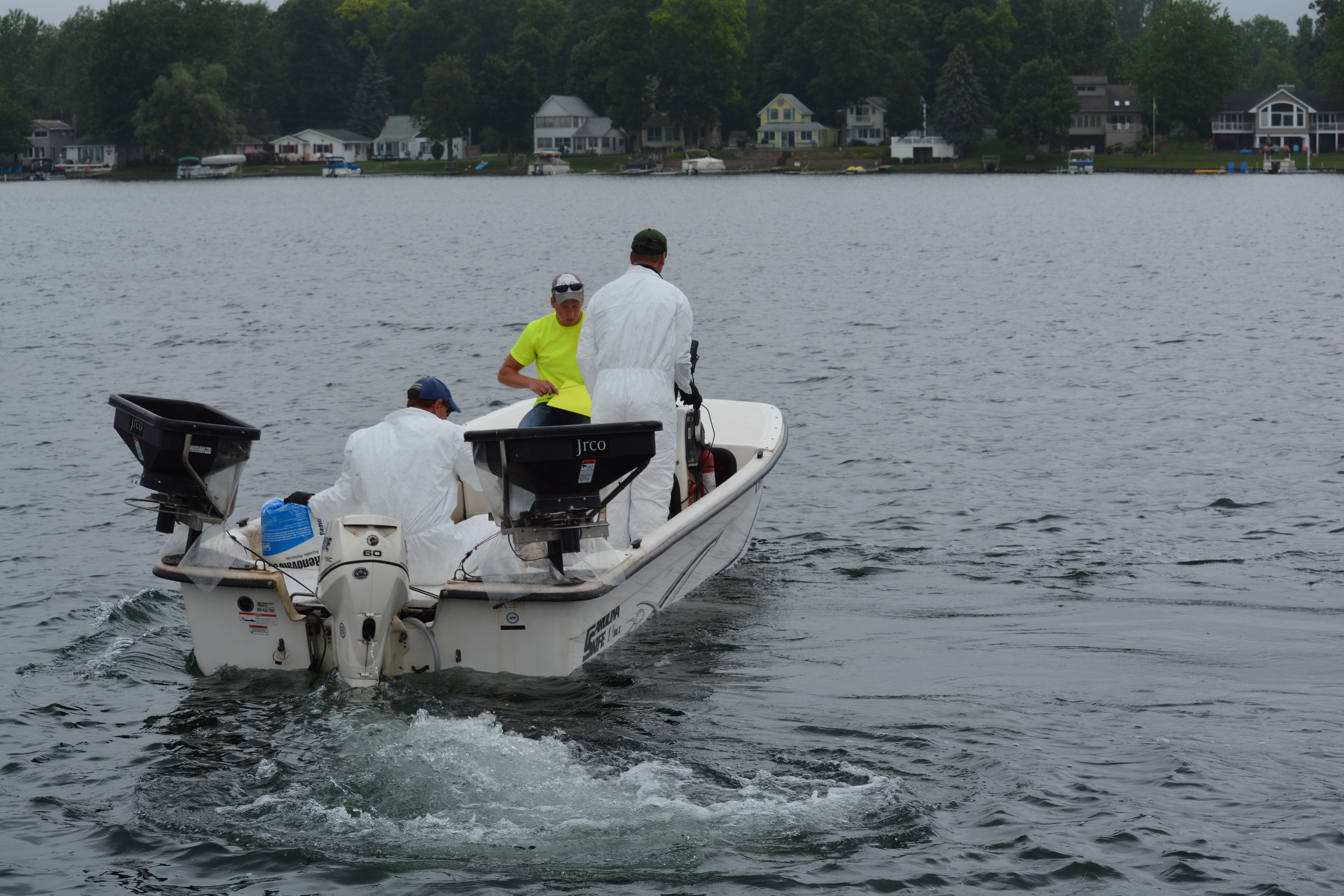 As planned, four acres of the fast spreading invasive weed, hybrid Eurasian water milfoil (HEWM), were treated today in an operation that took about an hour and a half. While the treatment product dissipates fairly quickly, it can take a week to 10 days for the plants to die off. There is a 24-hour swimming advisory within 100 feet of treated areas.
As planned, four acres of the fast spreading invasive weed, hybrid Eurasian water milfoil (HEWM), were treated today in an operation that took about an hour and a half. While the treatment product dissipates fairly quickly, it can take a week to 10 days for the plants to die off. There is a 24-hour swimming advisory within 100 feet of treated areas.
HEWM can take over a lake, as some have found in our region. When left unchecked, this invasive species radically alters a lake for the worse. It curtails recreational activities like boating, swimming, fishing, destroys wildlife habitat and lowers property values.
The cost to treat the four acres today was defrayed by private donation to the Clark Lake Spirit Foundation. The lakefront property owners in those areas gave their permission. The application was done by licensed professionals with permits from the DNR/DEQ.
A survey last fall revealed there are some 20 acres of HEWM in the lake, but only four acres were treated today. This is because property owners can only give their permission to treat up to 250 foot off their shore. By establishing a special assessment district (SAD), treatment may be done anywhere in the lake that HEWM is found. The SAD also deals with the cost of the program through an assessment to lakefront property owners. Over 70% of lakefront property owners have signed petitions to establish a SAD. The Columbia Township Board of Trustees has voted to accept the petitions. Once the process of establishing the SAD is complete, treatment of the remaining weeds can take place. Because of the time it takes to set up the SAD, treatment will take place in 2016.
The cost to lakefront property owners will not exceed $85 per parcel in the first year. Other lakes discovered that the annual cost declines once the weeds are brought under control. Once HEWM finds its way into a lake, it can never be completely eradicated. But an effective treatment program controls it to great extent.
Today’s treatment and the establishing of the SAD is the work of the Clark Lake Invasive Species Committee, comprised of community volunteers.
Below is a map of the areas treated today.
Four Acres of Weeds to Be Treated Thursday [June 18] – posted June 16, 2015
 As previously reported on this website, treatment of four areas of Clark Lake for the infestation of hybrid Eurasian water milfoil (HEWM) will take place this week. Weather permitting, the treatment will occur on Thursday morning (June 18).
As previously reported on this website, treatment of four areas of Clark Lake for the infestation of hybrid Eurasian water milfoil (HEWM) will take place this week. Weather permitting, the treatment will occur on Thursday morning (June 18).
As you are likely aware, DNA testing confirmed the presence of HEWM in the lake. A survey last fall, funded by the Clark Lake Spirit Foundation, revealed that 20 acres of this fast spreading invader has taken root in the lake. When other lakes left infestations unchecked, they found that this rapidly propagating weed curtails recreational activity, is detrimental to property values and destroys habitat.
The treatment program scheduled for Thursday will cover four areas of the lake (see illustration). Treatment in these areas required the permission of lakefront property owners and permits from the DEQ/DNR. Signs are posted and owners in those areas have been notified directly. There is a 24 hour swimming restriction 100 feet from the affected areas.
The treatment of these four areas, a small portion of the 20 acres, was financed through donations to the Clark Lake Spirit Foundation. To legally treat HEWM wherever it exists in the lake, it is necessary to establish a special assessment district (SAD). A group of mostly Clark Lake residents, the Clark Lake Invasive Species Committee, has been circulating petitions to create the SAD. In spite of the fact that quick action is essential in thwarting HEWM’s advance, treatment of the remainder of the 20 or more acres will not take place until 2016. This is because of the time it takes to set up the SAD. Even after treatment of 4 acres this summer, it’s predicted that the fast growing HEWM will cover 25 acres by 2016.
Last night, the Invasive Species Committee submitted signed petitions to the Columbia Township Board of Trustees representing 70% of the lakefront landowners. Committee chairman, John Deming, told trustees “ninety-five percent of the lakefront owners that the committee has been able to contact have signed the petition, affirming their support”. Speaking of the problem, he noted “property owners understand the dire nature of this threat and how it could turn our lake into something we’ve only seen elsewhere. Other lakes have battled this threat, and we have learned what’s effective from their experiences.” The township trustees voted to accept the petitions. John Deming emphasized “time is of the essence.” The weed spreads quickly, and this requires quick action.
The cost per lakefront property will be no higher than $85 in the first year. Other lakes found the cost declines in subsequent years once the weed is under control (see newspaper article regarding nearby Devils Lake).
Below you can download a PDF version of a pamphlet that addresses additional questions that you may have. To print, choose “print both sides of paper, flip on short-edge, auto-portrait landscape.”
Township Votes to Accept Petitions – June 15, 2015
Tonight at the meeting of the Columbia Township trustees, the Clark Lake Invasive Species Committee delivered signed petitions requesting the formation of a special assessment district (SAD) to control invasive weeds in the lake. All trustees present voted to accept the petitions. The signed petitions represent over 70% of lakefront owners. In delivering the petitions, Committee Chairman John Deming spoke as follows:
“Clark Lake is threatened by an aquatic invasive species known as hybrid Eurasian water milfoil, abbreviated as HEWM. DNA testing has confirmed its presence in the lake. A survey last fall, supported by the Clark Lake Spirit Foundation, revealed that there was 20 acres in the lake. This weed propagates rapidly. A small piece of plant that drifts to a new location can start an entirely new colony. On the Clark Lake Spirit [this] website, there are before and after aerial photos showing how quickly it took root near the County Park. Other photos illustrate its density. HEWM grows in waters up to 20 feet deep, right up to the shoreline. Other lakes in the region that did not check its advance found that it curtailed recreational use of their waters, destroyed wildlife habitat, and was detrimental to property values. Before a treatment program at Grass Lake began, a witness reported seeing a muskrat walking on top of the weeds where before there was open water.
“The Committee researched the problem extensively and believes that the only way to halt this invasion is through application of approved herbicides by professionals. Because of the limitation of riparian rights and the cost of ongoing treatment, the Committee is convinced that it is necessary to establish a special assessment district or SAD under Michigan Public Act 188 of 1954, as amended.
“In taking the SAD concept to residents, the committee found overwhelming support. 95% of lakefront property owners contacted by the Committee signed the SAD petition, the format of which was approved by Columbia Township. The Committee is ready to present to the Township 251 signed petitions attesting to the agreement of over 70% of lakefront property owners, based on their lakefront footage.
“The gathering of these petitions over the last four weeks represents the work of hundreds of man-hours from a team of volunteers who are part of the Clark Lake community. Along with those who signed the petition, the volunteers are evidence of the considerable desire of Clark Lake property owners to initiate this program. The Committee will need the guidance of the Township as to how these petitions should be delivered and if there can be written acknowledgement in the form of a receipt.
“Time is of the essence. By next summer, it’s estimated that the Clark Lake HEWM population will have covered 25 acres. That’s in spite of a privately funded program that will eradicate a little over 4 acres this spring. The Committee believes that the SAD must be in operation so the assessments can be part of the Winter 2015 tax bills, and that treatment of the HEWM can commence in Spring 2016 to any area of the lake where the weed is detected.
“This evening, we are also presenting a formal plan and budget projections for the 7 year life of the SAD. Included is a pamphlet that the Committee has handed out to residents that answers commonly asked questions. The results of many hours of research can be found at clarklakespirit dot com under invasive weeds.
It is our hope that the Board of Trustees will take quick action and that there will be expeditious staff support so that formation of the SAD will meet all deadlines.
Next steps include public notice and hearings. This website will continue to update further developments as they occur. You can follow earlier progress of the committee on this website under the Invasive Weeds tab.
WILX-TV Reports on Clark Lake’s Weed Problem – June 9, 2015
WILX-TV’s Lorne Fultonberg visited Clark Lake today to investigate something that many residents here know about–the invasive aquatic weed, hybrid Eurasian water milfoil (HEWM). The reporter surveyed the lake by raft and spoke at length with Clark Lake Invasive Species Committee Chairman John Deming, and also talked with committee member Beth June. One of the lake locations that was scrutinized was near the County Park at the east end where HEWM is already breaking through the water.
To view the story as it aired on WILX-TV at 6 pm today, please click here.
The reporter spent time thoroughly examining the evidence, even taking GoPro video to show the plant under water. As you can see in the TV news story, Lorne took a piece of the HEWM back to the studio to illustrate what it looked like out of water. To preserve the weed for the trip back to the studio in Lansing, John Deming had preserved it in a Mason jar. Before that, Lorne, not without a sense of humor, revealed his view of the invader in this video as he wondered aloud what he would do with it.
Weed Treatment Rescheduled – June 8, 2015
A previous story reported that treatment of the four areas of Clark Lake for the infestation of hybrid Eurasian water milfoil (HEWM) would take place on Wednesday, June 10. The treatment has been rescheduled for the week of June 15.
As you are likely aware, DNA evidence confirmed the presence of HEWM in the lake. A survey last fall, funded by the Clark Lake Spirit Foundation, revealed that 20 acres of this fast spreading invader has taken root in the lake. When other lakes left infestations unchecked, they found that this rapidly propagating weed curtails recreational activity, is detrimental to property values and destroys habitat.
The treatment program scheduled for the week of June 15 will cover four areas of the lake (see illustration). Treatment in these areas required the permission of lakefront property owners and permits from the DEQ/DNR. Signs will be posted and owners in those areas will be notified directly. There is a 24 hour swimming restriction 100 feet from the affected areas.
The treatment of these four areas, a small portion of the 20 acres, was financed through donations to the Clark Lake Spirit Foundation. To legally treat HEWM wherever it exists in the lake, it is necessary to establish a special assessment district (SAD). A group of mostly Clark Lake residents, the Clark Lake Invasive Species Committee, is currently circulating petitions to create the SAD. In spite of the fact that quick action is essential in thwarting HEWM’s advance, treatment of the remainder of the 20 or more acres will not take place until 2016. This is because of the time it takes to set up the SAD.
According to the chairman of the Invasive Species Committee, John Deming, the petition drive is going well. “Ninety-five percent of the lakefront owners that the committee has been able to contact have signed the petition, affirming their support” reports John. He notes “property owners understand the dire nature of this threat and how it could turn our lake into something we’ve only seen elsewhere. Other lakes have battled this threat, and we have learned what’s effective from their experiences.”
What about those who chose not to sign? John Deming replies “a small number of people thought others should pay for the treatment, which is $85 in the first year for lakefront property owners.” John pointed to the committee’s conclusion that “the added complexity of trying to determine which back lot owners should pay or somehow charging non-residents who bring their boats onto the lake would surely delay this for a year or two more.” He summarized, “that’s unacceptable when facing a challenge like this–delay means more weeds and added costs to eradicate them.” Other lakes found the cost declines in subsequent years once the weed is under control (see newspaper article regarding nearby Devils Lake). John remarked “a multiple choice petition is not possible–the choice is to sign and control, or not sign and let the lake be overrun by this weed.”
It’s certain that lakefront property owners have most to lose. A local real estate agent commented that the premium in land value for lakefront owners quickly dissipates when a lake becomes infested with weeds and does nothing about it.
Sample petition:
Signed petitions will soon be presented to Columbia Township as the next step in this process. This website will continue to report on this topic.
Below you can download a PDF version of a pamphlet that addresses additional questions that you may have. To print, choose “print both sides of paper, flip on short-edge, auto-portrait landscape.”
Weed Treatment Scheduled – June 6, 2015

HEWM was observed Thursday breaking the surface near the County Park. This photo is from summer 2014
Treatment to check the advance of hybrid Eurasian water milfoil (HEWM) is scheduled to take place on Clark Lake on Wednesday, June 10, weather permitting.
As you are likely aware, DNA evidence confirmed the presence of HEWM in the lake. A survey last fall, funded by the Clark Lake Spirit Foundation, revealed that 20 acres of this fast spreading invader has taken root in the lake. When other lakes left infestations unchecked, they found that this rapidly propagating weed curtails recreational activity, is detrimental to property values and destroys habitat.
The treatment program scheduled for Wednesday will cover four areas of the lake (see illustration). Treatment in these areas required the permission of lakefront property owners and permits from the DEQ/DNR. Signs will be posted and owners in those areas will be notified directly. There is a 24 hour swimming restriction 100 feet from the affected areas.
The treatment of these four areas, a small portion of the 20 acres, was financed through donations to the Clark Lake Spirit Foundation. To legally treat HEWM wherever it exists in the lake, it is necessary to establish a special assessment district (SAD). A group of mostly Clark Lake residents, the Clark Lake Invasive Species Committee, is currently circulating petitions to create the SAD. In spite of the fact that quick action is essential in thwarting HEWM’s advance, treatment of the remainder of the 20 or more acres will not take place until 2016. This is because of the time it takes to set up the SAD.
According to the chairman of the Invasive Species Committee, John Deming, the petition drive is going well. “Ninety-five percent of the lakefront owners that the committee has been able to contact have signed the petition, affirming their support” reports John. He notes “property owners understand the dire nature of this threat and how it could turn our lake into something we’ve only seen elsewhere. Other lakes have battled this threat, and we have learned what’s effective from their experiences.”
What about those who chose not to sign? John Deming replies “a small number of people thought others should pay for the treatment, which is $85 in the first year for lakefront property owners.” John pointed to the committee’s conclusion that “the added complexity of trying to determine which back lot owners should pay or somehow charging non-residents who bring their boats onto the lake would surely delay this for a year or two more.” He summarized, “that’s unacceptable when facing a challenge like this–delay means more weeds and added costs to eradicate them.” Other lakes found the cost declines in subsequent years once the weed is under control (see newspaper article regarding nearby Devils Lake). John remarked “a multiple choice petition is not possible–the choice is to sign and control, or not sign and let the lake be overrun by this weed.”
It’s certain that lakefront property owners have most to lose. A local real estate agent commented that the premium in land value for lakefront owners quickly dissipates when a lake becomes infested with weeds and does nothing about it.
Sample petition:
Signed petitions will soon be presented to Columbia Township as the next step in this process. This website will continue to report on this topic.
Below you can download a PDF version of a pamphlet that addresses additional questions that you may have. To print, choose “print both sides of paper, flip on short-edge, auto-portrait landscape.”
Invasive Weeds Spot Treatment Update – May 13, 2015
This spring four areas of the much larger 20-arces of hybrid Eurasian milfoil (HEWM) in Clark Lake will be treated. Today, Steve Hansen, a fisheries biologist from Professional Lake Management, toured Clark Lake to determine the current state of HEWM at the four sites. His review revealed that the plants must mature a bit more for treatment to be effective. He expects that treatment will take place in about two weeks, after the Memorial Day weekend. According to Hansen, water temperature and weather conditions are factors. Lower temperatures, like today, slows down the growth of the plants.
The treatment of the four areas this spring is supported by donations to the Clark Lake Spirit Foundation.To legally treat the remainder of the 20 acres, it’s necessary to set up a Special Assessment District (SAD). The petition drive that began this weekend is a first step. The SAD will have a 7 year term, beginning in 2016. The cost will be added to property taxes collected by the Township and will be $85 for the first year. That cost may decline in future years if the experience of Clark Lake parallels other lakes in the area.
As you are likely aware, DNA evidence confirms the presence in Clark Lake of this fast spreading weed. Other lakes that did not stop this weed found that it severely curtailed recreational use, destroyed wildlife habitat, and was detrimental to property values.
Quick action works best in thwarting the advance of this aquatic invader. Your signature on the petition will indicate that you support the formation of a SAD.
Those knocking on doors report that many lakefront property owners are not yet at the lake. If you are one of them and wish to support this activity by signing the petition, you can request that a petition be emailed to you. For the petition to be counted by the Township, the following steps should be taken.
There is pre-printed petition form for each piece of lakefront property that lists the owner(s). Each owner (or owners) should sign in the appropriate location on the form. The signing must be witnessed by someone known as a “circulator”. The circulator must be someone other than the owner(s). After the circulator witnesses the signature of the owner(s), he or she prints and signs his or her name and address. The completed form should then be returned by US Mail. To initiate this process, your request should be emailed to clarklakespirit@gmail.com.
An info sheet covering frequently asked questions has been put together and will soon be available in print. Below, you can preview the FAQ section.
FAQs
Who may sign the petition?
Only lakefront property owners. If a property is held jointly, all owners must sign for that piece of property or “parcel.” It is not necessary to be a Michigan resident to sign the petition.
What does the circulator of the petition do?
The circulator takes the petition to lakefront property owners and asks them to sign it. The circulator must witness the signing, and confirm this by signing his or her name in the appropriate section of the form. There are no requirements of residency or ownership to be a circulator, but he or she must be someone other than the signer of the petition.
What does the petition look like?
There is a separate sheet for each lakefront property. The form includes the parcel ID number, the name(s), and address of the owner(s). Scroll down to view a sample petition.
How do I pay the $85 fee?
It will be included as a separate line item on property tax bills of lakefront owners.
How do you treat HEWM?
The two herbicides that are typically used target the invasive weeds, but do not affect native plants. Their use is approved by several agencies including the DNR/DEQ and EPA. Neither the American Cancer Society nor U.S. Toxicology Program has listed the herbicides as a carcinogen. There are no known detrimental effects to humans, pets and wildlife. All treatments will be applied by professionals and done by permit with all rules rigorously observed.
What about swimming in the lake after the treatment?
The herbicides are in common use—you may have some in your garage right now. If you mistakenly got a small amount on you while spraying dandelions, you’d likely have a far greater dosage than from swimming in the lake right after treatment. There is a 24-hour swimming restriction that applies only within 100 feet of the treatment areas.
Will my well be contaminated?
No. Testing has shown no trace of contaminants from wells in treatment areas.
How long do the herbicides last in the water?
Renovate, the herbicide used within 250 feet of shorelines and 2,4-D which will be used more than 250 feet from shore may be detectable for several days, up to a week. Though still detectable, the concentrations are greatly reduced from the target concentrations. These two herbicides have no irrigation restrictions for lawns, but they do for some ornamentals. The company performing the treatment indicates that they are required to post 120 days for Renovate for ornamentals, but “our sampling has shown within 3 to 5 days after treatment it is non-detectable.”
Will Roundup be used in Clark Lake?
Roundup will not be used in Clark Lake.
Can herbicides be applied early in the season before the lake is being used for recreation?
Spring is the ideal time for application. HEWM is one of the first plants to grow in the spring and begins to spread before native plants start their growth cycle. This allows for easier targeting.
What’s the worst downside of using herbicides in the lake?
It’s possible that treatment will not find every plant. One tiny stem or leaf can generate millions of new plants. This suggests the need for ongoing treatment. After treating all areas of known infestation, experience shows that the degree of infestation declines markedly. For that reason, subsequent treatments can also be greatly reduced. Devils and Round Lakes recently found less need for treatment, and costs to property owners were reduced (read newspaper article).
Aren’t there solutions other than herbicides?
Many other lakes in our region have faced the same problem. Clark Lake is benefiting from their experience. The Committee exhaustively researched solutions that have been tried, and their effectiveness (scroll down under Invasive Weeds for more detail). Here’s a quick summary:
• Harvesting (cutting) – This is the worst solution; cuttings will cause many more plants to propagate.
• Weevils that eat Eurasian milfoil – This was found to be ineffective and the weevils are no longer distributed.
• Sterilized carp – This is illegal in Michigan.
• Suction harvesting – With divers removing plants by hand, there are risks that splinters will cause spreading and roots left behind will reestablish the plant. To remove 20 acres by divers would not be possible in one season, and costs would be exorbitant.
• Mats – the DNR/DEQ permits placement only in small areas, and this would cover only a minute fraction of the 20 acres. Mats are known either to float away causing navigational hazards or to be become mired in muck. Regulations require that they must also be periodically removed. Once removed the invasive weeds reestablish themselves.
• Aeration – Installing electrically operated bubblers in a lake as deep as Clark Lake in all the affected areas would be a logistical nightmare–and very costly.
Since invasive weeds can enter the lake by boats that have been elsewhere, shouldn’t there be hoses at boat launches and a requirement to wash boats before they go into the lake?
Unfortunately this worthwhile idea presents both infrastructure and enforcement challenges. Runoff from the boat washing must be collected, and there are strict rules in transporting it. It’s important to note that HEWM is already established and no amount of boat washing will diminish its ever growing presence in Clark Lake. HEWM also arrives through visiting wildlife. Geese that have been at another lake in the morning may visit Clark Lake in the afternoon. The “results” of their HEWM breakfast are then deposited in Clark Lake. That’s enough to start new colonies of HEWM.
Is there any way to control public boat access to the lake, and shouldn’t people who do use the lake be required to help pay for weed control?
This is a question for Columbia Township, Jackson County and the DEQ. It’s beyond the scope of the Committee.
Once HEWM is treated, what happens to the resulting biomass? Won’t this create more muck?
By not treating HEWM, there will be much more of it; and therefore, more muck. Early treatment will minimize the amount of biomass that sinks to the bottom.
Zebra mussels came and went. Won’t the same thing happen to HEWM?
The decline of zebra mussels was caused by a reduction of nutrients in the water that correlates with the installation of sewers. The growing number of zebra mussels also reduced the nutrient level forcing a self-correction of their numbers. HEWM is completely different. From the study of infested lakes, no evidence suggests that it departs on its own; it only gets worse. HEWM creates a level of density that curtails boating, destroys wildlife habitat and reduces property values. One report said that ducks walked on top of infestations; another eyewitness watched muskrats, not swimming through it, but walking on top of it. Try running a boat through the infestation around the County Park at the east end. It’s a no-go.
Do fertilizers used by some residents cause the weeds to propagate?
Fertilizer encourages the growth of all aquatic plant life, should it wash into the lake. But eliminating fertilizer will not stop the spread of HEWM.
What water depths does HEWM grow in?
HEWM will grow in 20 feet of water right up to the shoreline.
What has been done to inform the public?
The topic has been covered thoroughly on this website. A public information meeting was held in the Columbia High School auditorium in December 2014. About 90 residents attended, asked questions and made comments. After the presentation and Q&A, a straw vote revealed nearly unanimous support for the proposed treatment. At the conclusion of the meeting, a member of the audience, who has a 70 year history at the lake, rose and made this comment: “I don’t like the idea of using chemicals in the lake, but I like even less the idea of losing the lake that we know–therefore I support the treatment program.” As this was being said, heads nodded in agreement, followed by applause.
Clark Lake Petition Drive Begins – May 10, 2015
This weekend members of the Clark Lake Invasive Species Committee began knocking on doors of lake front property owners. All who were contacted signed the petition to create a Special Assessment District (SAD) to reverse infestations of an invasive weed, hybrid Eurasian water milfoil (HEWM). As you are likely aware, DNA evidence confirms the presence in Clark Lake of this fast spreading weed. Other lakes that did not stop this weed found that it severely curtailed recreational use, destroyed wildlife habitat, and was detrimental to property values. A study from September 2014, supported by the Clark Lake Spirit Foundation, revealed 20-acres of the HEWM invader in the lake.
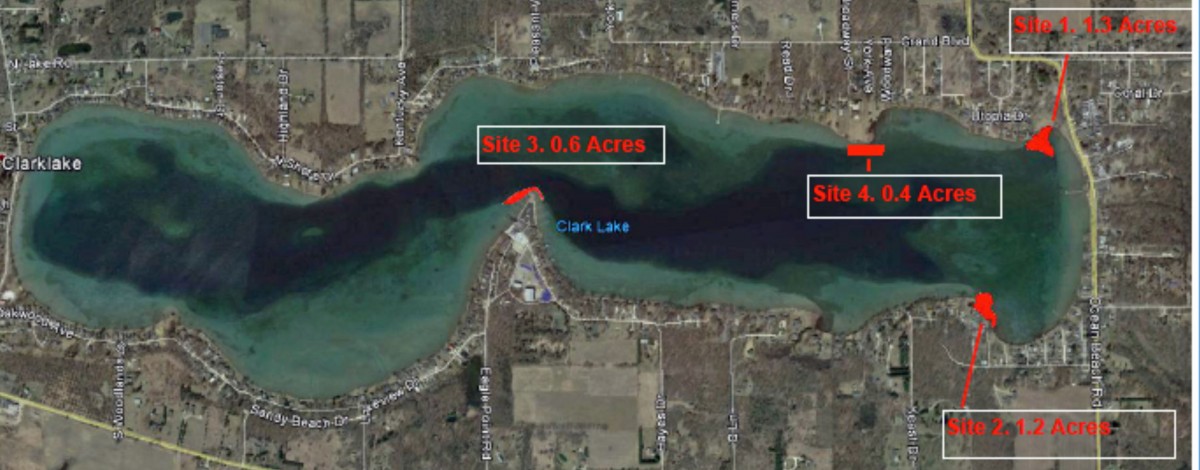
These four areas, a small portion of the 20 acres of infestation, will be treated in 2015 through donations to the Clark Lake Spirit Foundation
Supported by donations, four small areas of the lake will be treated this year. You can view the locations in the accompanying illustrations. This week, a fisheries biologist from Professional Lake Management will survey Clark Lake to see if timing is right to begin treatment. For treatment to be effective, the HEWM must have started its seasonal life cycle. Typically, this happens early in the season, an ideal time to treat before native plants begin to grow and there is less recreational use of the lake.
To legally treat the remainder of the 20 acres, it’s necessary to set up a Special Assessment District (SAD), and the petition drive is a first step. The SAD will have a 7 year term, beginning in 2016. The cost will be added to property taxes collected by the Township and will be $85 for the first year. That cost may decline in future years if the experience of Clark Lake parallels other lakes in the area.
Quick action works best in thwarting the advance of this aquatic invader. Your signature on the petition will indicate that you support the formation of a SAD.
It’s clear that many lakefront property owners are not yet at the lake. If you are one of them and wish to support this activity by signing the petition, you can request that a petition be emailed to you. For the petition to be counted by the Township, the following steps should be taken.
There is pre-printed petition form for each piece of lakefront property that lists the owner(s). Each owner (or owners) should sign in the appropriate location on the form. The signature of each signer must be witnessed by someone known as a “circulator”. The circulator must be someone other than the owner(s). After the circulator witnesses the signature of the owner(s), he or she prints and signs his or her name and address. The completed form should then be returned by US Mail. To initiate this process, your request should be emailed to clarklakespirit@gmail.com.
An info sheet covering frequently asked questions has been put together and will soon be available in print. Below, you can preview the FAQ section. There are a couple of clarifications in this version of the FAQs.
FAQs
Who may sign the petition?
Only lakefront property owners. If a property is held jointly, all owners must sign for that piece of property or “parcel.” It is not necessary to be a Michigan resident to sign the petition.
What does the circulator of the petition do?
The circulator takes the petition to lakefront property owners and asks them to sign it. The circulator must witness the signing, and confirm this by signing his or her name in the appropriate section of the form. There are no requirements of residency or ownership to be a circulator, but he or she must be someone other than the signer of the petition.
What does the petition look like?
There is a separate sheet for each lakefront property. The form includes the parcel ID number, the name(s), and address of the owner(s). Scroll down to view a sample petition.
How do I pay the $85 fee?
It will be included as a separate line item on property tax bills of lakefront owners.
Since invasive weeds can enter the lake by boats that have been elsewhere, shouldn’t there be hoses at boat launches and a requirement to wash boats before they go into the lake?
Unfortunately this worthwhile idea presents both infrastructure and enforcement challenges. Runoff from the boat washing must be collected, and there are strict rules in transporting it. It’s important to note that HEWM is already established and no amount of boat washing will diminish its ever growing presence in Clark Lake. HEWM also arrives through visiting wildlife. Geese that have been at another lake in the morning may visit Clark Lake in the afternoon. The “results” of their HEWM breakfast are then deposited in Clark Lake. That’s enough to start new colonies of HEWM.
Is there any way to control public boat access to the lake, and shouldn’t people who do use the lake be required to help pay for weed control?
This is a question for Columbia Township, Jackson County and the DEQ. It’s beyond the scope of the Committee.
Once HEWM is treated, what happens to the resulting biomass? Won’t this create more muck?
By not treating HEWM, there will be much more of it; and therefore, more muck. Early treatment will minimize the amount of biomass that sinks to the bottom.
Zebra mussels came and went. Won’t the same thing happen to HEWM?
The decline of zebra mussels was caused by a reduction of nutrients in the water that correlates with the installation of sewers. The growing number of zebra mussels also reduced the nutrient level forcing a self-correction of their numbers. HEWM is completely different. From the study of infested lakes, no evidence suggests that it departs on its own; it only gets worse. HEWM creates a level of density that curtails boating, destroys wildlife habitat and reduces property values. One report said that ducks walked on top of infestations; another eyewitness watched muskrats, not swimming through it, but walking on top of it. Try running a boat through the infestation around the County Park at the east end. It’s a no-go.
Do fertilizers used by some residents cause the weeds to propagate?
Fertilizer encourages the growth of all aquatic plant life, should it wash into the lake. But eliminating fertilizer will not stop the spread of HEWM.
What water depths does HEWM grow in?
HEWM will grow in 20 feet of water right up to the shoreline.
How do you treat HEWM?
The two herbicides that are typically used target the invasive weeds, but do not affect native plants. Their use is approved by several agencies including the DNR/DEQ and EPA. Neither the American Cancer Society nor U.S. Toxicology Program has listed the herbicides as a carcinogen. There are no known detrimental effects to humans, pets and wildlife. All treatments will be applied by professionals and done by permit with all rules rigorously observed.
What about swimming in the lake after the treatment?
The herbicides are in common use—you may have some in your garage right now. If you mistakenly got a small amount on you while spraying dandelions, you’d likely have a far greater dosage than from swimming in the lake right after treatment. There is a 24-hour swimming restriction that applies only within 100 feet of the treatment areas.
Will my well be contaminated?
No. Testing has shown no trace of contaminants from wells in treatment areas.
How long do the herbicides last in the water?
Renovate, the herbicide used within 250 feet of shorelines and 2,4-D which will be used more than 250 feet from shore may be detectable for several days, up to a week. Though still detectable, the concentrations are greatly reduced from the target concentrations. These two herbicides have no irrigation restrictions for lawns, but they do for some ornamentals. The company performing the treatment indicates that they are required to post 120 days for Renovate for ornamentals, but “our sampling has shown within 3 to 5 days after treatment it is non-detectable.”
Will Roundup be used in Clark Lake?
Roundup will not be used in Clark Lake.
Can herbicides be applied early in the season before the lake is being used for recreation?
Spring is the ideal time for application. HEWM is one of the first plants to grow in the spring and begins to spread before native plants start their growth cycle. This allows for easier targeting.
What’s the worst downside of using herbicides in the lake?
It’s possible that treatment will not find every plant. One tiny stem or leaf can generate millions of new plants. This suggests the need for ongoing treatment. After treating all areas of known infestation, experience shows that the degree of infestation declines markedly. For that reason, subsequent treatments can also be greatly reduced. Devils and Round Lakes recently found less need for treatment, and costs to property owners were reduced (read newspaper article).
Aren’t there solutions other than herbicides?
Many other lakes in our region have faced the same problem. Clark Lake is benefiting from their experience. The Committee exhaustively researched solutions that have been tried, and their effectiveness (scroll down under Invasive Weeds for more detail). Here’s a quick summary:
• Harvesting (cutting) – This is the worst solution; cuttings will cause many more plants to propagate.
• Weevils that eat Eurasian milfoil – This was found to be ineffective and the weevils are no longer distributed.
• Sterilized carp – This is illegal in Michigan.
• Suction harvesting – With divers removing plants by hand, there are risks that splinters will cause spreading and roots left behind will reestablish the plant. To remove 20 acres by divers would not be possible in one season, and costs would be exorbitant.
• Mats – the DNR/DEQ permits placement only in small areas, and this would cover only a minute fraction of the 20 acres. Mats are known either to float away causing navigational hazards or to be become mired in muck. Regulations require that they must also be periodically removed. Once removed the invasive weeds reestablish themselves.
• Aeration – Installing electrically operated bubblers in a lake as deep as Clark Lake in all the affected areas would be a logistical nightmare–and very costly.
What has been done to inform the public?
The topic has been covered thoroughly on this website. A public information meeting was held in the Columbia High School auditorium in December 2014. About 90 residents attended, asked questions and made comments. After the presentation and Q&A, a straw vote revealed nearly unanimous support for the proposed treatment. At the conclusion of the meeting, a member of the audience rose and made this comment: “I don’t like the idea of using chemicals in the lake, but I like even less the idea of losing the lake that we know–therefore I support the treatment program.” As this was being said, heads nodded in agreement, followed by applause.
DEQ Approves Four Milfoil Treatment Areas – April 14, 2015
As readers of this website have learned, DNA evidence confirms the presence of hybrid Eurasian water milfoil (HEWM) in Clark Lake. If unchecked, this invader spreads quickly. This can result in the destroying of natural habitat, curtailing recreational uses of the lake (like boating, swimming and fishing), and threatening property values. The Clark Lake Invasive Species Committee has formed to deal with the problem.
Four HEWM sites have been targeted for this spring. John Deming, Committee chairman, says “the DEQ has issued a permit” for these sites and that “a tentative schedule will arrive shortly.” Land owners in the affected areas have already given their assent for the treatment in the offshore area in line with their property. Those affected will soon receive schedule information and will also be reported on this website. The work will be performed by Professional Lake Management, also known as PLM.
The cost of the four treatments this year are being covered by donations. The Clark Lake Spirit Foundation is receiving donations on behalf of the committee and disbursing funds to cover the expenses. Donations to the Foundation are tax advantaged.
The four treatments scheduled for this year cover only a portion of the 20 acres of HEWM in the lake. Given the tendency of this invasive weed to spread rapidly, why not treat all 20 acres this year?
Here’s the explanation:
The 2015 areas of treatment are only possible with the permission of lakefront landowners in an area determined by their property lines extending out into the lake, but not to exceed 250 feet from the shore. These are called “riparian rights.” The reason for the 250 foot limit is that it’s difficult or impossible to determine the riparian rights beyond that point. The extended property lines begin to cross and/or converge creating an undecipherable spider web.
As noted above, the 2015 treatment will affect only a fraction of the infestation. Making treatment permissible wherever needed is something called a Special Assessment District (SAD), but this takes time. Members of the Committee have been working with Columbia Township officials to create a Clark Lake SAD to enable treatment by 2016. In addition to making possible treatment wherever needed, the SAD will have the ability to finance the work by collecting funds as an add-on to property taxes. A current estimate of annual cost to each lakefront landowner is not expected to exceed $100. The experience of other lakes has shown that after the initial year of treatment, the cost can decline significantly. A recent news article tells the story of some nearby lakes.
There are several steps to establishing the SAD. The Committee will be asking lakefront owners to sign a petition to present to the Columbia Township trustees. There will be two public hearings with published notices. Once the SAD is approved and created by the Township, treatment can be scheduled. Current plans call for a seven year “life” for the SAD. It can be renewed after that, if needed.
Below are two photos from the air of the same area–in front of the County Park at the east end. The first photo was taken in 2013; the second, in 2014. Note the increase of HEWM in this area. (Scroll beyond photos for more story).
The Committee held a public information in December. A straw vote was taken to ascertain whether the 89 people attending favored the direction of the Committee. The nearly unanimous vote supported the Committee’s analysis and plan. One person who has been at Clark Lake for all 70 of his years, commented: “I don’t relish the idea of herbicides in the lake, but after hearing the pros and cons, I think this is the only way to move forward. I do not want us to lose the lake we’ve always known. Therefore I’m supporting the current direction of the Committee.” Observers in the audience noted that heads nodded in agreement.
Other lakes in our region have faced their own struggle with HEWM. There is a kernel of good news in that. Clark Lake does not have to “reinvent the wheel.” The residents and Committee can learn from the experience of others. The approach outlined by the Committee draws greatly on these experiences.
Invasive Weeds: Progress Report – January 22, 2015
As reported on this website, DNA evidence confirms the presence in Clark Lake of hybrid Eurasian water milfoil (HEWM), which spreads rapidly. Other lakes invaded by HEWM have found that it severely curtails recreational use, destroys wildlife habitat, and is detrimental to property values. A study from September 2014, supported by the Clark Lake Spirit Foundation, revealed 20-acres of the invader in the lake. A group of mostly Clark Lake residents has formed to deal with the problem. The Clark Lake Invasive Species Committee is working with the Clark Lake Spirit Foundation which receives tax advantaged donations and disburses them on behalf of this project.
With donations received so far, it will be possible to treat four areas of infestation in spring of this year:
The Committee is also working with Columbia Township to set up a Special Assessment District (SAD) to eradicate or control the HEWM in 2016. Some people have asked “why wait to 2016”? Here’s the explanation:
The 2015 areas of treatment are only possible with the permission of lakefront landowners in an area determined by their property lines extending out into the lake, but not to exceed 250 feet from the shore. These are called “riparian rights.” The reason for the 250 foot limit is that it’s difficult or impossible to determine the riparian rights beyond that point. The extended property lines begin to cross and/or converge creating an undecipherable spider web.
Residents in the treatment areas for 2015 have given their permission. It’s expected that the treatment will take place after the thaw in early spring. This timing is ideal. The HEWM is already present, but the native plants have yet to start their growth cycle, and the lake is lightly used at this point.
The 2015 treatment, financed by voluntary donations, will affect only a fraction of the infestation. Making treatment permissible wherever needed is something called a Special Assessment District (SAD), but this takes time. Members of the Committee have been working with Columbia Township officials to create a Clark Lake SAD to enable treatment by 2016. In addition to making possible treatment wherever needed, the SAD will have the ability to finance the work by collecting funds as an add-on to property taxes. The cost to each lakefront landowner is not expected to exceed $100 (estimate) per year. The experience of other lakes has shown that after the initial year of treatment, the cost declines significantly.
There are several steps to establishing the SAD. The Committee will be asking lakefront owners to sign a petition to present to the Columbia Township trustees. There will be two public hearings with published notices. Once the SAD is approved and created by the Township, treatment can be scheduled. Current plans call for a seven year “life” for the SAD. It can be renewed after that, if needed.
On Tuesday (January 19) several Committee members outlined these plans at an open meeting of the Columbia Township Trustees. In December, the Committee held a public information meeting at Columbia Central High School to explain the seriousness of the threat. For a detailed review of that meeting, please scroll down.
Other lakes in our region have struggled with HEWM. There is a kernel of good news in that. Clark Lake does not have to “reinvent the wheel.” The residents and Committee can learn from the experience of others. The approach outlined by the Committee draws greatly on these experiences.
Below are two photos from the air of the same area–in front of the County Park at the east end. The first photo was taken in 2013; the second, in 2014. Note the increase of HEWM in this area. (Scroll beyond photos for more story).
At the December public information meeting, a straw vote was taken to ascertain whether the 89 people attending favored the direction of the Committee. The nearly unanimous vote supported the Committee’s analysis and plan. One person who has been at Clark Lake for all of his 70 years, commented: “I don’t relish the idea of herbicides in the lake, but after hearing the pros and cons, I think this is the only way to move forward. I do not want us to lose the lake we’ve always known. Therefore I’m supporting the current direction of the Committee.” Observers in the audience noted that heads nodded in agreement.
The work on this project began in August 2014. To learn more, scroll down. All stories about HEWM on this website can be found here. This website will continue to follow the progress of the Committee as they work towards the eradication or control of this invasive weed.
Invasive Weed Public Meeting – Q&A’s – December 11, 2014
As previously reported, the Clark Lake Invasive Species Committee is addressing the hybrid Eurasian Water Milfoil (HEWM) threat that now covers 20-arces of the lake. It propagates wildly and spreads quickly. In other lakes it has severely curtailed boating, swimming and fishing; destroyed natural habitat for wildlife; and negatively impacted property values. Its presence has been confirmed by DNA testing, and has been surveyed through a Clark Lake Spirit Foundation funded study of the infestation.
The Committee’s recent public information meeting on December 10, 2014, at Columbia Central High School, gave residents a chance to meet, hear about the problem and options for control, ask questions and get answers. The asking of questions came in two formats—through cards written, collected and given to the panel to answer; and later in the meeting, an open forum.
In the interest of space and clarity, what follows are paraphrased versions of both questions and answers. The purpose is to preserve the intent of the question and to provide credible, useful responses from those who have researched both the problem and solutions.
Since invasive weeds come into the lake by boats that have been elsewhere, shouldn’t there be hoses at boat launches and a requirement to wash boats before they go into the lake?
This is an idea worth exploring. But there are both infrastructure and enforcement challenges. Runoff from the boat washing must be collected, and there are strict rules in transporting it. It’s important to note that HEWM is already in the lake and no amount of boat washing will tamp its ever growing presence in Clark Lake. HEWM also arrives through visiting wildlife. Geese that have been at another lake in the morning visit Clark Lake in the afternoon. The “results” of their HEWM breakfast are then deposited in Clark Lake. That’s enough to start new colonies of HEWM.
Is there any way to control public boat access to the lake, and shouldn’t people who do use the lake be required to help pay for weed control?
This is a question for Columbia Township, Jackson County and the DEQ. It’s beyond the scope of the Committee.
Once HEWM is treated, what happens to the resulting biomass? Won’t this create more muck?
By not treating HEWM, there will be much more of it; and therefore, more muck. Early treatment will minimize the amount of biomass that sinks to the bottom.
Zebra mussels came and went. Won’t the same thing happen to HEWM?
The decline of zebra mussels was caused by a reduction of nutrients in the water that correlates with the installation of sewers. The growing number of zebra mussels also reduced the nutrient level forcing a self-correction of their numbers. HEWM is completely different. From the study of lakes that are infested, there is no evidence that it departs on its own; it only gets worse. HEWM creates a level of density that curtails boating, destroys wildlife habitat and reduces property values. One report said that ducks walked on top of infestations; another eyewitness watched muskrats, not swimming through it, but also walking on top of it. Try running a boat through the infestation around the County Park at the east end. It’s a no-go.
Do fertilizers used by some residents cause the weeds to propagate?
Fertilizer encourages the growth of all aquatic plant life, should it wash into the lake. But eliminating fertilizer will not stop the spread of HEWM.
What water depths does HEWM grow in?
HEWM will grow in 20 feet of water right up to the shoreline.
Isn’t 2,4-D in Agent Orange?
2,4-D was only one component of Agent Orange. The carcinogenic dioxin in Agent Orange is TCDD, a contaminant found in another component of Agent Orange, 2, 4, 5-T. Neither the American Cancer Society nor the U.S. Toxicology Program has listed 2,4-D as carcinogen. 2,4-D is regularly approved for aquatic use by the DEQ and is not banned by the EPA.
In Viet Nam, the defoliant Agent Orange, containing the TCDD dioxin, was applied in magnitudes of 10 to 100 times normal usage. Most people have some 2,4-D in their garage in the form of weed and feed or dandelion spray. If you got a small amount of that on you while spraying dandelions, you’d have a far greater dosage than from swimming in a lake right after treatment has taken place.
2,4-D has been in regular, safe, use since the 1940s. 2,4-D will not be used in areas within 250 feet of shorelines and its use is not planned for the pilot program in 2015.
Clark Lake is spring fed. Will 2,4-D contaminate my well?
No. Testing has shown no trace of 2,4-D in water from wells in treatment areas. The State is also reviewing rules with the purpose of scaling back the 24-hour swimming restriction and the 250-foot distance requirement from wells.
How long do chemicals last in the water?
Renovate, the chemical used within 250 feet of shorelines, leaves no trace after 24 hours; 2,4-D, slightly longer. If you have costly ornamental plants in your yard, it’s recommended that you wait 24 hours before using lake water on it if treatment has been performed in front of your house.
What’s the effect on wildlife? For example, if coots eat treated HEWM, and an eagle lunches on a coot, will the eagle be adversely affected?
No. There has been no evidence of detrimental effects on wildlife.
A questioner stated that Roundup has been banned in some areas. Why would we want to use Roundup in Clark Lake?
Roundup will not be used in Clark Lake.
Can herbicides be applied early in the spring before the lake is being used for recreation?
Early spring is the ideal time for application. HEWM is first to grow in the spring and begins to spread before native plants begin their growth cycle. This allows for easier targeting.
What’s the worst downside of using herbicides in the lake?
It’s possible that treatment will not find every plant. Given that one tiny stem or leaf can generate millions of new plants suggests that ongoing treatment is necessary. After initial full lake treatment, experience shows that the degree of infestation declines markedly. For that reason, subsequent treatments can also be greatly reduced.
It’s been said that one plant leaf can propagate 250-million new plants in one season. Isn’t this an exaggeration?
That number came from SePro’s corporate website. Anecdotal evidence suggests that this number is not far off. A Clark Lake resident who also lives on a Texas lake says that there the weed started small, but then exploded in growth and quickly made boating impossible.
Couldn’t sand and gravel be dumped on the ice in the winter so that when the lake thaws the weeds are smothered?
This solution presents a number of challenges. Here are some of them. There are 20-acres of HEWM in the lake, ice moves when it breaks up (the sand and gravel could land somewhere other than the target), and DEQ permission would be refused. Also, it is possible the HEWM would still survive.
Milfoil has been around a long time. Why not treat it privately and not involve the government?
The invasion of HEWM is recent. The native milfoil combines with the Eurasian invader to form a hybrid. This hybrid multiplies rapidly with the deleterious effects already mentioned. When control methods are used, proper government permits are required.
Would a resident who decided to treat on his own be held liable if something goes wrong?
Treatment requires proper permitting. Though this is not an attorney’s answer–legal exposure could be an issue for rogue activity.
This was not a question, but a comment from a member of the audience who rose to say: I don’t like the idea of using chemicals in the lake, but I like even less the idea of losing the lake that we know. Observers noted that heads nodded while it was being said and was followed by applause.
Do you have a question? Send it to clarklakespirit@gmail.com.
Panelists: Vic Marshall, Dr. Richard Moyer, Bill Leutz, Dr. Carley Kratz (RRWC), Steve Hanson (PLM), Scott Robbins (Director of the Jackson County Parks), Bill Tuttle. The Committee: John Deming, Richard Moyer, Bill Leutz, Vic Marshall, Bill Tuttle, Mike McKay, John Calhoun, Flip Reynolds, Ron June, Beth June, Hugh Harris, Scott Robbins, Steve Harris, Greg Kerr, Rick Belcher.
Advisers: Dr. Carley Kratz (River Raisin Watershed Council), Kevin Thomson (attorney).
Invasive Weed Public Meeting: First Look – December 10, 2014
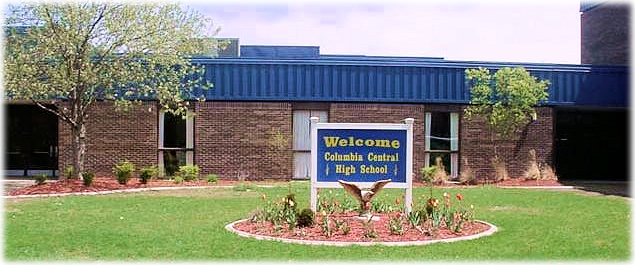 A group of 89 people, mostly Clark Lake residents, gathered at Columbia Central High School Wednesday evening for a public information meeting about the invasion of hybrid Eurasian water milfoil (HEWM) in the lake. A study funded by the Clark Lake Spirit Foundation revealed 20 acres of HEWM, known to propagate wildly. Other lakes have found that infestations curtail recreational activities such as boating, swimming and fishing; destroy natural habitat for wildlife; and negatively influence property values.
A group of 89 people, mostly Clark Lake residents, gathered at Columbia Central High School Wednesday evening for a public information meeting about the invasion of hybrid Eurasian water milfoil (HEWM) in the lake. A study funded by the Clark Lake Spirit Foundation revealed 20 acres of HEWM, known to propagate wildly. Other lakes have found that infestations curtail recreational activities such as boating, swimming and fishing; destroy natural habitat for wildlife; and negatively influence property values.
The Clark Lake Invasive Species Committee, a group of concerned lake residents, hosted the meeting. Previously the group voted unanimously to pursue a pilot program to treat some areas of infestation with herbicides during the 2015 season with the goal of full lake treatment in 2016. To read about Committee plans, please click here.
Dr. Carley Kratz, of the River Raisin Watershed Council, showed the importance of urgent action as part of her Power Point presentation to the group. Click here to view Dr. Kratz’s Power Point presentation.
Members of the committee answered questions for the audience. In subsequent posts on the website, you will be able to view questions asked and the responses given.
At the end of the meeting, a straw vote was taken. The question posed and the corresponding vote:
Those in favor of doing nothing: 1
Those in favor of exploring other options: 2
Those in favor of proceeding as outlined (use of herbicides): 86
Invasive Weed Public Meeting – December 9, 2014
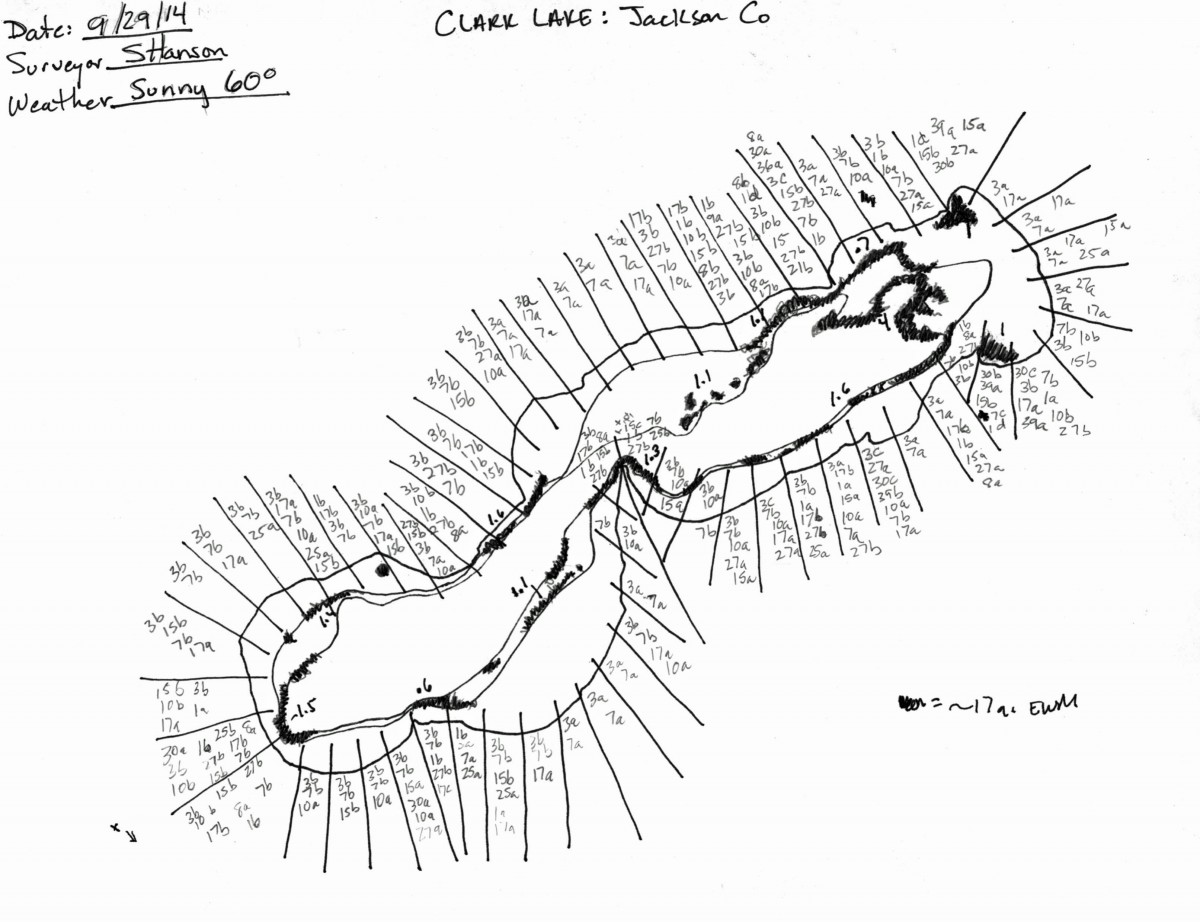
Map of HEWM in Clark Lake from the PLM study, fall 2014. Click or tap to enlarge; repeat, to reduce.
If you’ve been following the news on this website, you know that over 20-acres of hybrid Eurasian water milfoil is present in Clark Lake. This fast-spreading weed threatens to curtail recreational use of the lake, destroy natural habitat for wildlife and negatively impact property values. It’s been confirmed by DNA evidence and a study funded by the Clark Lake Spirit Foundation.
The group that has formed to address this threat, Clark Lake Invasive Species Committee, is holding a public information meeting tomorrow (Wed, Dec 10) at Columbia Central High School from 7 pm to 8 pm. The Committee has voted to pursue a pilot treatment program for 2015 using the services of Professional Lake Management (PLM). To learn about the threat and the safe use of herbicides, you may wish to attend this meeting.
The meeting will begin with a Power Point presentation from Dr. Carley Kratz of the River Raisin Watershed Council. A panel of lake residents and others who have researched the problem–and worked to find solutions–will address the issue and answer questions.
Recently the Directors of the Clark Lake Spirit Foundation voted unanimously to receive donations, hold the funds and disburse them on behalf of weed control through the Invasive Species Committee. Donations will be accepted at the meeting. The Foundation is a 501c3; and, as such, donations to it are tax advantaged. In the past, the Foundation has supported beneficial community activities such as the Spirit Trail, rebuilding the dam at Ocean Beach, and Community Center move to the County Park.
Fighting the Clark Lake Invader – December 5, 2014
The presence of Eurasian water milfoil and its hybrid (HEWM) has been confirmed in Clark Lake by DNA testing. This fast spreading weed threatens to curtail recreational use of lake, destroy natural habitat for wildlife and negatively impact property values. Efforts to thwart HEWM have gone into a high gear. Throughout this fall, a committee has researched the problem and examined options for control of HEWM. The Clark Lake Spirit Foundation funded a study both to research the extent of the infestation and to offer solutions.
The committee, now known as the Invasive Species Committee, has voted unanimously to launch a pilot program for spot treatment in 2015. It has always been possible for land owners to treat weeds along their shorelines with proper permits. Through this path, the committee will work with residents to treat weeds in areas of high density that are within the riparian rights of the land owner. (see note below about “riparian”)
Treating just some shorelines will leave much of the 20 acres of infestation untouched. Some of these areas are along drop offs too far from shore for riparian rights to apply. To get at areas like those, other lakes have formed special assessment districts (SAD). Establishing a SAD involves a time consuming process, so it’s not possible for treatment of this kind to take place before spring of 2016.
The word “assessment” implies cost to property owners. Divided among residents on the lake, the yearly assessment would be modest, probably under $50 per property. That of course is a minor expense compared to the known dramatic loss in property value that occurs when lakes become infested. Some have compared an assessment like this to the ridding one’s lawn of weeds–except its one’s “water lawn” that needs attention to preserve the future of the lake.
Committee members are reaching out to other residents at the lake and inviting them to attend a public informational meeting. Scroll down for more on this meeting. Committee members are John Deming, Mike McKay, John Calhoun, Flip Reynolds, Bill Tuttle, Hugh Harris, Bill Leutz, Steve Harris, Greg Kerr, Ron & Beth June, Vic Marshall, Scott Robbins, Dr. Richard Moyer, and Rick Belcher. The Committee is advised by attorney Kevin Thomson and Dr. Carley Kratz of the River Raisin Watershed Council.
Note regarding “riparian”. In a public lake like Clark Lake, property owners can extend there property lines out into the lake to a point of convergence in an imaginary center of the lake. In this area, the property owners have what is known as riparian rights. In practical terms for weed treatment, it means property owners must give permission for this activity in their area with a limit extending out into the lake of about 250 feet. Beyond 250 feet the path of these lines begin forming a spider-like web, making it impossible to determine where owners rights are. That’s why the 250 feet limitation ensures that one can be confident of one’s riparian rights.
November 21, 2014 – The Clark Lake Invader and Property Values
The invader–Eurasian water milfoil and its hybrid–is capable of changing the ecology of Clark Lake to the detriment of not only wildlife habitat, but also recreational activities like boating, fishing, and swimming. There is another issue that hasn’t had a lot of play in the discussion and strikes at the pocketbook: property values. Kim Dagenais is a realtor who lists in Jackson, Lenawee and Hillsdale counties. He comments that property owners who sell at lakes “that have an uncontrollable weed problem get next to nothing for their property; only the value of the house.” That suggests that the premium prices that Clark Lake homes command could change dramatically if the invader is not thwarted.
Concern about the spread of an invasive weed in Clark Lake is a hot topic. DNA evidence confirms the presence of Eurasian water milfoil and its hybrid (HEWM) at Clark Lake. A study, funded by the Clark Lake Spirit Foundation, indicates that this invader covers at least 20-acres of Clark Lake waters. It can be easily spotted along shorelines where props have not lopped off tops. In other areas it lurks just below the surface in depths of up to 20 feet.
An area of dense concentration is at the east end’s County Park. Recently this area was photographed from the air. To view the video, please click this YouTube link. (The segment is over six minutes long, and you won’t need to view the entire segment to get the picture).
https://www.youtube.com/watch?v=B8hkPitLdMg
Compare a satellite photo on Google Earth from just over a year ago to a still from this YouTube video taken this fall. The photos cover the same approximate area at the east end. First the satellite photo:
Google Earth satellite view from April 2013
These photos generate a warning.
The Invasive Weed Committee continues to work on a strategy to control HEWM at Clark Lake.
November 7, 2014
Concern about Eurasian water milfoil and its hybrid is growing as this invader spreads in Clark Lake. DNA testing proves that its here and a recent study funded by the Clark Lake Spirit Foundation indicates that there is already 20-acres of it in Clark Lake. It’s most visible at the County Park and in other locations along shorelines where the weed pokes above the surface. Where there is boat traffic, the tops are lopped off by props. That leads to the spread of the invader. One small cutting can multiply into 250-million new plants in just one season.
The experience of lakes in our region, as well as in other parts of the country, are a warning. Not only does an infestation curtail boating, swimming and other recreational uses of the lake, it destroys natural habitat for wildlife. Fish, turtles, migrating birds as well as native aquatic vegetation, struggle when this invader spreads. Recently Ann Swain took photos of turtles attempting to navigate Eurasian milfoil in a Texas body of water. The turtles could not swim through it. They paddled above it.
Another observer at a regional lake observed ducks struggling. They could not swim through this invasive plant–they walked on top of it!
This website reports on the problem and possible solutions. Most recently posted is a piece that describes some of the findings of the report paid for by the Clark Lake Spirit Foundation.
October 30, 2014

John Deming packages a weed sample that was sent to Grand Valley State University. DNA testing confirmed the presence of Eurasian water milfoil and its hybrid in Clark Lake
As previously reported on this website, DNA testing has confirmed the presence of Eurasian water milfoil and its hybrid in Clark Lake. Since then, a committee formed to discuss the problem. More recently, the Clark Lake Spirit Foundation, publisher of this website, funded a survey of the lake to determine the quantity and location of hybrid Eurasian water milfoil (HEWM), and also to outline options and recommendations for its control or eradication.
There is an active movement at Clark Lake to thwart the invasion of this weed. Among those involved is John Deming, who comments: “At other lakes, infestations like this simply take over. Swimming, boating, fishing and general lake use is greatly curtailed. One lake reported that ducks, instead of swimming over the weeds, actually walked on top of it.”
The survey of the lake was performed by Professional Lake Management in September. A key takeaway from their report is the sheer amount of HEWM already in the lake. The invasive weed is present in over 20-acres of our lake. While you can see the weeds topping the water in areas like the County Park, much more of it is evident in deeper waters along drop offs.
That leads to another problem. The plants grow to the surface in deeper areas where boats travel. In those areas, props lop off the tops. John Deming goes on to say “What’s more unnerving, is ability of this invader to spread. One cutting the size of a pine needle can create 250-million new plants in just one season.”
The Professional Lake Management (PLM) is clear about the threat. “Eurasian water milfoil is extremely invasive and can inhabit a variety of sediment types and water depths.” The report notes that the weed “forms a canopy above native plants, choking out the competition. [It] also has the ability to overwinter underneath the ice… This gives the plant a head start in growing during the spring and chokes out native plants very quickly. [HEWM] should be controlled as soon as it is found within a lake to prevent further infestation…”
The PLM report presents solutions, most of which have been explored in previous articles on this website. For a compendium of these stories, please click here.
 The lake was inspected and the report produced by Steve Hanson who has a M.S. degree as a fisheries biologist. In his study of Clark Lake, he carefully noted the various kinds of native aquatic vegetation as well as documenting the HEWM. Please click here for an expanded view of the map and additional detail showing locations and density.
The lake was inspected and the report produced by Steve Hanson who has a M.S. degree as a fisheries biologist. In his study of Clark Lake, he carefully noted the various kinds of native aquatic vegetation as well as documenting the HEWM. Please click here for an expanded view of the map and additional detail showing locations and density.
The experience of other lakes offers a lesson. The HEWM is a fast growing invader and it is better controlled early rather than letting it spread widely. It’s interesting how many times one hears from outsiders about the beauty of Clark Lake and how the lake hosts many activities on its waters. Who would want this to change! This website will continue to offer information and progress on steps being taken. If you would like to be involved, please contact John Deming at 529-9117 or jcdcl@comcast.net.
October 17, 2014
 The State of Michigan is concerned about invasive species, and is putting money into a grant program to help deal with it. Rep Mike Shirkey, in a press release today, points to its purpose to “prevent, detect, eradicate, and control terrestrial and aquatic invasive species.” His release says that a minimum of $3.6 million up to $5 million will be available for the 2014 grant cycle and that “this program may be of value to communities like Clarklake.”
The State of Michigan is concerned about invasive species, and is putting money into a grant program to help deal with it. Rep Mike Shirkey, in a press release today, points to its purpose to “prevent, detect, eradicate, and control terrestrial and aquatic invasive species.” His release says that a minimum of $3.6 million up to $5 million will be available for the 2014 grant cycle and that “this program may be of value to communities like Clarklake.”
The Eurasian water milfoil and its hybrid pose a significant threat to Clark Lake. Other lakes have been forced to deal with it after entire sections of their lakes became unnavigable. Fishing, swimming, boating and general uses of their lakes were greatly curtailed. One lake reported that the infestation of weeds was so thick that ducks were seen, not swimming through it, but walking on top it. The problem is exacerbated by the invader’s ability to multiply quickly. One cutting the size of a pine needle can produce up to 250-million new plants in one season.
Because of the severity of this threat, the Clark Lake Spirit Foundation is funding a survey of the lake to locate the invader and determine the extent of infestation. The report will include proposed solutions. Details will be known soon, but one early takeaway is that there is far more Eurasian water milfoil and its hybrid than originally thought.
This website has a section devoted to the problem–in depth research of the topic and what other lakes have done to control it. Click here to read about it.
September 25, 2014
![]() The Clark Lake Spirit Foundation has voted to support further investigation of an invasive weed that threatens to affect Clark Lake adversely and bring about radical change. The Eurasian Milfoil has found its way into Clark Lake and formed a hybrid with a native weed. This invader and hybrid are known to multiply rapidly. The Eurasian Milfoil has overtaken some lakes in a year or two, making navigation and other lake activities difficult or impossible. Just a small leaf can form 250-million new plants in one year. At one lake where open water once existed, a resident reported that the weeds were so thick that ducks were seen walking on top of it.
The Clark Lake Spirit Foundation has voted to support further investigation of an invasive weed that threatens to affect Clark Lake adversely and bring about radical change. The Eurasian Milfoil has found its way into Clark Lake and formed a hybrid with a native weed. This invader and hybrid are known to multiply rapidly. The Eurasian Milfoil has overtaken some lakes in a year or two, making navigation and other lake activities difficult or impossible. Just a small leaf can form 250-million new plants in one year. At one lake where open water once existed, a resident reported that the weeds were so thick that ducks were seen walking on top of it.
DNA testing at Clark Lake has confirmed presence of the Eurasian Milfoil in at three locations–the County Park, Hancock Point, and the sandbar at the west end (in a line between Mud Point and the pineapple on the north shore). It’s thought that the plant has spread to several other locations as well.
The support offered by the Clark Lake Spirit Foundation will help ascertain the current degree of Eurasian Milfoil infestation in the lake along with recommendations for its effective, safe and ecologically friendly control. Most other lakes in our region have already faced this threat. Clark Lake has the advantage of early detection and the ability to learn from the experience of other lakes.
In voting to support this work, the Foundation is true to the mission statement “Standing Up for Clark Lake.” In the past the Foundation paid for rebuilding the weakened infrastructure of the dam at Ocean Beach, financed in part and provided expertise to move the Community Center to the County Park, and improved the cemetery at the head-of-the-lake. The Foundation also supports this website and its DamCam which provides viewers anywhere in the world live 24/7 video of the dam at Ocean Beach.
September 25, 2014
DNA evidence has confirmed that an invasive weed has found its way to Clark Lake. Eurasian Milfoil has combined with a weed native to Clark Lake to form a hybrid. A thorough investigation reveals the immensity of the threat. One leaf of this plant or its hybrid can propagate over 250-million new plants, and do it quickly. Lakes that have faced this same invasion have found that it doesn’t take long for this weed to take over—within a year or two. This weed targets areas less than 15-feet in depth and tops out at or near the surface making navigation and other use of the lake impossible. Imagine the areas less than 15-feet deep, tangled with this invader. You would only be guaranteed clear sailing over the trench formed by the ice-age glacier that runs from one end to the other.
Presence of the invasive weed has been confirmed in three locations at Clark Lake. But it is by no means limited to those areas. A visual inspection of other areas tells the story that there is far more of this infestation in the lake right now than previously realized. Yet, there are two pieces of good news. Compared to some other lakes, this infestation has been detected early. Secondly, Clark Lake is not the first to experience this problem. Many lakes around the country and most of those nearby have had to deal with this problem. As residents, we are not forced to reinvent the wheel. We can learn from the experiences of other lakes in our area—what works and what doesn’t work. That information is available. Many hours of research on my part and others have been directed at assembling this knowledge to form a guide to effective solutions.
It is important to face two uncomfortable facts. The infestation is here to stay and will quickly become worse if we do nothing. Do nothing and our advantage of early detection is squandered. Secondly, there is no perfect solution. Each approach has one or more drawbacks.
In working towards a recommendation, the process has been to eliminate approaches that have a limited chance of achieving results or that create unintended ecological damage. A detailed discussion of these approaches, their pros and con, can be viewed by clicking here. Flaws in the following solutions are serious enough to eliminate them from recommendation: harvesting (each clipping is capable of creating 250-million more plants per year), weevils (they eat the milfoil but with mixed success and will no longer be available), bubblers (costly and not suitable for lakes that are both shallow and deep), and benthic barriers (logistically intensive, create navigational hazards, have ecological problems–and probably would not be approved by the DNR/DEQ for the large area needing treatment). That leaves one solution—herbicides. Properly chosen and managed herbicides have proven safe to humans, animals, fish and other wildlife. They target the invasive plant and its hybrid and not all plant life.
As this research project began, herbicides were at the bottom of the list. Who wants to use them if you don’t have to? And bringing them up as a solution is no way to win a popularity contest. But as often happens, the learning process causes one’s mind to open. That’s why herbicides are currently used in Lake Columbia, Wamplers Lake, Lake LeAnn, Michigan Center, Devils, Round and Vineyard Lakes. Our research shows no other solutions being used in Jackson, Lenawee or Hillsdale Counties. Discussions with the DNR/DEQ indicate that when herbicides are used properly by professionals, they are the correct method. In future articles, you will read about the paths other area lakes have followed. We can benefit by learning from their missteps and by understanding how they achieved their successes.
Experience at other lakes also shows that a minority will oppose herbicides. Individuals who feel this way should research solutions for themselves. They can access original documents by clicking here. Those who don’t wish to defend the lake in this manner should ask themselves, “what is the solution that is both effective and economically feasible?”
Our lake is at a turning point. And time is of the essence. We are all united in our love of Clark Lake. Most of us are here because we want to be and may have sacrificed to do so. Most importantly we need to keep our eyes on the prize: the health of our beautiful lake for our generation and generations to follow—without causing harm to anyone or anything except the invader.
-John Deming
September 17, 2014
Concern is growing over an invasive weed that has taken root in Clark Lake. This weed, the Eurasian Milfoil, has formed a hybrid version that has characteristics of both the native plant and the invader. The invader and the hybrid multiply wildly. One organization comments that the weed takes over a lake “choking out native plants and severely impacting all recreational uses—in many cases, growing so thick that boats are unable to navigate.” DNA testing confirms the weed’s presence in three Clark Lake locations—near the County Park, Hancock Point, and the sandbar at the west side of the lake (in a line between Mud Point and the pineapple). It’s very likely that the invader can found in several other locations around the lake.
To put the threat into perspective, one firm found that a “single piece of fragmented Eurasian milfoil can multiply into 250-million new plants in one year.” It’s been found that this weed can take over a lake in two years. At one lake, the infestations were so thick that ducks were “walking on top of it.”
Recently this website reported on the Clark Lake Clear Water Committee, a group of 11, who surveyed the DNA-confirmed infestations at the County Park and Hancock Point. They then met to discuss options. (You can read about the participants and results of that meeting by clicking here.) Since then, two individuals, Beth June and John Deming, spent many hours researching options to control the weed.
The good news is the early detection of the invader’s arrival. Dealing with it swiftly is the best defense against a problem never faced before at Clark Lake. A summary of the research follows. It includes a brief discussion of each option, noting the pros and cons.
Harvesting
Harvesting Pro
This method temporarily removes the weeds by mechanically cutting them.
Harvesting Con
The harvesting creates clippings. A piece as fine as one leaf is enough to start a new colony. Of all solutions, this is generally recognized as the worst. One fragment can create 250-million new plants in one year.
Weevils
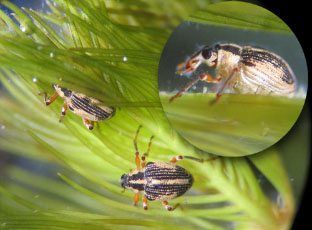
Milfoil weevils (Euhrychiopsis lecontei). Photos courtesy of Tom Alwin and Michigan State University Department of Fisheries and Wildlife
Weevils Pro
This is a biological approach that has shown some success in controlling the Eurasian milfoil and its hybrid. It appears to have little or no negative impact on the environment. Weevils are applied to the infestation where they target Eurasian milfoil. They then feed on the stalk, killing the plant.
Over the course of a summer, there may be several hatchings of these weevils. At the end of the season, the last of the larvae emerges, develops wings, and finds its way to shore and winters there, presuming it can find habitat such as debris.
Weevils Con
Only one firm is known to provide weevils for this purpose–EnviroScience. They are discontinuing production in spring.
The most recent cost was $1.20 per weevil plus shipping. Between 1500 and 2000 weevils are required for each acre of infestation, with reapplication sometimes necessary. The success rate has been mixed. It appears that the use of weevils does not command a sufficient price to warrant the supplier to remain in this business.
There are several reasons for lack of success. One is that the weevil is less effective in lakes that have populations of blue gills and sunfish. Those fish, plentiful in Clark Lake, find the weevil quite tasty.
The supplier has had difficulty with state regulators in shipping the weevils. In order to keep them alive during shipping, they must be accompanied by Eurasian milfoil. When the weevils are applied to the targeted area, they are accompanied by the tagalong Eurasian milfoil.
Mats (seasonal benthic barrier)
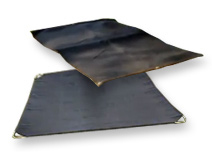 Mats Pro
Mats Pro
Mats offer a mechanical solution that kills off weeds, native and invasive, where applied. The mat blocks the sunlight from reaching the plant which deprives it of photosynthesis, and all weeds under it perish.
Mats Con
Installation and maintenance are key points. If not installed properly, they become navigational hazards to boats and dangerous to wakeboarders and skiers. Mats tend to migrate because of wave action in shallow water. In deeper areas, they may be hooked by fishing lures, dragged by anchors–or in any kind of depth, be open to mischief. Should the mats float off to deeper waters, they may be lost forever.
When mats stay in place, other problems develop. The mats blanket the weeds and trap the rest of the ecosystem below it, killing off whatever is there—good or bad. As the weeds die, the decomposition emits a gas. This gas may balloon the mat and lift it from the bottom and shift its location. A mat, or a piece of it, could rise to the surface or just below it and be hit by a boat or skier. When mats stay in place, silt and muck accumulate on top of the mat, providing a place for vegetation to grow. The first plant to reappear is the Eurasian milfoil and its hybrid.
There are daunting logistical concerns. County Park, a shallow area, is not the only place of infestation. The weed has also been confirmed at the sandbar at the west end of the lake, where the area surrounding the Eurasian milfoil and its hybrid is very deep. Muck and deep water increase the difficulty of laying and maintaining mats.
There are permitting issues. At this point, the DEQ in Jackson is unsure if they would issue a permit. That concern is heightened if the mat is permanent. If it is classified as seasonal (3- months), concern is less. But that creates a logistical responsibility–removing the mats every season. Also they must be cleaned regularly to rid them of accumulated silt and decayed matter. If a mat is not periodically turned over, they become buried, making future turning or moving impossible. This kind of maintenance is a necessary if they are to be effective. So the question–who would be responsible for placement and maintenance on an ongoing basis?
This leads to another concern–cost. To cover all three areas (and there are likely more) would be costly. The Lake Mat Pro has a rigid, weighted frame (48 lbs.) and covers 280 square feet (12 ½ x 24) and costs $359 plus $45 shipping per mat. To cover about one acre, 155 mats would be required at a cost over $62,000. Another product, called the Lake Bottom Blanket, is less expensive, but does not have a rigid frame and appears not to be porous. The 10 x 50 size costs $330 plus $19 shipping. If water cannot freely flow through the fabric, moving or turning it becomes difficult to impossible.
Finally, a manufacturer opined that attempting to cover an area over 1600-square feet would likely fail to be permitted by the DEQ.
Bubblers
Bubblers Pro
At Michigan’s Paradise Lake, bubblers were installed in 400-acres. This cleared the area of Eurasian milfoil where weevils had previously failed.
This is an electro-mechanical solution similar to what is already used at Eagle Point Marine during the winter to keep ice away from their docks. Electrically powered pumps force air through hoses that keep the water in motion.
Bubbles Con
The cost of the Paradise Lake project was high–$200,000. This amount is being defrayed through a mandatory levy on property owners. This solutions tends to work in shallow water where electrical power and other infrastructure support is available. Unlike Paradise Lake, which is primarily shallow, the depths of Clark Lake vary from shallow to deep.
There is a DEQ concern that the widespread use of bubblers could have a harmful effect caused by aeration of the water.
Herbicides
Herbicides Pro
Herbicides are effective. At Clark Lake the arrival of Eurasian milfoil and its hybrid infestation is recent. Because it has not yet covered a large area, it is controllable by spot treatment with herbicides. Designer versions of herbicides target only Eurasian milfoil and its hybrid. The herbicide can be applied early in spring when the good weeds are dormant but the Eurasian milfoil has already started to grow and the lake is used only lightly for recreational purposes. Some products have only a 24-hour swim advisory in the target area, no fish ban, and limited irrigation concerns.
In several ways, this solution offers fewer ecological downsides than some other options. Mats kill all weeds and anything trapped below them and create hazards on the surface. Herbicides do not have the ecological downsides of bubblers–water aeration.
Several lakes in the area use herbicides. Lake Columbia is one of them and employs the services of Professional Lake Management. PLM’s Steven Hansen says that a variety of products are used and selected based on water depth, location and how individual plants have reacted to past treatments. Some of those products are Sonar, Diquat and Renovate. Any product used is designed to target the invader and do not eliminate all weeds. PLM also treats Wamplers Lake where a recent letter to the editor in the Exponent was critical of the results. Hansen’s response was that the program does not kill all weeds, but leaves the good ones in place. He believes that is what some people react to, and points out that some weeds are necessary to keep a lake in proper ecological balance.
Compared to other options outlined in this article, herbicides are cost effective. An example is AccRenovate OTF, manufactured by Sepro. Progressive AE, a water-management consulting firm, estimates using 120 to 200 pounds of the product per acre costs $450 to $750. That cost includes installation by Professional Lake Management.
In considering the safety advisories listed by the manufacturer, it’s important to distinguish if those advisories apply to the installer, residences very close to the spot application, or the lake as a whole. The material safety sheet applies to the installer.
Herbicide Con
Research has proven that the products that are being considered have no negative effects for swimmers, wildlife, fish, etc. However, those who may not take time to read and study the research may still have a negative knee-jerk reaction to this approach and be unalterably opposed.
Conclusion of the Researchers
The research was conducted by two individuals operating independently. Then results were compared to determine if there were discrepancies and to ensure thoroughness. The task included scouring the web, reading and taking notes on reports, and engaging in telephone interviews. Summaries, reports and source links can be found by clicking here.
The researchers, and some others, were initially most attracted to biological or mechanical control. As data accumulated, the notion that this problem could be addressed in those ways diminished.
The truth is, Clark Lake potentially faces a big problem, and there is no ideal solution. The researchers emphasize the good news–early detection. They believe with quick action, it can be controlled to the point where it tends to disappear from everyday view. This will only happen if action is taken now and time is not wasted on faulty solutions. Time is of the essence. The researchers suggest that the careful and lawful application of herbicides offers the quickest, most cost effective and least-ecologically intrusive solution. They hope that anyone reading this approaches the topic as they did: by taking time to read and review the research with thoughtful consideration to the severity of the threat and the practical options available.
September 13, 2014
DNA testing confirms that an invasive weed is now present in the lake–the Eurasian milfoil and its hybrid. There is urgency to this threat. The invasive plant and its hybrid are known to multiply rapidly and make waterways unusable. The most visible evidence at Clark Lake is at the County Park.

The invasive weed typically reaches the surface and destroys the usefulness of the affected areas. In areas where there is a lot of boat traffic, the tops are cut off. These tops then migrate to other areas and form new colonies.
Because this threat is deemed real and immediate, a group has formed to look into solutions–the Clark Lake Clear Water Committee. On Friday, this group of 11 visited by raft, two of the three sites on the lake where evidence of the hybrid of Eurasian milfoil has been confirmed–the County Park and Hancock Point.
The group concluded that there is no perfect solution–each option has problems. But all agreed that the problem needed to be addressed–now.
Options discussed were weed harvesting, bubblers, weevils, mats and herbicides. Weed harvesting had the least appeal. When a harvester cuts the weeds, the clippings migrate to other areas and start new colonies. Dr. Carley Kratz told the group that “just one small leaf” of the Eurasian milfoil or its hybrid was enough to trigger new areas of growth. Dr. Kratz, of the River Raisin Watershed Council, traveled from Adrian to join the others on the raft. She was also part of a meeting held later at the Clark Lake Yacht Club.
A weevil that eats only the Eurasian milfoil or its hybrid has been successful at some lakes. However, it now appears the only known supplier of the weevil is withdrawing from that business. Another problem with the weevil is that bluegills and perch are fond of eating them, thus greatly reducing or eliminating their effectiveness in lakes where those fish are present.
Mats have been used to kill the invasive weed along with any other plant growth around it. Laying a 20 x 15 foot mat over an affected area cuts off light and deprives the weeds of the light they need for photosynthesis. The weeds then die. But when the mats are removed (or moved to another location), the first weed to reappear is the invasive species. The large areas involved and locations in the middle of the lake are problematic to this solution.
One lake in Michigan found that bubblers eliminated the weed. These bubblers are similar to what is used at Eagle Point Marina in the winter to keep ice from forming around their docks. But there are definite infrastructure concerns about placing and maintaining bubblers in the affected areas.
Herbicides have not been thoroughly investigated. There are a number of herbicides with varying characteristics, though they raise concerns with some people.
Research for the problem at Clark Lake is in its genesis. All of the above options are being studied with the exception of weed harvesting. And other solutions may emerge as this study goes forward.
The group was chaired by John Deming. Others who were part of the initial meeting on Friday include Clark Lake names that you may know–people who have spent all–or many years–of their lives here at Clark Lake. Like most readers of this website, they have high stakes in the future of Clark Lake. The committee members attending Friday were John Calhoun (Columbia Township Treasurer), Vic Marshall (educator), Bill Tuttle (educator), Bill Leutz (chemical engineer), Ron June (school principal), Hugh Harris (secretary/treasurer of the Clark Lake Yacht Club), Flip Reynolds (Columbia Township trustee), Mike McKay (president of the Clark Lake Spirit Foundation and owner of M-R Builder), and Rick Belcher (editor/admin of this website). John Deming, chairman, is a retired banker. While not from Clark Lake, Dr. Kratz, of the River Raisin Watershed Council, was also part of this group and provided unique expertise. Thanks from the committee go to Ron June, and his wife Beth, for providing the raft for the excursion; and to Hugh Harris and the members of the Clark Lake Yacht Club for making their facility available for the meeting.
- L to R: Mike McKay, John Deming, Dr. Carley Kratz, John Calhoun, Flip Reynolds
- Ron June (owner of raft), Bill Tuttle, Vic Marshall, Bill Leutz, Hugh Harris
- Native or an invader? John Deming examines a specimen
You can read about this problem at other lakes and learn about how they dealt with the problem on other websites. For the links, click here.
September 7, 2014
You have probably heard about nasty weed problems at other lakes—infestations that have forever changed their lakes for the worse and created problems that seem beyond solution. Are there similar dangers to Clark Lake? A good question. We enjoy a beautiful spring-fed lake, known for its pristine, clear water–without troubling weed growth. New information suggests that change is on the way and that a potentially vexing problem is already upon us.
Clark Lake is threatened.
The threat is a new invasive species—the Eurasian milfoil, and a hybrid version of it. The hybrid is the product of the Eurasian milfoil crossbreeding with a similar Clark Lake weed that previously was not a problem. Should we be alarmed? This hybrid tends to propagate wildly. It potentially spreads to any area less than 15-feet deep.
Early infestations have not gone unnoticed. Others have observed it, and I have written about it. You can see it for yourself around the County Park at the east end where the tops of the weeds extend to the surface. Other areas in the lake are less noticeable as boat traffic chops off the first couple feet of the plants. This, too, is bad news. The clippings find their way to other locations and start new colonies.
You may ask “how do we know that this is a real threat?” Recently samples from suspected areas in Clark Lake were sent to Grand Valley State University for DNA testing. Sadly the results indicate that the Eurasian milfoil and its hybrid are here. That it can be found in at least three different areas of the lake shows that it has successfully multiplied and spread.
It’s likely the Eurasian milfoil arrived in a manner similar to the zebra mussel. The plant fragments found their way into Clark Lake from the hull, prop, trailer or live well of boats that had previously been used in infected bodies of water.
Clark Lake is not alone in facing this problem, so others have searched for effective solutions. Research reveals several options.
Do nothing and see what happens. Watchful-waiting could be the most perilous and costly approach. A more extensive infestation requires a more extensive treatment program.
Use a weed harvesting machine. This is only a temporary solution in that the weeds grow back in greater numbers. The chopping action creates clippings that then migrate to other areas where the plants establish new colonies.
Apply herbicides. The DNR and DEQ approve the application of chemicals when used within their strict guidelines.
Seek a natural solution. The Eurasian milfoil and its hybrid have an archenemy–the water weevil. This insect eats the outside edge of the stalk of the milfoil. As a result, the plant dies. The weevil seems to prefer the Eurasian milfoil over native plant species. Research has not uncovered any negative impacts.
Visit the area around the County Park to visualize the impact of doing nothing. Considering what we have to lose, inaction seems inexcusable. There is work to be done. Upon hearing of the threat to our lake, several have already volunteered to be part of a group dedicated to defeating the threat. Would you like to join us? Please contact me at 529-9117.
-John Deming
Links for study:
Research outline and conclusion of Clark Lake resident Beth June.
Information on permitting: http://www.michigan.gov/deq/0,1607,7-135-3313_3681_3710—,00.html
Weevils.
http://www.michiganlakeinfo.
www.LesCheneauxWatershed.org
http://www.in.gov/dnr/fishwild/files/Demonstration_Project_Weevil_Use_Jan2000.pdfhttp://www.startribune.com/
http://www.greenoaktwp.com/
Bubblers. http://lake-savers.com/substantial-milfoil-reduction-in-3-months/
Mats.
http://www.ecy.wa.gov/
http://www.lakemat.com/
Cleaning your boat:
https://www.youtube.com/watch?
MSU update:
http://msue.anr.msu.edu/news/
http://msue.anr.msu.edu/news/
DNA Identification:
http://www.gvsu.edu/wri/thum/
EPA:
http://water.epa.gov/type/lakes/bomoseen.cfm
Herbicides:
http://www.ecy.wa.gov/

